Research at Home: 11 Research Topics to Get You Started
Are you looking for topics that you can research at home to comply with the research requirements of your course? This article is for you. Explore the 10 research topics and develop your own. Read on to find out more about these research topics.
For students confined in their homes, research skills application during the pandemic due to COVID-19 poses quite a challenge. The quarantine forces them to look for research problems at home to start a meaningful research venture.
However, after using several keywords that revolve around research at home due to the constraints of the pandemic, I could not find any straightforward answer. The nearest answer I could get is a person who answered the question on quora.com, saying there are many research topics at home that students can explore. But then he enumerated three research topics without even expounding on them.
This article explores ten topics that students or young researchers can work on in the safety of their homes. While some research instructors would leave the task for students to fend for themselves, I saw the need to share what I think. Giving them a list of possible research topics that I can think of paves the way to student learning. I usually give examples to jumpstart the minds of my students, being a firm believer of the adage “Practice what you preach.” I demonstrate what I teach.
Of course, I know that I do not monopolize the ideas out there. And I know creativity resides in everyone. For budding researchers, they must develop their thinking skills and engage the creative part of their brain. After all, one of the qualities of a good researcher is to be creative in pursuing higher levels of learning.

Table of Contents
Research problems at home.
These research topics are suggestive, not prescriptive; meaning, you as a research student can adopt flexibility in your choice of research focus given these suggestions. Creativity and novelty are keys to a meaningful research venture.
In addition, I include those research problems that interest me but which are outside of my specialization. But I conduct simple researches on things out of curiosity and hunger for discovery, especially those research topics where I can use my knowledge and skills in statistics, systems modeling, and data visualization.
Physiological Effects of the Pandemic to Families
I have come across reports that some people have insomnia due to the threats of COVID-19. It would be interesting to know the reasons why people have difficulty sleeping. You can ask a family member who exhibits such a problem.
You may use the Case Study approach in this instance, focusing on the individual with the problem and recording the process. Some questions I could figure out are as follows:
Note that all these questions have answers that will lend themselves to some form of measurement scale. If you are able to quantify them, a study with more respondents will be possible. Consider the case study as a benchmark for a larger study on sleeplessness due to the COVID-19 pandemic.
I found a useful android app, Sleep Monitor, to measure and monitor sleeping patterns. Researchers can use this simple app in lieu of costly polysomnogram or sleep study to assess a person’s sleeping behavior.
I have had sleep problems before but Sleep Monitor helped me identify the cause of my insomnia. I realized that I have sensitive ears, so I reduced the sources of noise in my room. I worked towards a sound intensity of less than 30 decibels. It helped a lot.
Children’s Behavior at Home
Really? Nobody knows.
Mini-Ecosystems at Home
Just at the back of our home, I took pictures of insects, moths, birds, and mammals and contribute to Project Noah . You can add to the body of knowledge by giving information on the animal or plant species. Characterize them by giving details such as the location where you saw them, their feeding habits, reproductive behavior, nesting habits, among other things. We call this citizen science.
You might want to do morphometrics where you measure the different parts of the animal after you have captured them. You may employ a mark-recapture experiment of small animals that visit your home.
Challenges of Online Education
Read More : Choosing Best Online Resources for Kids
In my case, it didn’t matter much as I have designed instructional modules even before the pandemic. I already developed and maintained websites that house the contents of the subjects I teach.
If you are interested on how I implemented my online classes during the pandemic, you might want to see my original work titled Blended Website Learning Model to help enrich students’ learning.
The questions I will ask will be something like the following:
All these questions imply the use of variables that allow statistical analysis to take place. Variables may be nominal, ordinal, interval, or ratio .
Household Coping Activities
Read More : Mastering Your Money: 8 Amazing Personal Finance Tips to Build Wealth
Study the Backyard Pollinators
Knowing the time these pollinators come, what plant species they visit, how many flowers they visit, among others you can figure out can be a good science discovery.
Higher level, relational questions may be asked by the researcher to reflect higher-order thinking skills. Doing so depends on the set of research objectives set forth at the beginning of the study. It all comes down to the level of complexity that you would want in your research at home. You need to review the literature before anything else to identify what has not been studied yet.
Compare stars at night to determine sky’s darkness
If you can afford a good quality telescope, that would be the tool of the young astronomer in you. Telescopes have become affordable these days. If you still can’t afford it, count the stars with your naked eye.
Study the ingredients of canned goods as your research at home
You can look at the ingredients of canned and other packaged goods stocked in your homes to avoid getting out and buying the family’s food needs. Many of the food items that last contain preservatives to extend shelf life.
Time and Motion Study
You may conduct a time and motion study in your home using the video camera of your cellphone. Although this research method is applied to improve work systems in organizations, banks, schools, and other offices, it may be interesting to see how people spend their time at home.
You might want to study members of your family to find out how much time they spend on a task and what tasks they are working on. That will be an excellent research at home that you can report to your teacher, compare notes with your classmates, and get insights from them. Sharing the findings with your family might help improve their behavior towards tasks that they need to do at home.
Experimental Study on Renewable Energy
Build a simple wind turbine and see how much energy it can generate. Compare its electrical output with other alternative energy generating innovations like solar panels, or a mini-hydroelectric power plant if you live next to a river. That example of a mini-hydroelectric power plant I linked here can support up to 15 households! No more brownouts or blackouts.
Meta Analysis
Writing a meta-analysis does not require you to leave your home to do research. The research activity essentially reviews and synthesizes relevant research publications about a research topic. It systematically combines data obtained from selected qualitative and quantitative studies that deal with a specific issue or problem.
Conduct a Literature Review
All of these research problems or research topics require a thorough review of the literature to achieve a certain level of quality. Well-written research makes a good review of literature on the research topic before these are implemented. The main purpose of such a review is to avoid duplicating the work of others. The gap in knowledge is identified, making the research a worthwhile endeavor and worth sharing.
Ideas beget ideas. Just allow your mind to wander but be ready to capture amazing ideas that pop in your head with a quick jot on your ideas notes. Your subconscious mind works 24/7 even while you sleep. So it is always a good idea to keep a small notebook and pen next to you.
Ideas beget ideas. P. REGONIEL
I would not recommend using a cellphone to write your notes, as you will need to browse items using it and get distracted with other time-consuming popular apps like Tiktok , Facebook , Messenger, or WhatsApp that draw your attention. A good researcher needs to focus on narrowing a research topic. It’s alright to use those apps once you have finished your task.
Although I use Keep Notes in listing the things I need to buy like groceries and hardware, things to remember, draft messages of sensitive matters, among others, I tend to lose my notes causing me to spend more time searching for it. Further, keeping notes in electronic form becomes problematic when your cellphone’s battery is out of juice.
Concluding Notes on Research at Home
© P. A. Regoniel 6 June 2021
Related Posts
Asking questions in research: its importance, how to write survey questions, research design: a simplified definition for beginning researchers, about the author, patrick regoniel.
Dr. Regoniel, a hobbyist writer, served as consultant to various environmental research and development projects covering issues and concerns on climate change, coral reef resources and management, economic valuation of environmental and natural resources, mining, and waste management and pollution. He has extensive experience on applied statistics, systems modelling and analysis, an avid practitioner of LaTeX, and a multidisciplinary web developer. He leverages pioneering AI-powered content creation tools to produce unique and comprehensive articles in this website.
SimplyEducate.Me Privacy Policy
- Find Studies
For Researchers
- Learn about Research
How to do research studies from home

Are you thinking about volunteering for research but don’t want to visit a research office or clinic? You might live in rural area, have a busy schedule, or have other reasons why going to a research office is hard. At-home studies might be for you! Although some at-home studies can be done by mail, over the phone, or include a home visit by a nurse, many will involve using your computer or smartphone for online surveys or video visits. If you don’t feel confident using a computer or smartphone, ask the study team if they can give you some support.
How do at-home studies work?
During a typical in-person research study, you would need to travel to a research site to meet with staff and complete study activities. However, research doesn’t have to happen in a lab or clinic -- it can be done from the comfort of your home, office or even while you’re on vacation. Study activities like signing a consent form, having a check-up, filling out a survey, or meeting with a study team member are done over the phone, mobile device, app, or computer. If your study involves a drug or other kinds of supplies, it can be mailed right to your home. Keep in mind that even though you may not see anyone face-to-face, the study team will check in with you. You’ll be able to contact them at any point during the study if you have questions or concerns.
Why are there more at-home studies now than in the past?
You may be wondering what’s behind the trend toward studies done from home. This type of study has been slowly increasing and, because of COVID-19, it’s gaining popularity. For years, patient advocates have been pushing for at-home studies to make it easier for people to volunteer for research. Experts believe this type of study will continue long after the pandemic.
How can I find an at-home study?
On Research for Me, these studies are listed as “ can be done completely online or from home .” You’ll find a wide range of options from studies that include surveys or interviews to those that are testing medical treatments. There are studies for healthy volunteers and people with medical conditions. Find a study you like? Click on the “I’m interested” button to contact the study team and learn more about it.
Copyright © 2013-2022 The NC TraCS Institute, the integrated home of the NIH Clinical and Translational Science Awards (CTSA) Program at UNC-CH. This website is made possible by CTSA Grant UL1TR002489 and the National Center for Advancing Translational Sciences.
Helpful Links
- My UNC Chart
- Find a Doctor
- Accessibility
- Privacy Policy
Education During Coronavirus
A Smithsonian magazine special report
Science | June 15, 2020
Seventy-Five Scientific Research Projects You Can Contribute to Online
From astrophysicists to entomologists, many researchers need the help of citizen scientists to sift through immense data collections
:focal(300x157:301x158)/https://tf-cmsv2-smithsonianmag-media.s3.amazonaws.com/filer/e2/ca/e2ca665f-77b7-4ba2-8cd2-46f38cbf2b60/citizen_science_mobile.png)
Rachael Lallensack
Former Assistant Editor, Science and Innovation
If you find yourself tired of streaming services, reading the news or video-chatting with friends, maybe you should consider becoming a citizen scientist. Though it’s true that many field research projects are paused , hundreds of scientists need your help sifting through wildlife camera footage and images of galaxies far, far away, or reading through diaries and field notes from the past.
Plenty of these tools are free and easy enough for children to use. You can look around for projects yourself on Smithsonian Institution’s citizen science volunteer page , National Geographic ’s list of projects and CitizenScience.gov ’s catalog of options. Zooniverse is a platform for online-exclusive projects , and Scistarter allows you to restrict your search with parameters, including projects you can do “on a walk,” “at night” or “on a lunch break.”
To save you some time, Smithsonian magazine has compiled a collection of dozens of projects you can take part in from home.

American Wildlife
If being home has given you more time to look at wildlife in your own backyard, whether you live in the city or the country, consider expanding your view, by helping scientists identify creatures photographed by camera traps. Improved battery life, motion sensors, high-resolution and small lenses have made camera traps indispensable tools for conservation.These cameras capture thousands of images that provide researchers with more data about ecosystems than ever before.
Smithsonian Conservation Biology Institute’s eMammal platform , for example, asks users to identify animals for conservation projects around the country. Currently, eMammal is being used by the Woodland Park Zoo ’s Seattle Urban Carnivore Project, which studies how coyotes, foxes, raccoons, bobcats and other animals coexist with people, and the Washington Wolverine Project, an effort to monitor wolverines in the face of climate change. Identify urban wildlife for the Chicago Wildlife Watch , or contribute to wilderness projects documenting North American biodiversity with The Wilds' Wildlife Watch in Ohio , Cedar Creek: Eyes on the Wild in Minnesota , Michigan ZoomIN , Western Montana Wildlife and Snapshot Wisconsin .
"Spend your time at home virtually exploring the Minnesota backwoods,” writes the lead researcher of the Cedar Creek: Eyes on the Wild project. “Help us understand deer dynamics, possum populations, bear behavior, and keep your eyes peeled for elusive wolves!"

If being cooped up at home has you daydreaming about traveling, Snapshot Safari has six active animal identification projects. Try eyeing lions, leopards, cheetahs, wild dogs, elephants, giraffes, baobab trees and over 400 bird species from camera trap photos taken in South African nature reserves, including De Hoop Nature Reserve and Madikwe Game Reserve .
With South Sudan DiversityCam , researchers are using camera traps to study biodiversity in the dense tropical forests of southwestern South Sudan. Part of the Serenegeti Lion Project, Snapshot Serengeti needs the help of citizen scientists to classify millions of camera trap images of species traveling with the wildebeest migration.
Classify all kinds of monkeys with Chimp&See . Count, identify and track giraffes in northern Kenya . Watering holes host all kinds of wildlife, but that makes the locales hotspots for parasite transmission; Parasite Safari needs volunteers to help figure out which animals come in contact with each other and during what time of year.
Mount Taranaki in New Zealand is a volcanic peak rich in native vegetation, but native wildlife, like the North Island brown kiwi, whio/blue duck and seabirds, are now rare—driven out by introduced predators like wild goats, weasels, stoats, possums and rats. Estimate predator species compared to native wildlife with Taranaki Mounga by spotting species on camera trap images.
The Zoological Society of London’s (ZSL) Instant Wild app has a dozen projects showcasing live images and videos of wildlife around the world. Look for bears, wolves and lynx in Croatia ; wildcats in Costa Rica’s Osa Peninsula ; otters in Hampshire, England ; and both black and white rhinos in the Lewa-Borana landscape in Kenya.
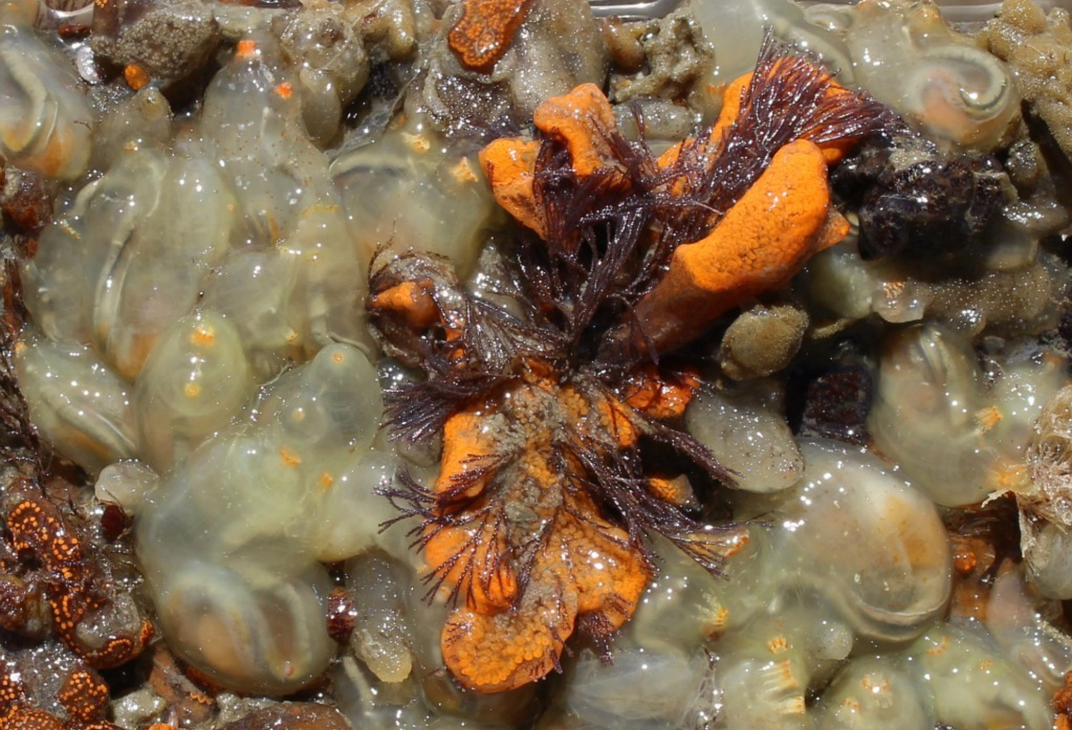
Under the Sea
Researchers use a variety of technologies to learn about marine life and inform conservation efforts. Take, for example, Beluga Bits , a research project focused on determining the sex, age and pod size of beluga whales visiting the Churchill River in northern Manitoba, Canada. With a bit of training, volunteers can learn how to differentiate between a calf, a subadult (grey) or an adult (white)—and even identify individuals using scars or unique pigmentation—in underwater videos and images. Beluga Bits uses a “ beluga boat ,” which travels around the Churchill River estuary with a camera underneath it, to capture the footage and collect GPS data about the whales’ locations.
Many of these online projects are visual, but Manatee Chat needs citizen scientists who can train their ear to decipher manatee vocalizations. Researchers are hoping to learn what calls the marine mammals make and when—with enough practice you might even be able to recognize the distinct calls of individual animals.
Several groups are using drone footage to monitor seal populations. Seals spend most of their time in the water, but come ashore to breed. One group, Seal Watch , is analyzing time-lapse photography and drone images of seals in the British territory of South Georgia in the South Atlantic. A team in Antarctica captured images of Weddell seals every ten minutes while the seals were on land in spring to have their pups. The Weddell Seal Count project aims to find out what threats—like fishing and climate change—the seals face by monitoring changes in their population size. Likewise, the Año Nuevo Island - Animal Count asks volunteers to count elephant seals, sea lions, cormorants and more species on a remote research island off the coast of California.
With Floating Forests , you’ll sift through 40 years of satellite images of the ocean surface identifying kelp forests, which are foundational for marine ecosystems, providing shelter for shrimp, fish and sea urchins. A project based in southwest England, Seagrass Explorer , is investigating the decline of seagrass beds. Researchers are using baited cameras to spot commercial fish in these habitats as well as looking out for algae to study the health of these threatened ecosystems. Search for large sponges, starfish and cold-water corals on the deep seafloor in Sweden’s first marine park with the Koster seafloor observatory project.
The Smithsonian Environmental Research Center needs your help spotting invasive species with Invader ID . Train your eye to spot groups of organisms, known as fouling communities, that live under docks and ship hulls, in an effort to clean up marine ecosystems.
If art history is more your speed, two Dutch art museums need volunteers to start “ fishing in the past ” by analyzing a collection of paintings dating from 1500 to 1700. Each painting features at least one fish, and an interdisciplinary research team of biologists and art historians wants you to identify the species of fish to make a clearer picture of the “role of ichthyology in the past.”

Interesting Insects
Notes from Nature is a digitization effort to make the vast resources in museums’ archives of plants and insects more accessible. Similarly, page through the University of California Berkeley’s butterfly collection on CalBug to help researchers classify these beautiful critters. The University of Michigan Museum of Zoology has already digitized about 300,000 records, but their collection exceeds 4 million bugs. You can hop in now and transcribe their grasshopper archives from the last century . Parasitic arthropods, like mosquitos and ticks, are known disease vectors; to better locate these critters, the Terrestrial Parasite Tracker project is working with 22 collections and institutions to digitize over 1.2 million specimens—and they’re 95 percent done . If you can tolerate mosquito buzzing for a prolonged period of time, the HumBug project needs volunteers to train its algorithm and develop real-time mosquito detection using acoustic monitoring devices. It’s for the greater good!
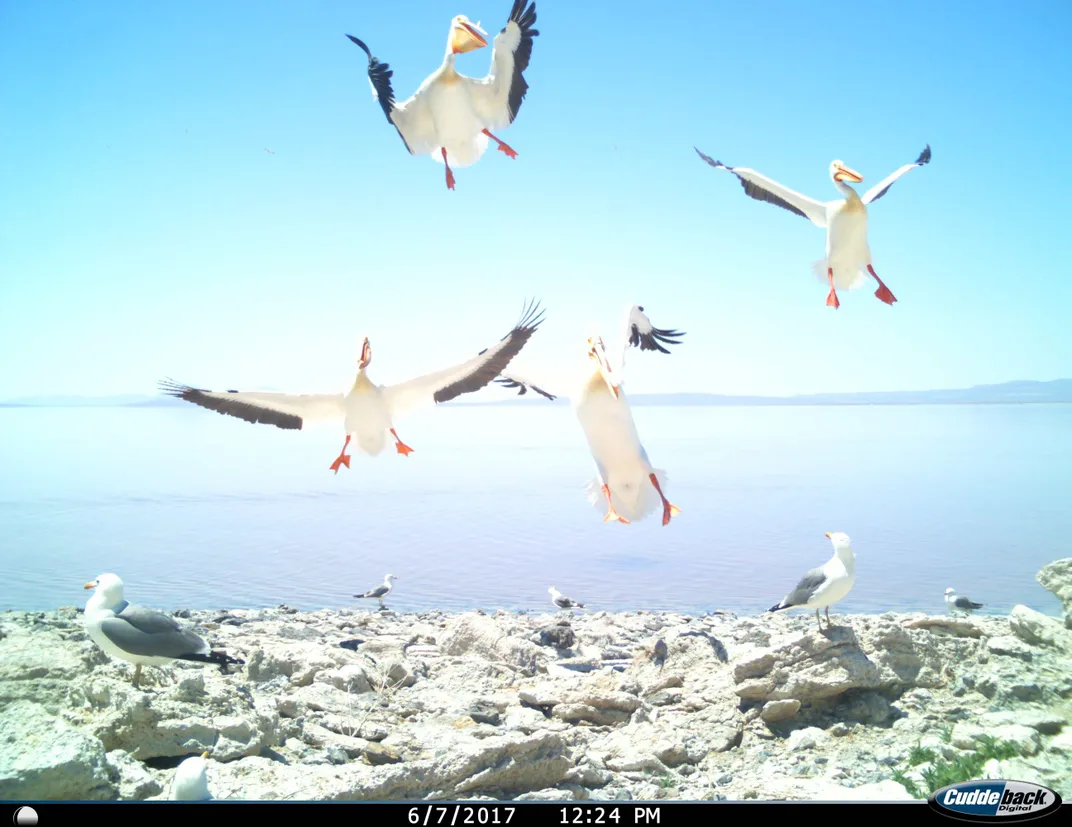
For the Birders
Birdwatching is one of the most common forms of citizen science . Seeing birds in the wilderness is certainly awe-inspiring, but you can birdwatch from your backyard or while walking down the sidewalk in big cities, too. With Cornell University’s eBird app , you can contribute to bird science at any time, anywhere. (Just be sure to remain a safe distance from wildlife—and other humans, while we social distance ). If you have safe access to outdoor space—a backyard, perhaps—Cornell also has a NestWatch program for people to report observations of bird nests. Smithsonian’s Migratory Bird Center has a similar Neighborhood Nest Watch program as well.
Birdwatching is easy enough to do from any window, if you’re sheltering at home, but in case you lack a clear view, consider these online-only projects. Nest Quest currently has a robin database that needs volunteer transcribers to digitize their nest record cards.
You can also pitch in on a variety of efforts to categorize wildlife camera images of burrowing owls , pelicans , penguins (new data coming soon!), and sea birds . Watch nest cam footage of the northern bald ibis or greylag geese on NestCams to help researchers learn about breeding behavior.
Or record the coloration of gorgeous feathers across bird species for researchers at London’s Natural History Museum with Project Plumage .
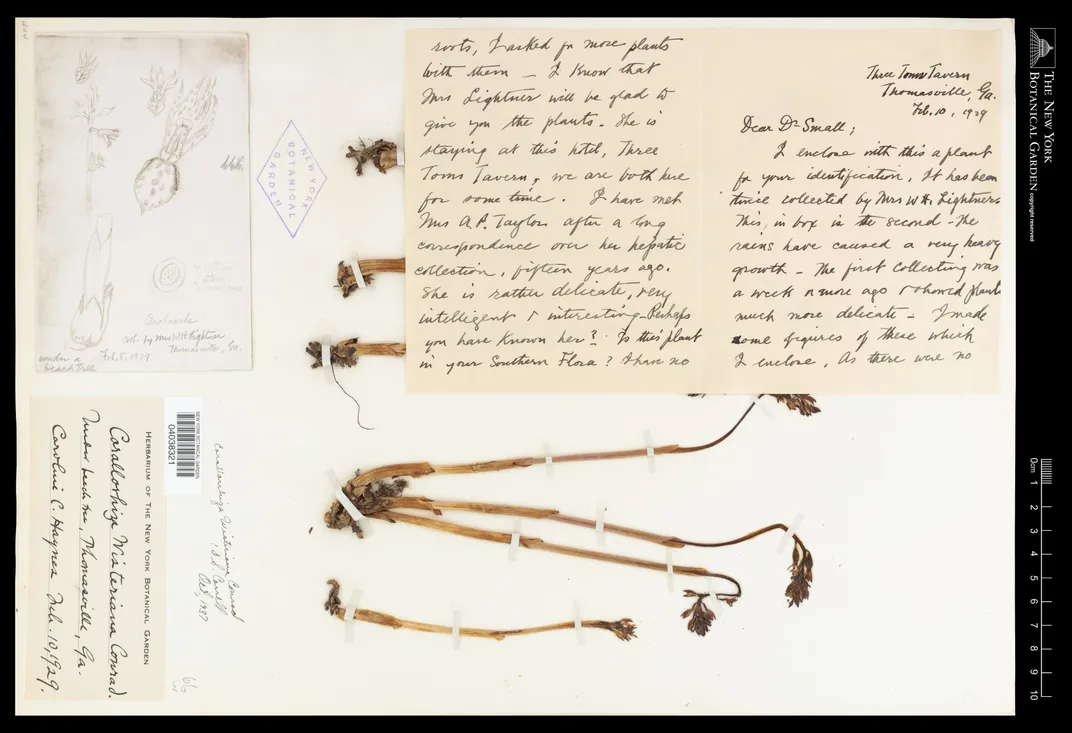
Pretty Plants
If you’re out on a walk wondering what kind of plants are around you, consider downloading Leafsnap , an electronic field guide app developed by Columbia University, the University of Maryland and the Smithsonian Institution. The app has several functions. First, it can be used to identify plants with its visual recognition software. Secondly, scientists can learn about the “ the ebb and flow of flora ” from geotagged images taken by app users.
What is older than the dinosaurs, survived three mass extinctions and still has a living relative today? Ginko trees! Researchers at Smithsonian’s National Museum of Natural History are studying ginko trees and fossils to understand millions of years of plant evolution and climate change with the Fossil Atmospheres project . Using Zooniverse, volunteers will be trained to identify and count stomata, which are holes on a leaf’s surface where carbon dioxide passes through. By counting these holes, or quantifying the stomatal index, scientists can learn how the plants adapted to changing levels of carbon dioxide. These results will inform a field experiment conducted on living trees in which a scientist is adjusting the level of carbon dioxide for different groups.
Help digitize and categorize millions of botanical specimens from natural history museums, research institutions and herbaria across the country with the Notes from Nature Project . Did you know North America is home to a variety of beautiful orchid species? Lend botanists a handby typing handwritten labels on pressed specimens or recording their geographic and historic origins for the New York Botanical Garden’s archives. Likewise, the Southeastern U.S. Biodiversity project needs assistance labeling pressed poppies, sedums, valerians, violets and more. Groups in California , Arkansas , Florida , Texas and Oklahoma all invite citizen scientists to partake in similar tasks.

Historic Women in Astronomy
Become a transcriber for Project PHaEDRA and help researchers at the Harvard-Smithsonian Center for Astrophysics preserve the work of Harvard’s women “computers” who revolutionized astronomy in the 20th century. These women contributed more than 130 years of work documenting the night sky, cataloging stars, interpreting stellar spectra, counting galaxies, and measuring distances in space, according to the project description .
More than 2,500 notebooks need transcription on Project PhaEDRA - Star Notes . You could start with Annie Jump Cannon , for example. In 1901, Cannon designed a stellar classification system that astronomers still use today. Cecilia Payne discovered that stars are made primarily of hydrogen and helium and can be categorized by temperature. Two notebooks from Henrietta Swan Leavitt are currently in need of transcription. Leavitt, who was deaf, discovered the link between period and luminosity in Cepheid variables, or pulsating stars, which “led directly to the discovery that the Universe is expanding,” according to her bio on Star Notes .
Volunteers are also needed to transcribe some of these women computers’ notebooks that contain references to photographic glass plates . These plates were used to study space from the 1880s to the 1990s. For example, in 1890, Williamina Flemming discovered the Horsehead Nebula on one of these plates . With Star Notes, you can help bridge the gap between “modern scientific literature and 100 years of astronomical observations,” according to the project description . Star Notes also features the work of Cannon, Leavitt and Dorrit Hoffleit , who authored the fifth edition of the Bright Star Catalog, which features 9,110 of the brightest stars in the sky.

Microscopic Musings
Electron microscopes have super-high resolution and magnification powers—and now, many can process images automatically, allowing teams to collect an immense amount of data. Francis Crick Institute’s Etch A Cell - Powerhouse Hunt project trains volunteers to spot and trace each cell’s mitochondria, a process called manual segmentation. Manual segmentation is a major bottleneck to completing biological research because using computer systems to complete the work is still fraught with errors and, without enough volunteers, doing this work takes a really long time.
For the Monkey Health Explorer project, researchers studying the social behavior of rhesus monkeys on the tiny island Cayo Santiago off the southeastern coast of Puerto Rico need volunteers to analyze the monkeys’ blood samples. Doing so will help the team understand which monkeys are sick and which are healthy, and how the animals’ health influences behavioral changes.
Using the Zooniverse’s app on a phone or tablet, you can become a “ Science Scribbler ” and assist researchers studying how Huntington disease may change a cell’s organelles. The team at the United Kingdom's national synchrotron , which is essentially a giant microscope that harnesses the power of electrons, has taken highly detailed X-ray images of the cells of Huntington’s patients and needs help identifying organelles, in an effort to see how the disease changes their structure.
Oxford University’s Comprehensive Resistance Prediction for Tuberculosis: an International Consortium—or CRyPTIC Project , for short, is seeking the aid of citizen scientists to study over 20,000 TB infection samples from around the world. CRyPTIC’s citizen science platform is called Bash the Bug . On the platform, volunteers will be trained to evaluate the effectiveness of antibiotics on a given sample. Each evaluation will be checked by a scientist for accuracy and then used to train a computer program, which may one day make this process much faster and less labor intensive.

Out of This World
If you’re interested in contributing to astronomy research from the comfort and safety of your sidewalk or backyard, check out Globe at Night . The project monitors light pollution by asking users to try spotting constellations in the night sky at designated times of the year . (For example, Northern Hemisphere dwellers should look for the Bootes and Hercules constellations from June 13 through June 22 and record the visibility in Globe at Night’s app or desktop report page .)
For the amateur astrophysicists out there, the opportunities to contribute to science are vast. NASA's Wide-field Infrared Survey Explorer (WISE) mission is asking for volunteers to search for new objects at the edges of our solar system with the Backyard Worlds: Planet 9 project .
Galaxy Zoo on Zooniverse and its mobile app has operated online citizen science projects for the past decade. According to the project description, there are roughly one hundred billion galaxies in the observable universe. Surprisingly, identifying different types of galaxies by their shape is rather easy. “If you're quick, you may even be the first person to see the galaxies you're asked to classify,” the team writes.
With Radio Galaxy Zoo: LOFAR , volunteers can help identify supermassive blackholes and star-forming galaxies. Galaxy Zoo: Clump Scout asks users to look for young, “clumpy” looking galaxies, which help astronomers understand galaxy evolution.
If current events on Earth have you looking to Mars, perhaps you’d be interested in checking out Planet Four and Planet Four: Terrains —both of which task users with searching and categorizing landscape formations on Mars’ southern hemisphere. You’ll scroll through images of the Martian surface looking for terrain types informally called “spiders,” “baby spiders,” “channel networks” and “swiss cheese.”
Gravitational waves are telltale ripples in spacetime, but they are notoriously difficult to measure. With Gravity Spy , citizen scientists sift through data from Laser Interferometer Gravitational-Wave Observatory, or LIGO , detectors. When lasers beamed down 2.5-mile-long “arms” at these facilities in Livingston, Louisiana and Hanford, Washington are interrupted, a gravitational wave is detected. But the detectors are sensitive to “glitches” that, in models, look similar to the astrophysical signals scientists are looking for. Gravity Spy teaches citizen scientists how to identify fakes so researchers can get a better view of the real deal. This work will, in turn, train computer algorithms to do the same.
Similarly, the project Supernova Hunters needs volunteers to clear out the “bogus detections of supernovae,” allowing researchers to track the progression of actual supernovae. In Hubble Space Telescope images, you can search for asteroid tails with Hubble Asteroid Hunter . And with Planet Hunters TESS , which teaches users to identify planetary formations, you just “might be the first person to discover a planet around a nearby star in the Milky Way,” according to the project description.
Help astronomers refine prediction models for solar storms, which kick up dust that impacts spacecraft orbiting the sun, with Solar Stormwatch II. Thanks to the first iteration of the project, astronomers were able to publish seven papers with their findings.
With Mapping Historic Skies , identify constellations on gorgeous celestial maps of the sky covering a span of 600 years from the Adler Planetarium collection in Chicago. Similarly, help fill in the gaps of historic astronomy with Astronomy Rewind , a project that aims to “make a holistic map of images of the sky.”
Get the latest Science stories in your inbox.
/https://tf-cmsv2-smithsonianmag-media.s3.amazonaws.com/accounts/headshot/rachael.png)
Rachael Lallensack | READ MORE
Rachael Lallensack is the former assistant web editor for science and innovation at Smithsonian .
Have a language expert improve your writing
Run a free plagiarism check in 10 minutes, generate accurate citations for free.
- Knowledge Base
- Starting the research process
A Beginner's Guide to Starting the Research Process

When you have to write a thesis or dissertation , it can be hard to know where to begin, but there are some clear steps you can follow.
The research process often begins with a very broad idea for a topic you’d like to know more about. You do some preliminary research to identify a problem . After refining your research questions , you can lay out the foundations of your research design , leading to a proposal that outlines your ideas and plans.
This article takes you through the first steps of the research process, helping you narrow down your ideas and build up a strong foundation for your research project.
Table of contents
Step 1: choose your topic, step 2: identify a problem, step 3: formulate research questions, step 4: create a research design, step 5: write a research proposal, other interesting articles.
First you have to come up with some ideas. Your thesis or dissertation topic can start out very broad. Think about the general area or field you’re interested in—maybe you already have specific research interests based on classes you’ve taken, or maybe you had to consider your topic when applying to graduate school and writing a statement of purpose .
Even if you already have a good sense of your topic, you’ll need to read widely to build background knowledge and begin narrowing down your ideas. Conduct an initial literature review to begin gathering relevant sources. As you read, take notes and try to identify problems, questions, debates, contradictions and gaps. Your aim is to narrow down from a broad area of interest to a specific niche.
Make sure to consider the practicalities: the requirements of your programme, the amount of time you have to complete the research, and how difficult it will be to access sources and data on the topic. Before moving onto the next stage, it’s a good idea to discuss the topic with your thesis supervisor.
>>Read more about narrowing down a research topic
Prevent plagiarism. Run a free check.
So you’ve settled on a topic and found a niche—but what exactly will your research investigate, and why does it matter? To give your project focus and purpose, you have to define a research problem .
The problem might be a practical issue—for example, a process or practice that isn’t working well, an area of concern in an organization’s performance, or a difficulty faced by a specific group of people in society.
Alternatively, you might choose to investigate a theoretical problem—for example, an underexplored phenomenon or relationship, a contradiction between different models or theories, or an unresolved debate among scholars.
To put the problem in context and set your objectives, you can write a problem statement . This describes who the problem affects, why research is needed, and how your research project will contribute to solving it.
>>Read more about defining a research problem
Next, based on the problem statement, you need to write one or more research questions . These target exactly what you want to find out. They might focus on describing, comparing, evaluating, or explaining the research problem.
A strong research question should be specific enough that you can answer it thoroughly using appropriate qualitative or quantitative research methods. It should also be complex enough to require in-depth investigation, analysis, and argument. Questions that can be answered with “yes/no” or with easily available facts are not complex enough for a thesis or dissertation.
In some types of research, at this stage you might also have to develop a conceptual framework and testable hypotheses .
>>See research question examples
The research design is a practical framework for answering your research questions. It involves making decisions about the type of data you need, the methods you’ll use to collect and analyze it, and the location and timescale of your research.
There are often many possible paths you can take to answering your questions. The decisions you make will partly be based on your priorities. For example, do you want to determine causes and effects, draw generalizable conclusions, or understand the details of a specific context?
You need to decide whether you will use primary or secondary data and qualitative or quantitative methods . You also need to determine the specific tools, procedures, and materials you’ll use to collect and analyze your data, as well as your criteria for selecting participants or sources.
>>Read more about creating a research design
Finally, after completing these steps, you are ready to complete a research proposal . The proposal outlines the context, relevance, purpose, and plan of your research.
As well as outlining the background, problem statement, and research questions, the proposal should also include a literature review that shows how your project will fit into existing work on the topic. The research design section describes your approach and explains exactly what you will do.
You might have to get the proposal approved by your supervisor before you get started, and it will guide the process of writing your thesis or dissertation.
>>Read more about writing a research proposal
If you want to know more about the research process , methodology , research bias , or statistics , make sure to check out some of our other articles with explanations and examples.
Methodology
- Sampling methods
- Simple random sampling
- Stratified sampling
- Cluster sampling
- Likert scales
- Reproducibility
Statistics
- Null hypothesis
- Statistical power
- Probability distribution
- Effect size
- Poisson distribution
Research bias
- Optimism bias
- Cognitive bias
- Implicit bias
- Hawthorne effect
- Anchoring bias
- Explicit bias
Is this article helpful?
Other students also liked.
- Writing Strong Research Questions | Criteria & Examples
What Is a Research Design | Types, Guide & Examples
- How to Write a Research Proposal | Examples & Templates
More interesting articles
- 10 Research Question Examples to Guide Your Research Project
- How to Choose a Dissertation Topic | 8 Steps to Follow
- How to Define a Research Problem | Ideas & Examples
- How to Write a Problem Statement | Guide & Examples
- Relevance of Your Dissertation Topic | Criteria & Tips
- Research Objectives | Definition & Examples
- What Is a Fishbone Diagram? | Templates & Examples
- What Is Root Cause Analysis? | Definition & Examples
Get unlimited documents corrected
✔ Free APA citation check included ✔ Unlimited document corrections ✔ Specialized in correcting academic texts
Research at Home: How to Approach a Scientist Virtually
In this time of social distancing, many scientists have found ways to transition their research home, just like students with science research projects. Since much of their work is now taking place virtually, this is the perfect opportunity to find a scientist anywhere in the country who may be able to help you with your project.
How a Scientist Could Help with Your Research
A professional scientist could be helpful to your science research projects in a number of ways, including:
- Explaining scientific concepts that are involved in a specific area of research
- Pointing out potential project topics in their subject area
- Giving feedback on your research question and procedure
- Identifying variables that must be controlled in your experiment
- Reviewing your background research to ensure you have not missed key findings
- Recommending what materials and equipment would be best to use for a project and facilitating access to those resources
- Introducing you to other scientists who could also help mentor you
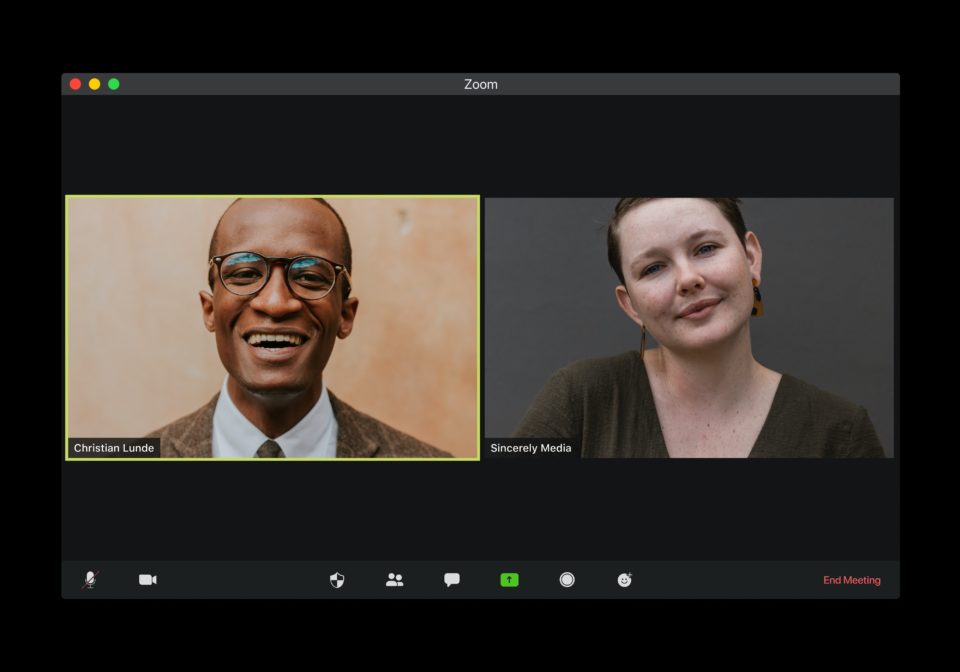
Before you reach out to a scientist for help, we recommend reviewing the tips below.
Obtaining parent/guardian permission.
If you are under 18, you should obtain parent/guardian permission before you begin searching for and reaching out to potential mentors. Ask your parent or guardian if they would like to be copied on email communication or be included on phone calls and keep them informed on all your interactions.

Identifying Potential Scientists
Finding a scientist to reach out to is the first important step to connecting with someone who can help you to learn and grow. Find out more about how to identify the right scientist .
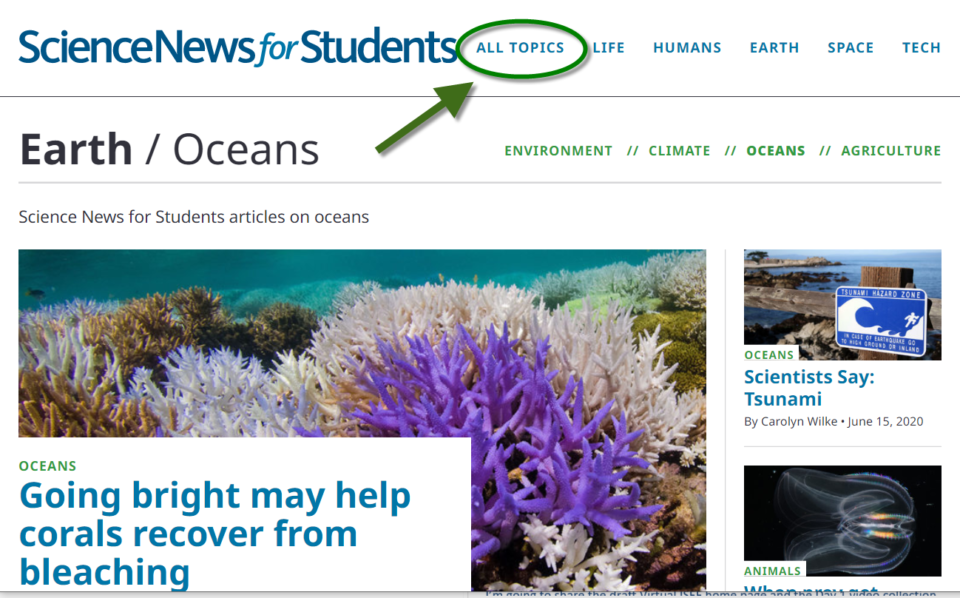
Contacting a Scientist
If you hope that a scientist will take your request for help seriously, you’ll want to ensure that your request appears professional. Learn about the proper way to go about reaching out .
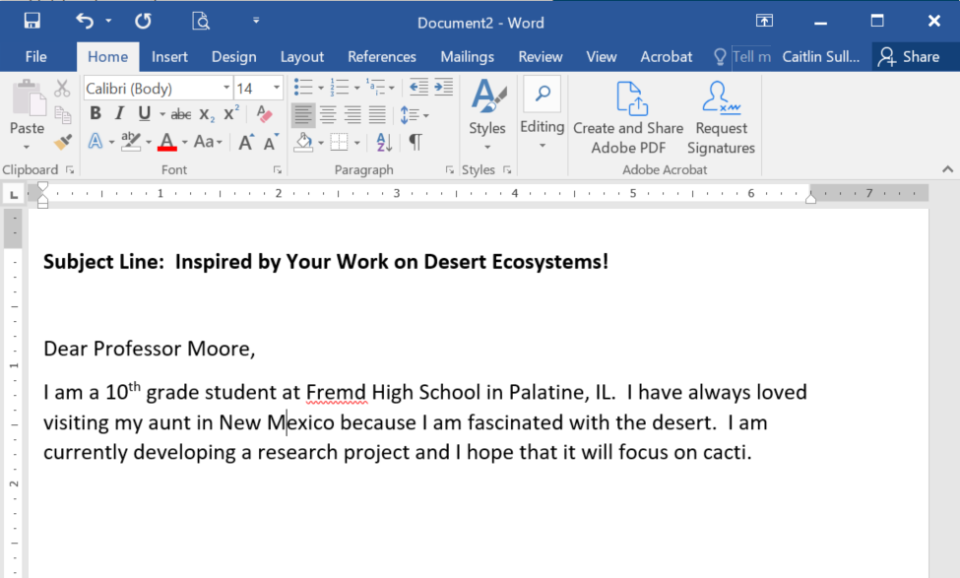
Preparing for the Conversation
Receiving a positive response from a scientist is exciting, but preparing for the conversation is equally important. Here are some tips:
- Rather than asking, “What should my research topic be?” it would be better to have at least 2-3 project ideas ready to share. Then you can ask if they have other recommendations.
- Review their biography and research again so that you do not ask questions that are answered online.
- Could I call you again in the future if I have any questions?
- Might you be willing to look over my procedure once I have fully developed it?
- Do you have any graduate or undergraduate students in your lab that might be willing to speak to me about their experiences in research?
- Find a quiet place for your call, where you will not be interrupted. Make sure you have allotted an hour in your schedule, even though you should expect the call to last about 10-20 minutes. If a scientist wants to talk longer, it is courteous to have that time available
- Have paper nearby or a document open where you can take notes.

Following up with a Thank You Message
If you do connect with a scientist, even for a brief email exchange or phone call, it is important to follow up as soon as possible with a thank you message. It is a good idea to send this message as soon as your interaction has taken place, so that you do not forget and the conversation is fresh in your mind.
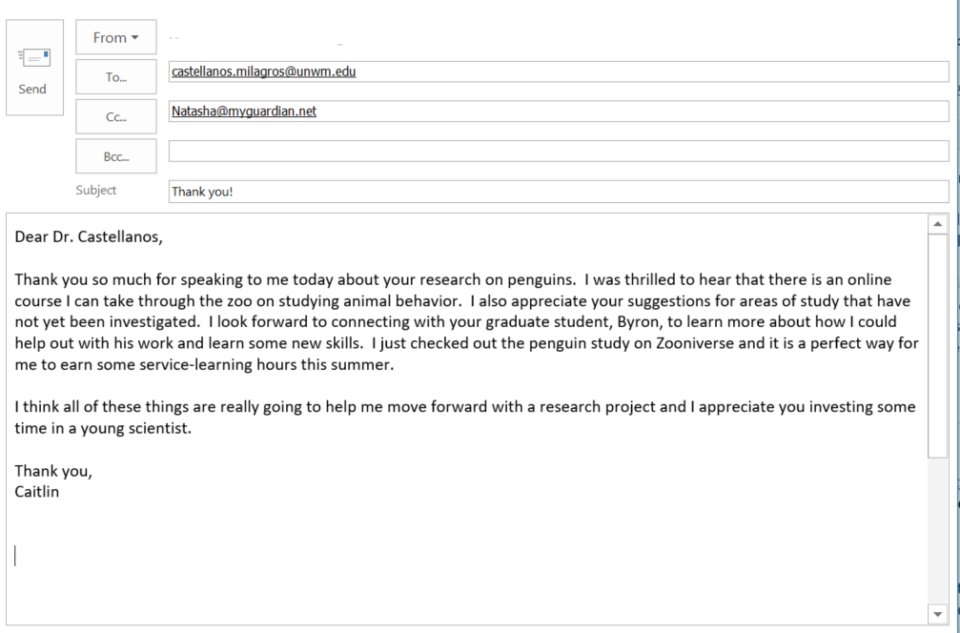
How to Research: Ultimate Guide [+Online Tools]

The ability to effectively research is a skill that every student needs to succeed in their educational career. However, most people don’t really understand what research entails. Does it mean spending hours at your university library exploring archives? Or is searching for information online from the comfort of your home enough? And why can’t you just rely on Wikipedia, after all?
Our specialists have created this guide for students who feel lost when putting together an essay, paper, or presentation. Here, we will describe how to research in a detailed, step-by-step manner. We have also provided links to useful tools and resources that will help you along the way. First of all, let’s cover the definitions.
❓ What Is Research?
- Develop a Topic
- Look Through Sources
- Evaluate the Sources
- Write Your Paper
- Cite Your Sources
💡 9 Online Tools for Research
Research refers to the systematic process of discovering information and developing knowledge. We use it to understand new topics and to gain more insight into known issues. This happens through the collection and analysis of relevant data. The ability to research efficiently is one of the most fundamental skills in academia.
Any type of research will include the following features:
- A sound hypothesis on which the rest of the study is based. It will be either proven or disproven by the evidence gathered.
- Systematic investigative methods . These are controlled and follow a pre-established set of rules.
- Logical analysis . It follows a set procedure that involves deductive and inductive reasoning.
- Empirical data based on actual observation and evidence.
- Analytical study of the findings . This ensures in-depth exploration and minimizes mistakes.
- Creation of new questions and new lines of inquiry about the subject via the research.
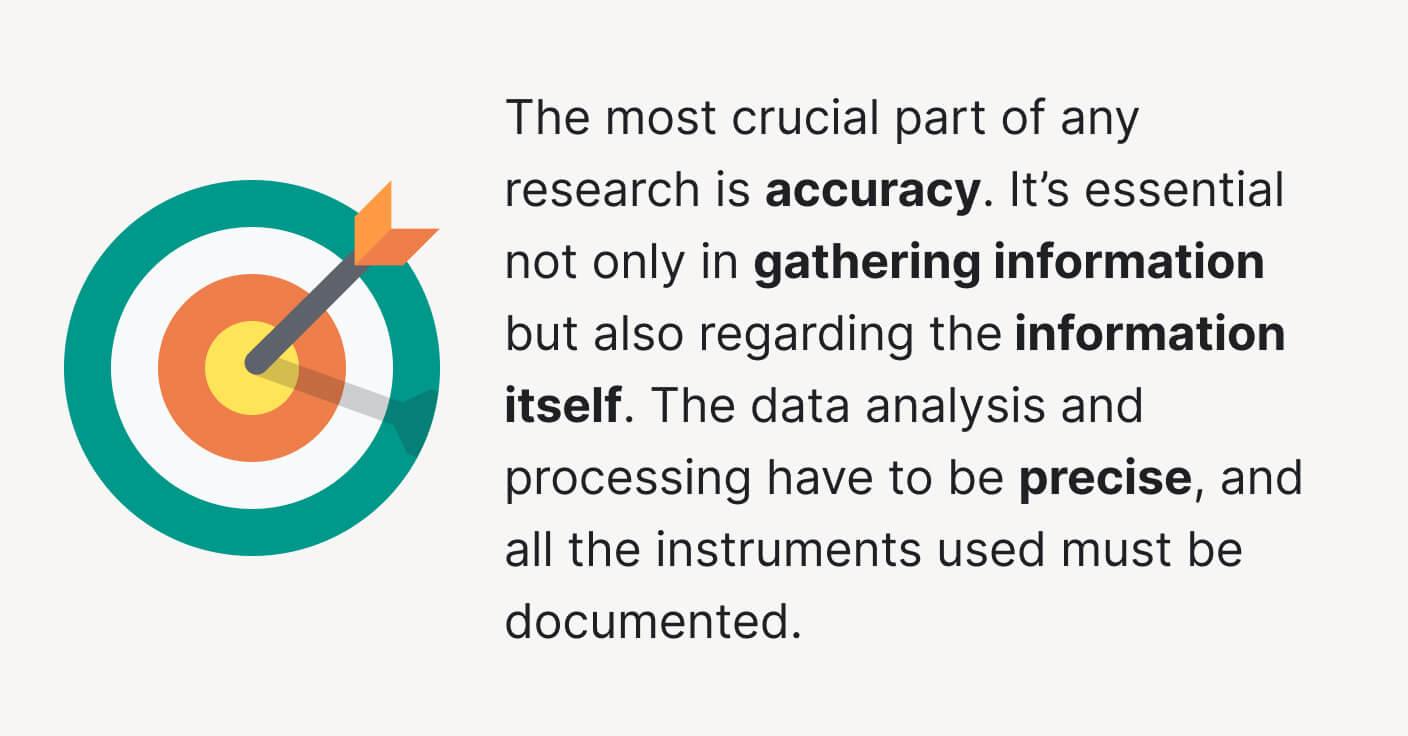
With that being said, a research paper is more than just the sum of its sources. Its primary purpose is to analyze or argue a particular perspective. In the end, your thoughts and ideas should be the ones you investigate. The evidence you discover during the research process will be the basis for your hypothesis.
There are three universal purposes of research that you should know about:
| 1. | Exploratory | A problem that hasn’t been investigated before and isn’t clearly defined requires . This is the first step in laying the foundation for future, in-depth study. It requires an unstructured approach and posits several questions for the researchers to answer. |
| 2. | Descriptive | With a focus on an existing problem, tries to expand our knowledge of the subject matter. It aims to define, explain, and confirm results. This type of research asks the questions ‘what’ and ‘how.’ |
| 3. | Explanatory | Also known as , the goal here is to look at the cause-and-effect relationship between variables. The main question in this type of research is ‘why.’ That is why it is usually approached with experiments. |
📚 How to Research: Step-by-Step Guide
As all the definitions you need are covered, we can proceed to learn about the process itself. We have developed this guide so that you won’t have any trouble conducting your research. In the image below, you can see all the required steps.
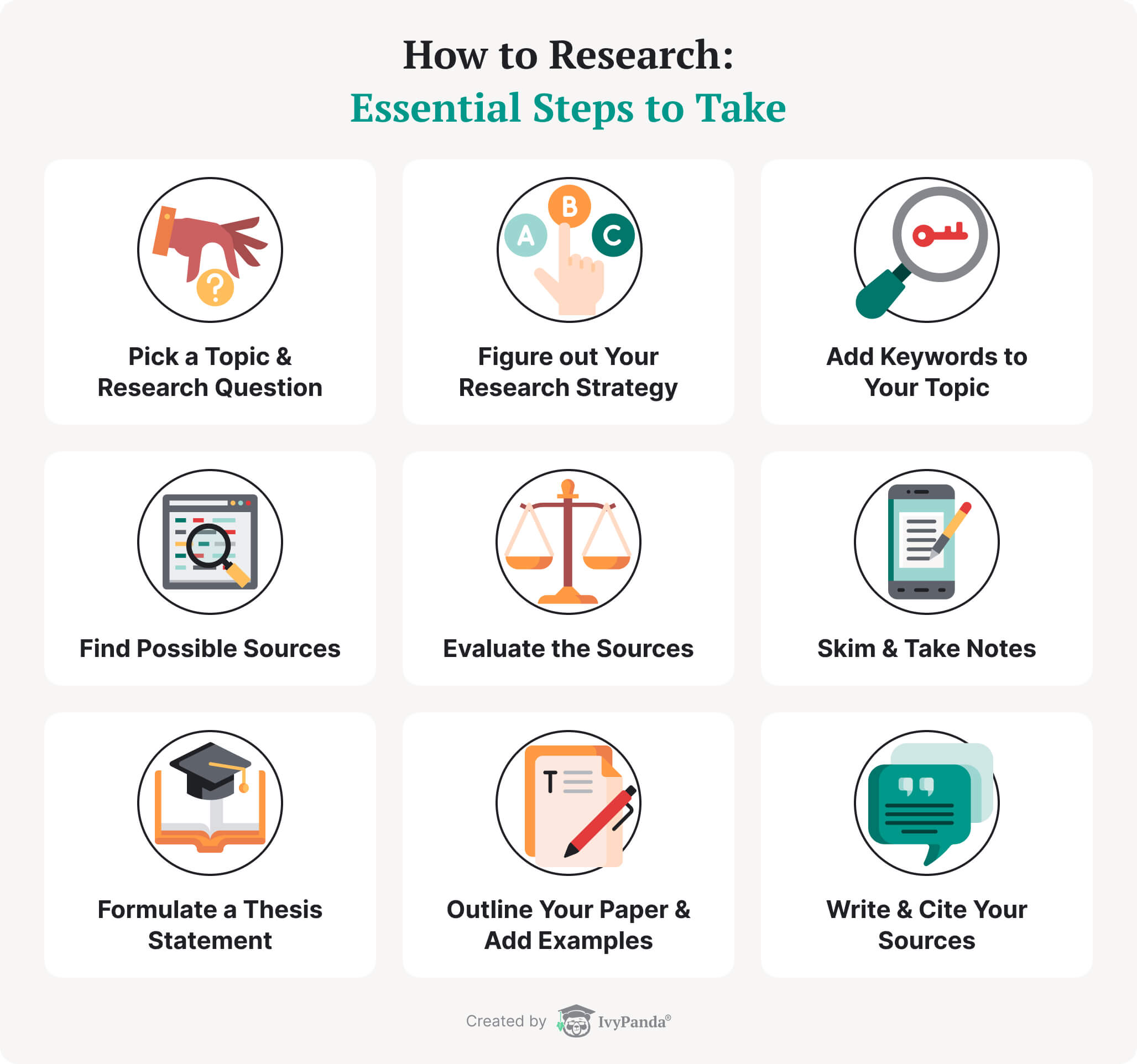
In the following sections, you will examine each step in detail. Also, you’ll see the reasons why our tips are practical and how to find sources for your research. Good luck!
1. Develop a Topic
1.1. pick or create a topic.
The first step to research is landing on the right idea. This process isn’t always easy, especially when you aren’t familiar with the chosen area of study. However, don’t fret. You can always change your topic later.
Let’s explore how to select your first research idea.
Research is always conducted for a particular reason. It will always relate to writing a paper, creating a project, validating existing results, etc. Your research depends on the goal of your assignment.
The answers will help you define the direction of your work:
- Do you have a list of pre-assigned topics? Can you come up with one yourself?
- What is the due date for your work? How much time does that leave for research?
- What is the scope of your assignment? (Presentation length, number of words/pages, etc.)
- Are there any specific requirements regarding the sources that you are allowed to use?
- Is it essential to use recent information and current sources?
When you have the answers to all the key questions, you can think of your topic. The following tips will help you:
- Choose an idea that is relevant to your assignment. Usually, your instructor will give you detailed instructions before you start working. If you are unsure about your guidelines, don’t be afraid to ask for clarification.
- Ensure that there are enough resources for you to use. When you think of an idea, do a quick preliminary search. It will allow you to determine whether there is enough available information on your topic. Take time to validate those resources and make sure they’re reliable.
- Search for a topic that is not too broad or too narrow. This step directly correlates with the one above. If you are finding too much general information, narrowing down your search might be a good idea. However, if you struggle to find credible sources, it could be a sign to broaden your topic.
- Try to be original. Restating the same ideas that have been explored thousands of times could damage your grade. Chances are, your instructor has heard it all before and isn’t all that interested in hearing it again. Yet, choosing an unconventional approach with a fresh perspective might earn you extra credit for creativity.
- Aim to find an area that will be interesting to explore. If you find a topic that you, personally, are curious about, researching it will be much more pleasant. This way, when you start writing or searching for information, you might actually enjoy the process.
1.2. Formulate Research Questions
As soon as you have chosen a topic, take the time to format it correctly. Wording it as a question will ensure that your focus is precise and nuanced.

And here is how you create research questions:
Step 1 : Do some research.
Take a look at the most recent discussions and debates on your selected topic. You can check out academic journals and scholarly conferences. Keep your focus on the main arguments to acquaint yourself with the concepts.
Step 2 : Try narrowing down your topic.
It is a lot more effective to target a single dimension of a broader topic than to tackle everything. To do this, try focusing on a particular aspect, such as a specific location or time period. You can also aim to discuss certain debates or issues that exist within the topic.
Step 3 : Keep your audience in mind.
There is a difference between crafting a presentation for your classmates and writing a research paper. Your audience will determine the level of detail that goes into your question.
Step 4 : Ask questions.
Once you have considered the above steps, it is time to begin asking yourself questions. Make sure they’re open-ended and start with ‘why,’ ‘how,’ or ‘what.’
Step 5 : Evaluate your questions.
After you come up with a couple of ideas, jot them down on paper. Look back at all the requirements for a successful research question. Which one of them will be the most effective for your assignment?
1.3. Choose a Research Strategy
To develop constructive research questions, you will need to conduct an initial survey of your resources. Take everything you’ve learned so far as your foundation. Now, you will need to create an efficient strategy for your further actions.
Your research strategy will depend on the following:
| Time | It will dictate which resources you should focus on. If your time is limited, concentrate on gathering data on the web and in your library. However, if your deadlines aren’t as strict, consider conducting first-hand research. |
| Type of Project | It will determine the depth of your research. Note the guidelines given by your tutor – do you have any limitations? Ensure that you’re not going over or under the margins specified. |
| Type of Data | It will define the approach to your topic. Think about whether you need facts and statistics or opinions about particular debates. |
| Type of Sources | They will provide the context for your work. Reflect on what you are trying to achieve with your research. Perhaps it would benefit from the use of primary sources. |
1.4. Figure out Keywords
With your research questions, strategy, and some background info covered, it will be easier to determine the keywords . They will help you look for resources and locate your work in the future. Over here, see how to work with keywords.
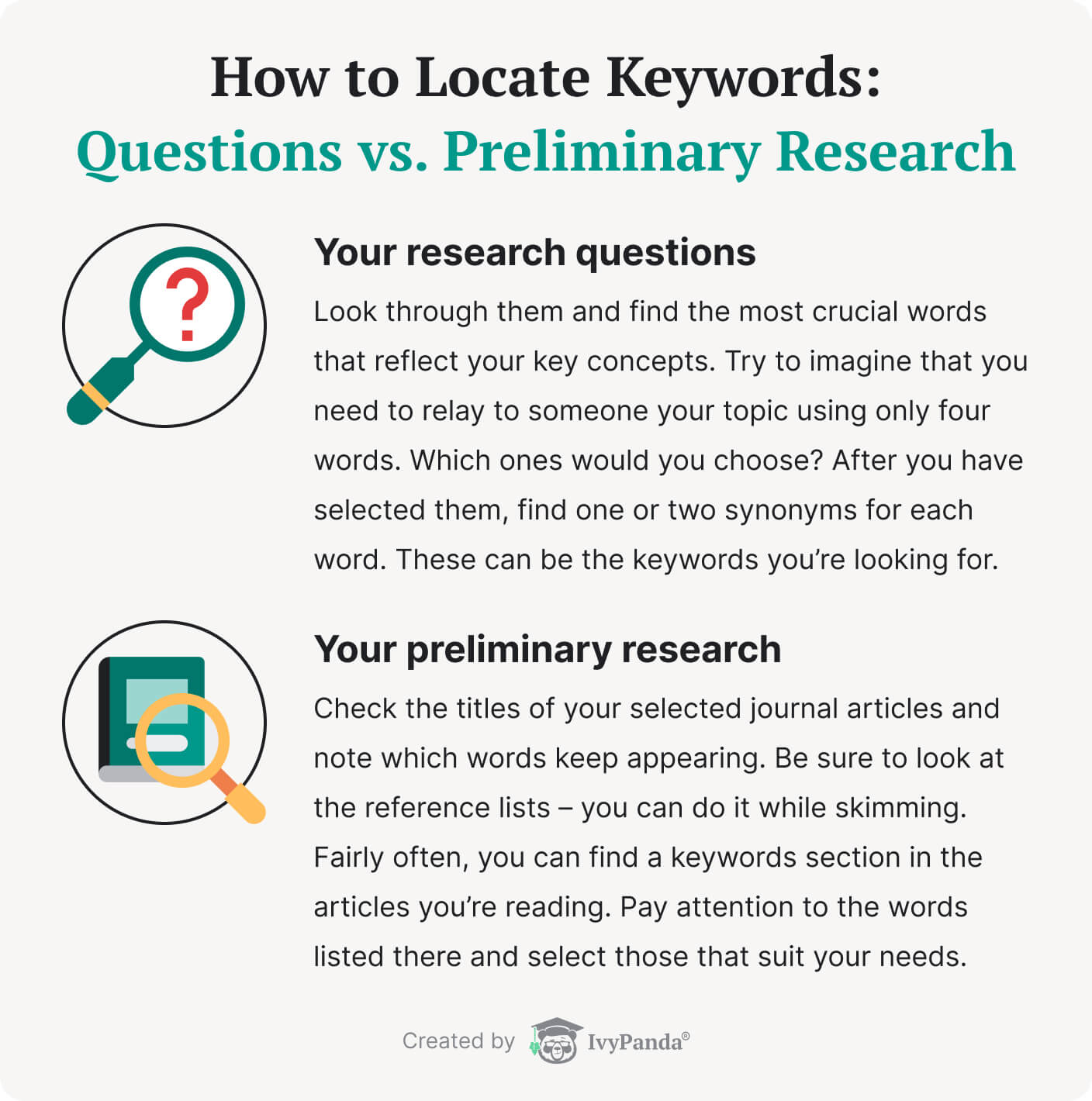
Once you have a selection of keywords, you can improve them by doing the following:
- Break them into related concepts. By the end, you should have four or five columns with associated keywords.
- Choose one keyword from each column. Use your library’s search engine to look them up. Don’t forget to type ‘AND’ in-between the words. It will narrow down the search so that only articles containing all the selected keywords will appear.
- Explore the results! Don’t be afraid to try several different combinations. You should also make sure to list all those keywords that bring you the most valuable results.
- If you don’t have enough results, try using fewer keywords. Alternatively, you can try to make your keywords broader.
- If you have too many results, try using more keywords. Alternatively, you can try to make your keywords narrower.
- Pay attention to which articles are the most relevant to your needs. Make sure to save them and skim them for a list of keywords. Write them down, and create a new list!
- Once you have exhausted your first list, you can create another one. Run another search following these steps. Don’t forget to note down the relevant materials – you’ll need them for your citations!
1.5. Improve Your Topic
As we mentioned above, you can change and refine your topic as many times as you need before you begin writing. That is why in this section, we will talk about how to polish and improve your idea. At the very least, we’ll give you tips on how to format it correctly.
First of all, we need to make sure that your topic is researchable. To accomplish this, answer the 5 ‘w’ questions :
- Why are you choosing this particular topic? How is it interesting or different from the rest? What is your stance on the matter?
- What are the main issues your topic is trying to explore? Is it controversial? What other opinions and questions exist on the subject?
- Who is talking about the topic? What points of view exist, and who is giving them? What is their agenda?
- When was this topic discussed? Is the issue recent or historical? Does the time frame matter?
- Where lays the importance of your topic? Is it debated on an international, national, or local level? Is there a particular place that is more affected than the rest of the world?
After answering these questions, you need to evaluate your idea from these two perspectives:
- Is your topic too broad?
It may happen if you find far too much information on the subject that doesn’t seem relevant. You will want to narrow it down and include some specifics, such as:
- Place (country, city, street, part of the world, etc.);
- Time (year, era, century, etc.);
- Populace (ethnicity, gender, age, occupation, etc.);
- Event or characteristic (historical occurrence, institutional perspective, etc.);
- Individual or group (a particular point of view, specific person or persons, etc.).
- Is your topic too narrow?
If you are discovering too few sources to build a proper case, your topic is too narrow. Try to broaden it using the following methods:
- Remove some of the specifics (place, time, populace, etc.).
- Expand some of the specifics (place, time, populace, etc.).
- Use synonyms to reword your topic.
- Look in other databases to broaden your horizons.
- Consider looking into a less current issue (the newer an idea is, the harder it is to find sources).
2. Look Through Sources
2.1. determine possible sources.
By this time, you most probably looked for background information on your topic a couple of times. Now it’s time to look for more specific info.
For starters, get the keywords you’ve chosen and see if there is enough information available. You can start by checking appropriate titles in the online libraries. Look for sources in encyclopedias and dictionaries to overview what books or articles you can use.
You can use the following websites for this purpose:
- Oxford English Dictionary
- Wordreference.com
- Encyclopedia Britannica Online
- Oxford Reference Online
Apart from encyclopedias and dictionaries, there are, of course, other places you can check. For instance, you can search for books in your local or university library . When you look through the text on the shelf, pay attention to the books nearby – they can become useful too in the subject area.
Additionally, you can find information in your textbooks and assigned readings. Use your library’s electronic databases that keep magazines and newspapers on the topic. In case you are not sure how to do that, ask your librarian. Also, use search engines to locate materials on the Internet. These types of sources will be helpful when looking for generic information.
2.2. Skim Some Books
When it comes to using books for your research, both hard and electronic copies work as well. In this section, we will tell you how to use them for your research.
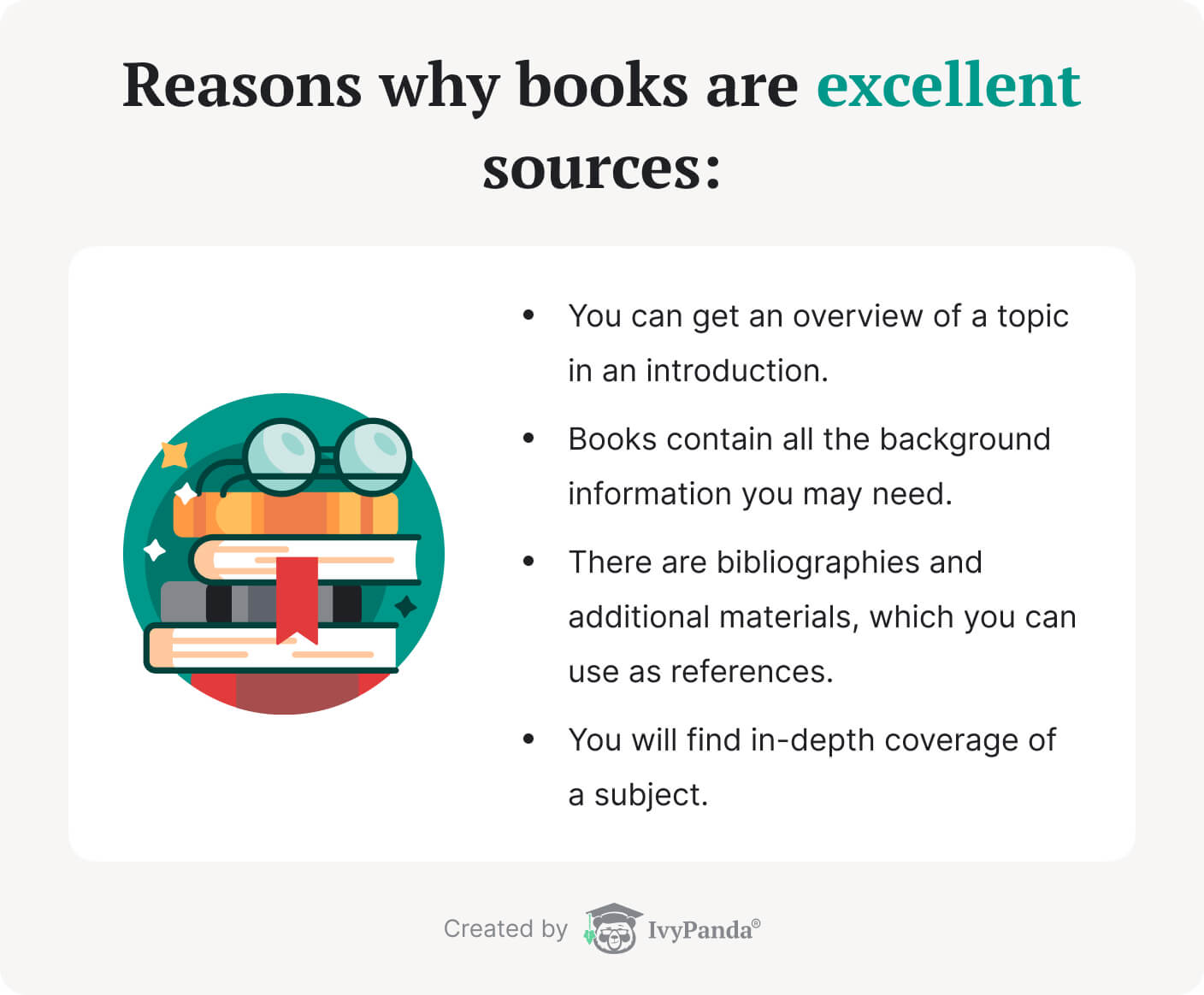
If you are a student, you probably do not have time to read every single book. When working on a short paper, essay, or presentation with limited time, you are simply looking for citations. Luckily, there is no need to waste your time examining each book thoroughly. Skimming is enough to understand if the source works for you or not.
To get the needed information in the book, look at the following elements:
- Title Page. There, you can find all the essential details about the book, the author’s name, title, the publisher’s name, the date of publication, etc.
- Table of Contents. This part provides you with a list of all the chapters in the book. You can get a general idea of what topics the author covered.
- List of Illustrations. In some books, authors use illustrations, tables, drawings to support the arguments and the facts. Looking through them can help you see the stats or some other facts quickly.
- Preface or Introduction. Usually, this part of the book provides the author’s intentions and the purpose of the book. Read it to see whether the book’s topic is necessary for your research.
- Bibliography. This part of the book provides a list of materials that the author used. You can check the bibliography for additional resources or references.
- Index. Skimming an index is excellent for identifying where the relevant information is located in the book. It can also give you some additional keywords that might be helpful for your research.
How to Find Books: Free Resources
You can find paperback books in your school’s library or ask your professor if he can lend you some helpful resources. To look for ebooks, we recommend using one of the following services:
| It is an open library catalog through which you can read and borrow more than 3 million books. | |
| It is a service from Google Inc for full-text books. Google claims that it has over 40 million scanned books. | |
| Internet Archive is a free online library of millions of books, movies, software, music, etc. | |
| It is one of the oldest digital libraries. It stores almost 50,000 ebooks in various formats. | |
| WorldCat is an online library catalog. It allows you to look up dissertations, books, essays, journals, and multimedia worldwide. |
For more free books and textbooks, check out the list of online learning resources for different subjects.
2.3. Find Relevant Articles
Scholarly articles are essential parts of every research. Even small argumentative essays usually contain citations from these resources. Here, we will explain how to work with them.
But first, you have to understand how to differentiate based on where these articles are being published. There are two types:
- Peer-reviewed journals
These journals include articles written by an expert in the field. Another expert (experts) read the article and provided feedback. Thus, the author implemented the needed changes based on the review.
- Scholarly journals
Experts write articles for these journals. They address the papers to other academics in the same field. Usually, scholarly journals are written by professional associations or academic press.
Usually, students can use academic and scholarly journals interchangeably. However, you should ask your instructor to explain if sources called “academic” are acceptable.
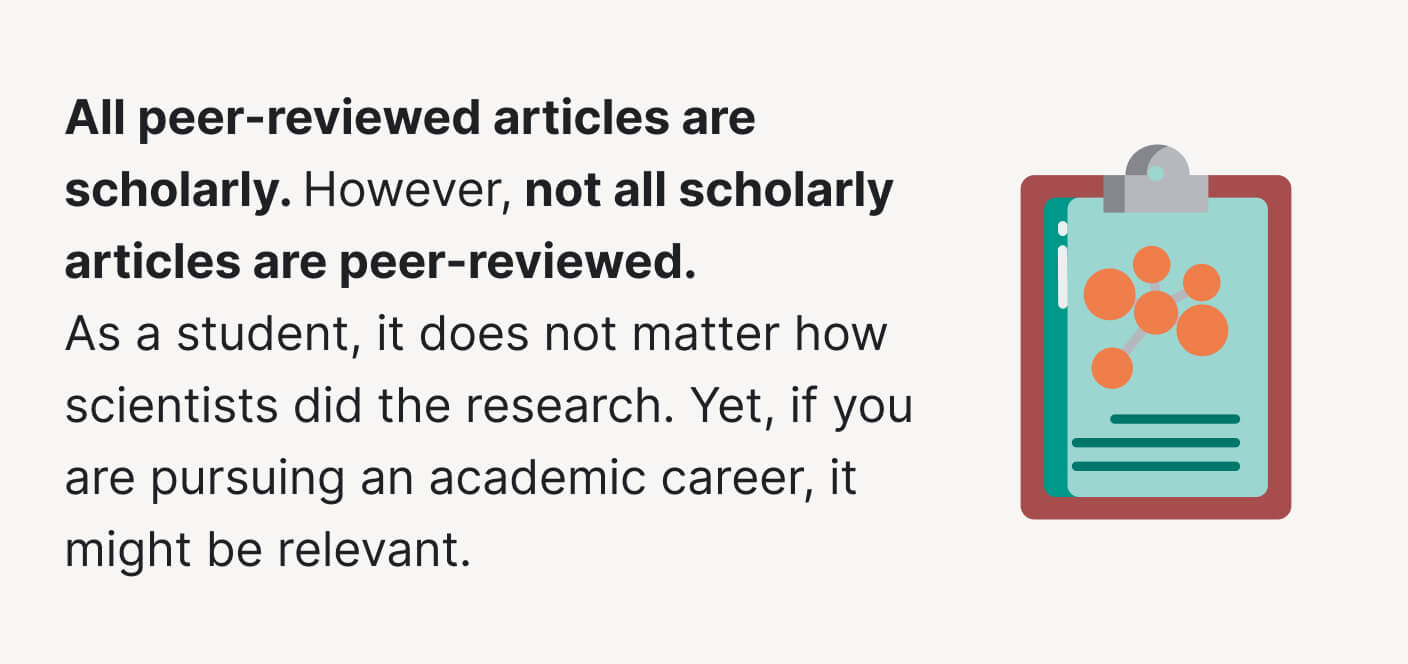
Not to read every single piece of writing, you need to learn how to identify if the article is credible or not. For that, pay attention to the following elements:
- Author. Look out for the author’s degrees and credentials. Additionally, see if they are a member of any association or work at a university or official organization.
- Intended audience. Understanding the article’s aim is essential. If the author intends to entertain and inform the general public, it may not be the best source for a student. You can still read and learn from without citing.
- Publication type. Some of the ways to recognize the type are:
- Go online and read the sections’ “aims and scope.”
- Check the visual appearance. If the article has colorful images and graphics, it is most probably written for the general public.
- Structure. You can also look at the length and formatting of the article. If it has a clear organization with headings, then most probably, the piece is scholarly. Same with the size. Short papers (with less than five pages) in general are likely to be not academic articles.
- Style. Examine the language, the point of view, and the tone of the article. If the document has many technical terms and professional jargon, then it is usually scholarly or peer-reviewed. Ask yourself what level of education one needs to comprehend the text entirely.
If all of the following parameters fit your expectations, you can only start by reading and analyzing the article.
How to Find Articles: Free Resources
Not sure where to look for articles? Check the following resources that our team recommends:
| Google Scholar is a web search engine that indexes most peer-reviewed journals, books, abstracts, theses, and dissertations. The goal behind this engine is to make access to scientific knowledge more efficient. It also has a citation analysis tool. | |
| WWS is a global science search engine that looks for articles and scientific papers across more than 100 databases. It is partially free and multilingual. | |
| Microsoft Academic is a web search for scientific knowledge. You look for any topic, author, journal, or combination of the following on the website. Microsoft Academic is entirely free. | |
| ScienceOpen is a complete end-to-end publishing solution that has over 50 million articles and records. It provides a wide range of tools to researchers for free. | |
| RG is a European social networking website for scientists and researchers. You don’t have to register to read articles. Yet, you need to have an email affiliated with one of the recognized institutions to become a site member. | |
| It is a search engine designed for teachers, students, and those doing home school programs. Librarians created it using Google custom search. | |
| The CORE is a service provided by the Knowledge Media Institute. The aim is to gain open access to different systems as it works closely with digital libraries. CORE claims that it is the world’s largest aggregator of open access research papers. | |
| ERIC is an online library of education research and information. The U.S. Department of Education sponsors it. This library is free of charge and has a lot of filters for the most accurate search results. |
2.4. Examine Useful Databases
If you still don’t know what sources to use, you can study databases. These collections contain many high-quality books and articles and conference presentations, video lectures, illustrations, etc. In this section, see how to use them and how to benefit from doing this.
A database is a collection of stored and structured information, usually controlled by a dates management system (DBMS). Information is generally modeled in rows and columns in different tables. Thus, even your university’s online library can be considered a database.

Here are some crucial tips on using databases:
- AND ➡️ when you want to use both terms.
- OR ➡️ when you can choose either time.
- NOT ➡️ when you want to exclude words.
- Type asterisks, exclamation points, and questions marks. If you don’t use asterisks and wildcards, some databases will not provide the search you need. They are also beneficial in making your search more specific.
- Look out for the “subject search” option. This way, you will search for information located on the heading field. It is possible due to a system called controlled vocabulary .
- Improve your keywords. Try to be creative with your key phrases and words. Look for all the possible ways to express your topic by using synonyms and associated concepts.
- Try using parentheses . When you look for complex queries, use parentheses. They will allow you to group terms together.
- Search for clues. Carefully look for tips and hints in the results. Analysis of the trends, indications, and numbers can help you understand the information better.
- Check the stacks . Stacks are linear data structures that follow a specific pattern. As collections of elements, they can help you with one particular search.
- Look through different databases. You can look across other databases and combine what you’ve found. The more data you will consider, the more precise your results are.
Free Databases to Use for Research
There are many open-access databases that you can use when conducting your research. Our experts previously mentioned a lot of those in the sections about ebooks and scholarly articles.
Here are some more databases that you can find to be helpful:
| DOAJ is a community-curated online journal. It provides access to high-quality, peer-reviewed journals. | |
| EThOS is a bibliographic database provided by the British Library. You can search across 500000+ works for free and access the full text. | |
| This one is a catalog provided by World Bank. It includes databases, tables, reports, and other resources. | |
| This database is provided by U.S. Government science agencies. It contains a search engine that will make your search effortless. | |
| SSRN is worldwide research that contains full-text academic papers. It is an open-access resource for subjects like accounting, economics, finance, law, etc. | |
| PLOS is a nonprofit organization that publishes research in medicine and science. It is peer-reviewed that publishes papers under creative commons licenses. |
We also recommend looking at the available open databases prepared by the University of California at Santa Barbara and Elmira College .
2.5. See Other Websites
Besides search engines and databases, there are other online resources that you can use as a starting point for your research. The only issue is that you might not know if the information is legit.
These websites are suitable for academic research:
- Educational sites (*.edu)
- Government sites (*.gov)
- News sites (CNN, NBC News, FOX News, etc.)
- Professional, nonprofit organizations (Unicef, WWF, etc.)
- General informative websites (Wikipedia)
Of course, you can use online resources for research. They are especially great when you’re looking for background information or defining the topic. Yet, one thing to keep in mind is to choose the websites and data from them carefully.
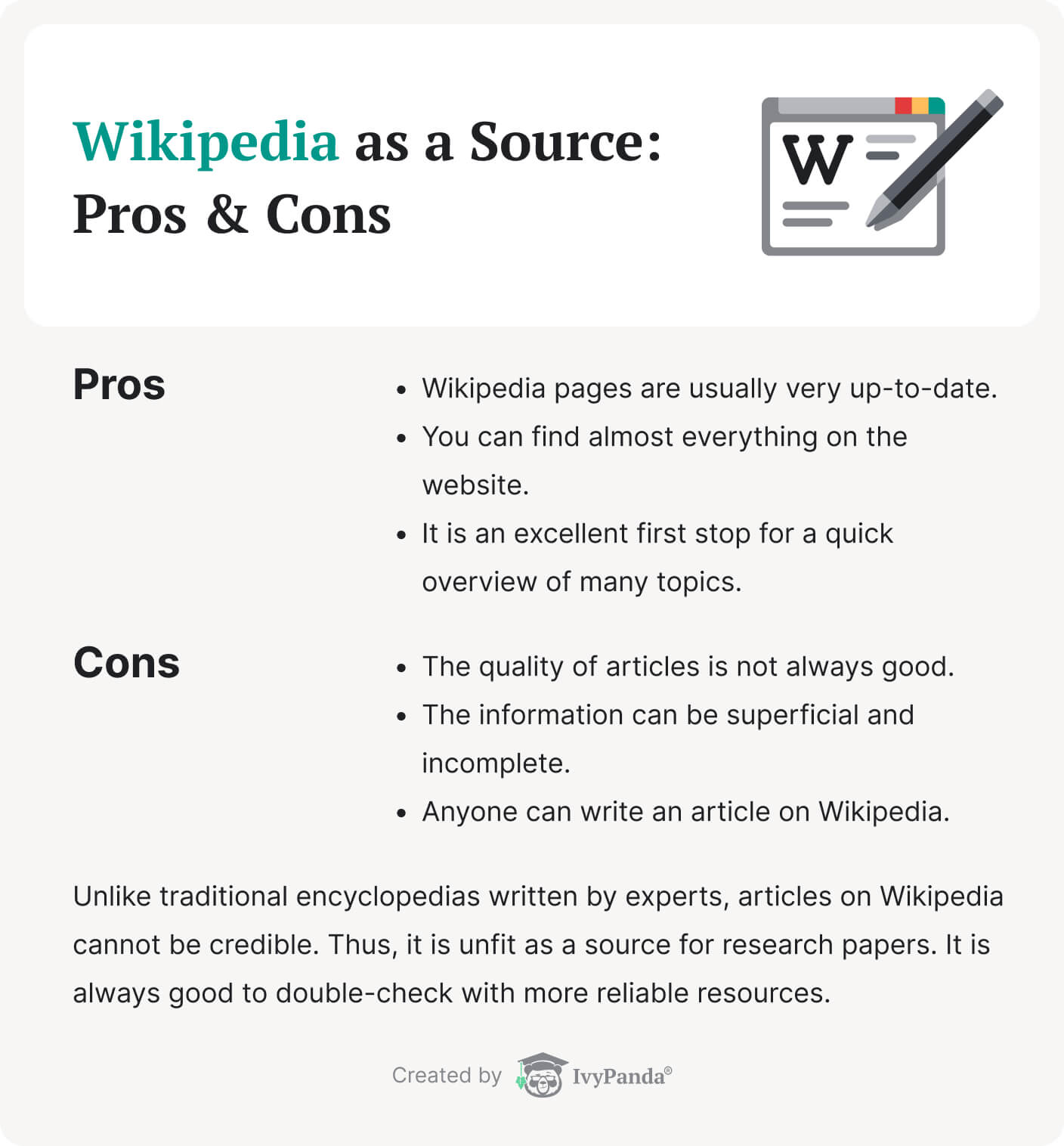
Here are some cons of using these online sources:
- Unreliable. Anyone can write websites, and they are rarely checked for accuracy, bias, and credibility. They are also regularly filled with old content.
- Chargeable. A lot of websites are free of charge. Yet, very often, to read the full article or cite the page you need, you have to pay.
- Tricky to cite. Most websites do not have any citation tools, so it can be hard to add them as references.
- Unstable. Websites are usually not permanent. Both the content and the address change – the link might not be available later on.
Free Websites to Use for Research
Using different websites for background information search and a general understanding of a given topic makes total sense. But when needed, you can use them for actual research.
For this purpose, we recommend the following websites:
| HowStuffWorks is an American website that professor Marshall Brain founded. The topics include animals, culture, politics, and many more. | |
| It is an index of all the best websites for research. The years range from 1999 to 2016. | |
| On this website, you can find more than 45 million images, texts, videos, and sounds from across the United States. DPLA can be used for scholarly research and education. | |
| It is a public collection that offers more than one million images, videos, and documents. This general collection includes papers from Cornell University, MIT, RISD, and Colby College. | |
| This website is a place that you can use to search for topics. It is a part of Technology and Transformation Services. It also has a Spanish-language portal. | |
| It is the U.S. Government’s open data website. You can find information, tools, resources for successful research. It was launched in 2009 and hosted by the U.S. General Services Administration. |
3. Evaluate the Sources
3.1. select what sources to use.
By this step, you have collected many sources for your work. Now is the time to sort through them and get rid of the ones you don’t need. Here, we will explain how to choose appropriate sources for your research.
When checking the quality and credibility of a source, use this checklist:
| ✔ | Currency | The information that was relevant five years ago may not be relevant any longer. Thus, it is crucial to check for the currency and accuracy of your sources. Even when regarding trustworthy publishers, take note of the dates of the studies. |
| ✔ | Purpose | Every single research is done with a particular agenda in mind. Sometimes, it is to pursue advancements in science. Other times, the purpose may be political or economic. Ensure that you check who publishes the information you’re reading and what possible motive or bias they might have. |
| ✔ | Relevance | Any topic has several perspectives and several possible approaches. Not to mention, one area of inquiry can open the door to many others. Double-check that the information you’re studying is directly relevant to your research question. |
| ✔ | Authority | Consider who is publishing the information and what credentials the author has. Is this well-known research, or are you referring to someone’s opinion? Make sure that others can verify the statements you’re reading. |
| ✔ | Accuracy | It is up to you to verify whether your sources are credible. Take into account the previous points in the checklist and let them guide you. Assess the accuracy of the claims you’re reading before adding the source to your reference list. |
| ✔ | Publisher | Note if an academic press has published the article or book you’re considering. In this case, the chances are that it has been through a peer-review process, and the information is accurate. However, for data found on the web, you may have to fact-check the claims yourself. |
3.2. Take Notes
When you have sorted through your sources, you can start reading through them at length. You will still have the opportunity to filter out unneeded information. To accomplish this, we recommend marking down the relevant fragments that you will use in your work.
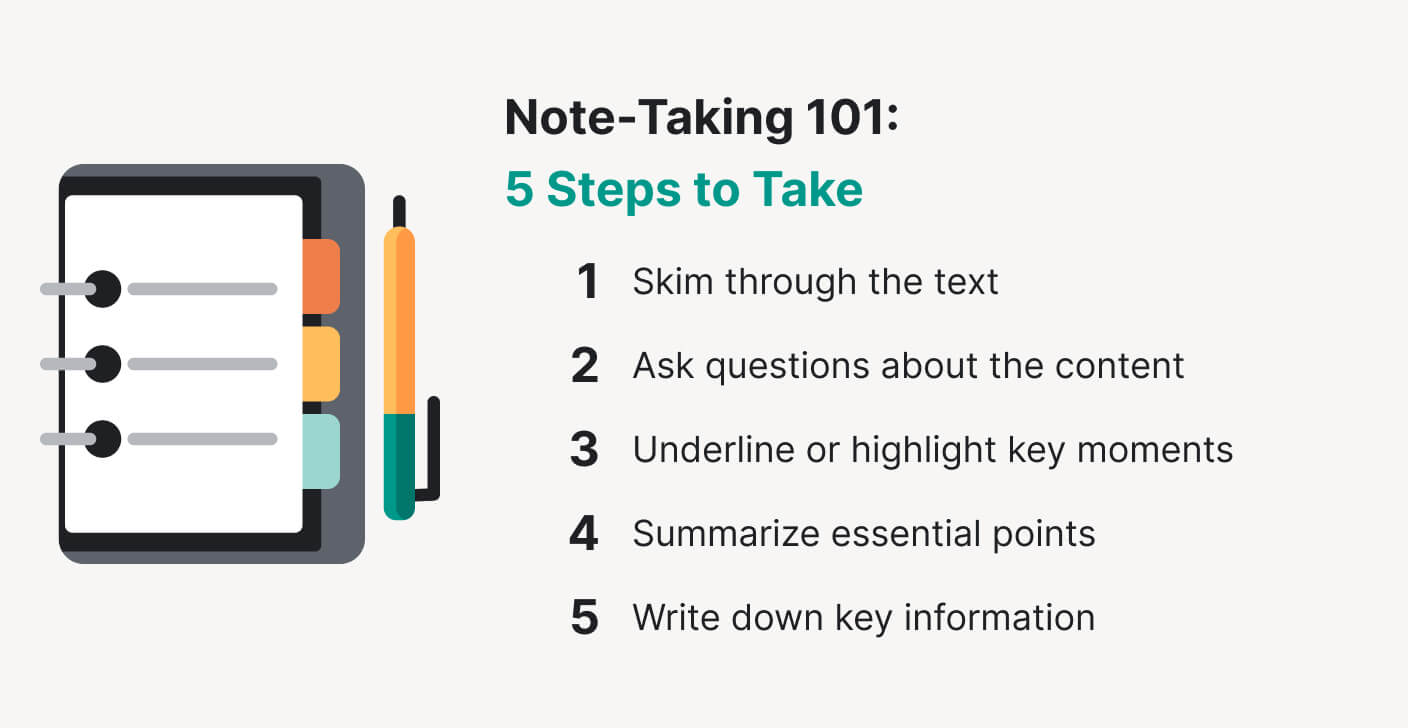
We advise you to study your sources in the following order:
Step 1 : Skim through the text.
Don’t immediately spend an excessive amount of time reading paragraphs and paragraphs of text. First, run through the source to identify the most relevant passages and headings. Note any words or terminology that catch your eye. It will allow you to form a rough idea of the author’s main arguments.
Step 2 : Ask questions.
After you finish skimming through the text, write down any questions that formed in your mind. Make sure that you keep them relevant to your topic. These questions will help you figure out what information you are hoping to obtain from the source.
Step 3 : Underline or highlight.
It’s time to read the source actively. Grab a highlighter or a pen and note down anything that seems relevant or interesting. Pay special attention to the passages that caught your eye earlier. Once you find answers to your questions (or think of even more questions), make sure to jot them in the margins.
Step 4 : Summarize .
As you have finished reading, write down a quick summary of your findings. Do this immediately after you finish while the information is still fresh in your mind. Organize your notes and look up any terminology that isn’t familiar. Also, take a quick look at the bibliography provided by the source – you could find something useful!
Step 5 : Write down key information.
Before moving on to the next source, don’t forget to note everything you need for the bibliography. Write down the title, the author’s name, the publisher, and the date of publishing. If you are using a website, save the URL. Double-check which citation format you’re required to use.
4. Write Your Paper
4.1. formulate your thesis.
A thesis statement is often referred to as the heart of your work since it contains the main idea and stance of the author. The writing process starts with figuring out what you want to say. State it in one sentence, referring back to all the research that you have conducted thus far.
Here are a few tips you could use in writing a compelling thesis statement based on your research:
- State your point clearly. Your argument needs to be explicit and direct. Remember that you will have to address it within the limited confines of your work. There isn’t the space to consider too many points of view. That is why your audience must be clear on the direction your debate is going to follow.
- Be specific. You have to ensure that your wording is as clear-cut as possible. The thesis needs to state the exact idea you will be exploring. If you formulate it too vaguely, the content of your work will be all over the place. Polish your thesis until it becomes specific to your argument.
- Question what you think. To accomplish this, you will need to keep your target audience in mind. Consider what views your readers must have to understand the point you are trying to make. Your statement must be grounded to those who don’t necessarily have the same ideas as you.
- Showcase a strong position. Don’t forget that your thesis statement is a reflection of your comprehension of the topic. While it must be clear and coherent, it should also advance your unique position on the matter. Instead of simply making an observation about something, don’t hesitate to take a stance.
Formulating a successful thesis statement takes time and practice. It is likely that you will not get it completely right on your first try. If you feel like you need some training or require examples, try using our thesis statement generator .
4.2. Outline Your Paper
If you have reached this stage in your work process, it means that you have everything you need. You have composed a strong thesis statement and have your notes and arguments beside you. Now, you have to put them together in a logical order. This way, your reader will see your thought process clearly.

To organize your paper , try this approach:
- Determine the research problem. This isn’t just your thesis statement but is also the key to creating your title. It is the central point of your work. Try formulating it in a single sentence or phrase for efficiency.
- Identify the key arguments. Think of what points you are trying to make with your research. Very briefly note them in your introduction. You will proceed to explore and build on them throughout the rest of your paper.
- Formulate the first category. Consider which point you should cover first. Typically, it is a good idea to start with definitions and clarifications of any critical terminology. You may also want to introduce the background of a particular theory or concept you are exploring.
- Include subcategories if needed. For now, try listing them in the form of a bullet list. The subcategories should provide the basis and support the main points you’re making.
- Sum up and conclude. Once you have created the rough draft, tie everything together. Conclude your project and refer back to your thesis. Make sure that you haven’t strayed away from your research question in creating your outline.
If you have followed these steps, you should end up with a defined beginning, middle, and end. Naturally, different research papers will have carrying outlines. For example, a term paper will have a smaller number of subcategories than a dissertation. Moreover, some projects will require you to mention your research methods, results, etc. You can find more information on how to write an essay or another type of paper in specialized online guides.
4.3. Add Quotes and Examples
To prove that you aren’t making up arguments on the fly, you should provide supporting evidence. You have to refer back to your sources and cite articles and books found during your research.
You can cite a source as supporting evidence like this:
| Summarizing | Listing the main points made in the source in a shortened form. | Read the extract you are trying to summarize until you have a good understanding of the material. Think about two or three main ideas that capture the essence of the argument. Write it down and revise, adding the citation in parenthesis at the end. |
| Paraphrasing | Restating the arguments made by the author using your own words. | Read the passage or sentence you want to paraphrase several times. Once you think you have grasped its meaning, go back to your paper. Change the sentence’s structure and use synonyms. Cite the source in parenthesis when you are done. |
| Quoting | Copying the exact sentence or phrase as it appears in the source without alteration. | Make sure that the quotation you want to use isn’t too lengthy. It should be relevant to your text. Copy it word for word with quotation marks. Add the citation at the end in parenthesis. |
You will be rephrasing and analyzing others’ opinions on your chosen topic for most of your work. However, from time to time, a direct quotation is necessary to support your arguments. This is suitable in the following cases:
- You don’t want to lose the author’s original meaning by summarizing or paraphrasing their words.
- The language in the source material is very effective and would be weakened if you tried to reword it.
- The language that the author is using is important historically.
- The authority found in the source will lend more credibility to the point you are trying to make.
5. Cite Your Sources
Congratulations – your work is nearly finished! You have only a couple of steps left. To round up your research, compile a list of sources you have used. You should also indicate which parts you have cited in your text. That is what we are going to discuss in this section.
Simply put, a citation is used to refer back to the source material. You can cite anything, from an academic article or book to a video or even a viral tweet. This is how you give credit to the original author for their work.
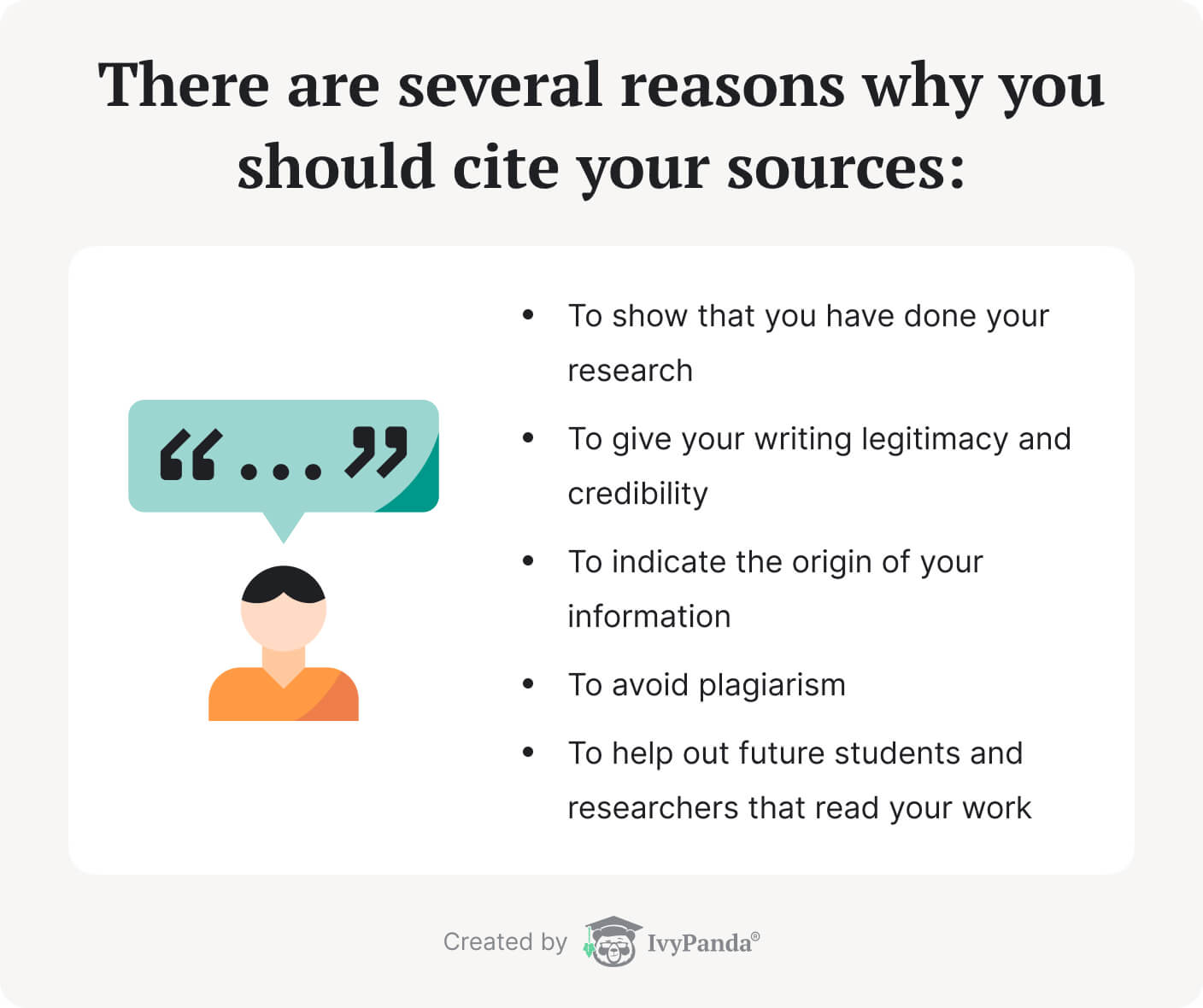
There are a couple of ways to utilize citations in your work correctly:
- When employing quotations, summarizing, or paraphrasing in your text, use in-text citations . These must be placed directly in the body of the work in parenthesis, following the cited fragment. The in-text citations are always shortened, referring only to the author and the year of publishing. Sometimes, for larger works, the page number is also included.
- The full citations go into the references/works cited page at the end of your work. This is also sometimes referred to as a bibliography. These include various features, such as the title of the work, the author’s name, date of publishing, etc. Different citation styles require different elements to be mentioned. Make sure to double-check which one your institution expects you to use.
As we mentioned, while creating any academic work, you are expected to use references. You will have to choose a particular citation style or be directed to one by your instructor. This style will be used consistently throughout your work. Each one has its specific features and guidelines.
Here is what you can expect from them:
| Alphabetized reference list. The authors’ names are inverted. In-text citations are provided in parenthesis. Sources page is titled “References.” | |
| It always includes the same core elements. The elements follow in a specific order. In-text citations are provided in parenthesis. Sources page is titled “Works Cited.” | |
| All words are capitalized (except for prepositions and articles). The titles of books and journals are italicized. In-text citations are provided in parenthesis. Sources page is titled “References.” | |
| Source titles are written using sentence case capitalization. Book chapters and article titles are in single quotation marks. In-text citations are provided in parenthesis and are matched with the reference list. Sources page is titled “Reference List.” | |
| In a title, only the first word is capitalized. The in-text sources are noted numerically. The numbers for the in-text citations match with the reference list. Sources page is titled “Reference List.” |
You can read more about each citation style if you follow the links for the related referencing guides .
In the previous sections, we have examined search engines, databases, and websites that you can use in your research. However, there are plenty of other online tools that can be very useful for your work process. We are going to talk about them here.
The following online tools can help you immensely while you research:
- ProCon.org is a website that allows you to consider several viewpoints on debatable issues. It features multiple controversial topics and lets the readers experience different sides of the arguments in a non-biased manner.
- Journal TOCs is a service that allows you to discover the newest academic papers as soon as they are available online. When writing about current events, it is essential to stay up-to-date, especially concerning research.
- EndNote is a multifunctional tool with many valuable features. It provides you with fast database search, automatic bibliography, and more. Research takes an incredible amount of time and effort, and this program is determined to save you time and resources.
- Paperpile is an extension for your browser and can be installed on your mobile devices as well. Tracking down and compiling your references can become a hassle – this is why Paperpile manages them for you.
- Zotero is another useful extension for your browser. It collects and organizes your research for you. It can also help you with the creation of your citations and allows you to collaborate with others.
- RefWorks is a tool that allows you to save your references from any webpage. It also helps you import them from online databases. You will be able to annotate and highlight your texts, as well as quickly search through them.
- Science Daily allows its readers to browse through all the latest news in several different spheres. Keeping up with updates in the scientific sphere is essential for any researcher, but especially those in the STEM fields. ScienceDaily is a must-have if you need to save time.
- DeepDyve gives you access to different current research articles for a limited time. A large number of valuable sources online are locked behind a paywall. It tends to be troublesome and expensive. DeepDyve allows you to check articles for free to see whether you need them for your research or not.
Thank you for your attention! We hope that you are now feeling more prepared to approach research in any sphere. Share this page with other students who you think could use our guide.
🔗 References
- Basic Steps in the Research Process – North Hennepin Community College
- How to Do Research A Step-By-Step Guide: Get Started – LibGuides at Elmira College
- Conducting Research: the Process – Research Guides at Washington University in St. Louis
- Research Process: Select your Topic – Nash Library & Student Learning Commons at Gannon University
- Developing Research Questions – Research & Learning Online, Monash University
- How to Write a Research Question – Guides at The Writing Center, George Mason University
- Research Process Step by Step: Identify Keywords – Subject and Course Guides at University of Texas at Arlington
- Start Your Research: Evaluate Your Info – Library Guides at University of California, Santa Cruz
- 19 Notetaking Tips for College Students – Post University
- Writing a Paper: Outlining – Academic Guides at Walden University
- How to Outline – Purdue Online Writing Lab, College of Liberal Arts, Purdue University
- What Is Research: Definition, Types, Methods & Examples – QuestionPro
- Thesis Statements – The Writing Center, University of North Carolina at Chapel Hill
- 5 Steps to Create the Perfect Outline – Brandon Ramey, Herzing University
- How to Cite – University of Arizona Libraries
- The Research Process: How to Cite – LibGuides at Franklin & Marshall College
- Share via Facebook
- Share via Twitter
- Share via LinkedIn
- Share via email
Productive tips of information in advancing research skills. I recommend this content to all potential professionals. Thanks for your anticipatory contribution to all the budding academic and research communities.
This is strictly a rich content that goes along way in advancing the research prowess more importantly to the budding researchers. Thank you so much for this.
We are glad to hear your opinion! Thank you, Benard!
6 ways to do research at home
Published by matthew (@mceep) on 22 april 2020 22 april 2020.
We may all be stuck at home but there is still science to be done! Admittedly it’s currently very hard to do science that involves large lasers or going outside for more than an hour at a time, but with a bit of creativity there is still research we can do.
1. Write up papers
A lot of researchers build up work that needs turning into papers but they never get time thanks to grant writing/meetings/emergency evacuations/training (delete as appropriate).
Writing up papers needs no equipment save for possibly a computer. And you can do it on your sofa, in the garden or in front of a picture of someone else’s garden you’ve stuck to the wall of your flat.
Even if you don’t have everything you need for a paper, now is a great time to at least make a start on a paper you might get all the data for later.
2. Organise your data
No judgment but be honest, your data is a huge mess of random folders and hastily made up file names. It happens to all of us and it’s part of the somewhat frantic way research happens.
Folders with names like TEMP and NEW TEMP clutter the data archives of every researcher.
Now is a great time to go though it all and sort it into something that a normal human could navigate. Trust me it will help a lot later when you start back up.
3. Improve your lab notes
Like data lab notes can sometimes be a little be anarchic and written with all the fineness of a drunk rolling in ink. Again this is the perfect time to go back over those notes and make them legible.
You can always use our terrible guide to lab book writing to help you.
4. Learn how to code
There is no research discipline that isn’t in somewhat helped by knowing some code. Just learning a bit of Python or Java can really help you understand computers and maybe give you a whole new tool set to work with when you can get back to proper work.
I can be daunting at first but code is now being taught in school to kids all over the world and if they can do it then you can too! Get started at Code.org .
5. Write a Wikipedia article
Wikipedia is amazing. It’s not perfect but it does a fantastic job of making a lot of information available to anyone on almost any topic imaginable. But it’s knowledge is limited by what people take the time to actually write up.
Now is a great time to add to an article in your subject area and help add to that knowledge for struggling students that just want something to help them grasp a concept.
If want a idea of where to start well ErrantScience doesn’t have an article yet, so if someone wanted to start one… *cough*
6. Have virtual tea
Research is a lot about talking to people and sharing ideas. Don’t stop doing that just because you’re at home. Find colleagues or social media people you can have a cup of tea with and share what your thinking or worried about. If you don’t like talking to people then just sitting on a call listening is fine too.
Virtual meetings aren’t exactly the most fun but small amounts of social interaction with your peers can spur ideas and just make you feel a lot better about doing all these things while stuck inside.

Sign up to receive awesome cartoony content in your inbox, every month.
We don’t spam! Read our privacy policy for more info.
Check your inbox or spam folder to confirm your subscription.
Share this:
Errantscience roundup: terrible lab books and doing research at home – errantscience · 6 may 2020 at 13:01.
[…] 6 ways to do research at home […]
Leave a Reply Cancel reply
Related posts.

ErrantWritings
Research is better with free food.
If there is one universal shared experience that I can, with some confidence, claim all researchers share then it is the love of free food. Be it biscuits, fruit, small strangely shaped corn things or Read more…

Announcing the best lab liquid award
Research is in many ways a subject of debate. Ideas are presented with evidence and through repetition and discussion they are tested and examined. Every discovery or methodology in science is subject to inquiry, dissection Read more…

ErrantContent
Adaptable adaptations in research.
Working as a researcher is a job that requires a lot of adaptability. This is understandable given that the core of the scientific method could be loosely described as “I recon this might happen but Read more…
- PRO Courses Guides New Tech Help Pro Expert Videos About wikiHow Pro Upgrade Sign In
- EDIT Edit this Article
- EXPLORE Tech Help Pro About Us Random Article Quizzes Request a New Article Community Dashboard This Or That Game Popular Categories Arts and Entertainment Artwork Books Movies Computers and Electronics Computers Phone Skills Technology Hacks Health Men's Health Mental Health Women's Health Relationships Dating Love Relationship Issues Hobbies and Crafts Crafts Drawing Games Education & Communication Communication Skills Personal Development Studying Personal Care and Style Fashion Hair Care Personal Hygiene Youth Personal Care School Stuff Dating All Categories Arts and Entertainment Finance and Business Home and Garden Relationship Quizzes Cars & Other Vehicles Food and Entertaining Personal Care and Style Sports and Fitness Computers and Electronics Health Pets and Animals Travel Education & Communication Hobbies and Crafts Philosophy and Religion Work World Family Life Holidays and Traditions Relationships Youth
- Browse Articles
- Learn Something New
- Quizzes Hot
- This Or That Game
- Train Your Brain
- Explore More
- Support wikiHow
- About wikiHow
- Log in / Sign up
- Education and Communications
How to Do Research
Last Updated: March 13, 2023 References
This article was co-authored by Matthew Snipp, PhD and by wikiHow staff writer, Jennifer Mueller, JD . C. Matthew Snipp is the Burnet C. and Mildred Finley Wohlford Professor of Humanities and Sciences in the Department of Sociology at Stanford University. He is also the Director for the Institute for Research in the Social Science’s Secure Data Center. He has been a Research Fellow at the U.S. Bureau of the Census and a Fellow at the Center for Advanced Study in the Behavioral Sciences. He has published 3 books and over 70 articles and book chapters on demography, economic development, poverty and unemployment. He is also currently serving on the National Institute of Child Health and Development’s Population Science Subcommittee. He holds a Ph.D. in Sociology from the University of Wisconsin—Madison. This article has been viewed 227,901 times.
The idea of doing research may seem daunting, but as long as you keep yourself organized and focus on the question you want to answer, you'll be fine. If you're curious and interested in the topic, you might even find it fun! We here at wikiHow have gathered answers to all your most common questions about how to do research, from finding a good topic to identifying the best sources and writing your final paper.
How do I find a topic to research?

- For example, if you're researching in the political science field, you might be interested in determining what leads people to believe that the 2020 US presidential election was illegitimate.
How do I get started on my research?

- For example, if you're researching the 2020 election, you might find that "absentee ballots" and "voting by mail" come up frequently. Those are issues you could look into further to figure out how they impacted the final election results.
- You don't necessarily have to use the overview articles you look at as resources in your actual paper. Even Wikipedia articles can be a good way to learn more about a topic and you can check the references for more reputable sources that might work for your paper.
What's the best way to keep track of my sources?

- Research papers typically discuss 2 or 3 separate things that work together to answer the research question. You might also want to make a note on the front of which thing that source relates to. That'll make it easier for you to organize your sources later.
- For example, if you're researching the 2020 election, you might have a section of your paper discussing voting by mail. For the sources that directly address that issue, write "voting by mail" in the corner.
What kind of notes should I be taking as I research?

- If you find something that you think would make a good quote, copy it out exactly with quote marks around it, then add the page number where it appears so you can correctly cite it in your paper without having to go back and hunt for it again.
How do I evaluate the quality of a source?

- Does the article discuss or reference another article? (If so, use that article instead.)
- What expertise or authority does the author have?
- When was the material written? (Is it the most up-to-date reference you could use?)
- Why was the article published? (Is it trying to sell you something or persuade you to adopt a certain viewpoint?)
- Are the research methods used consistent and reliable? (Appropriate research methods depend on what was studied.)
What if I'm having a hard time finding good sources?

- For example, if you're writing about the 2020 election, you might find tons of stories online, but very little that is reputable enough for you to use in your paper. Because the election happened so recently, it might be too soon for there to be a lot of solid academic research on it. Instead, you might focus on the 2016 election.
- You can also ask for help. Your instructor might be able to point you toward good sources. Research librarians are also happy to help you.
How do I organize my research for my paper?

- For example, if you're researching the effect of the COVID-19 pandemic on the 2020 election, you might have sections on social distancing and cleaning at in-person voting locations, the accessibility of mail-in ballots, and early voting.
What's the best way to start writing my paper?

- Include an in-text citation for everything that needs one, even in your initial rough draft. That'll help you make sure that you don't inadvertently misattribute or fail to cite something as you work your way through substantive drafts.
- Write your introduction and conclusion only after you're satisfied that the body of your paper is essentially what you want to turn in. Then, you can polish everything up for the final draft.
How can I make sure I'm not plagiarizing?

- If you have any doubt over whether you should cite something, go ahead and do it. You're better off to err on the side of over-citing than to look like you're taking credit for an idea that isn't yours.
- ↑ https://www.nhcc.edu/student-resources/library/doinglibraryresearch/basic-steps-in-the-research-process
- ↑ Matthew Snipp, PhD. Sociology Professor, Stanford University. Expert Interview. 26 March 2020.
- ↑ https://library.taylor.edu/eng-212/research-paper
- ↑ http://www.butte.edu/departments/cas/tipsheets/research/research_paper.html
- ↑ https://www.potsdam.edu/sites/default/files/documents/support/tutoring/cwc/6-Simple-Steps-for-Writing-a-Research-Paper.pdf
- ↑ https://www.umgc.edu/current-students/learning-resources/writing-center/online-guide-to-writing/tutorial/chapter4/ch4-05.html
Expert Q&A
You might also like.

About This Article

If you need to do research on a particular topic, start by searching the internet for any information you can find on the subject. In particular, look for sites that are sourced by universities, scientists, academic journals, and government agencies. Next, visit your local library and use the electric card catalog to research which books, magazines, and journals will have information on your topic. Take notes as you read, and write down all of the information you’ll need to cite your sources in your final project. To learn how interviewing a first-hand source can help you during your research, read on! Did this summary help you? Yes No
- Send fan mail to authors
Reader Success Stories
Shenuka Ranawaka
Sep 16, 2016
Did this article help you?
Ismail El Omari
Mar 3, 2022

Featured Articles

Trending Articles

Watch Articles

- Terms of Use
- Privacy Policy
- Do Not Sell or Share My Info
- Not Selling Info
Get all the best how-tos!
Sign up for wikiHow's weekly email newsletter
How to Do Research: A Step-By-Step Guide: Get Started
- Get Started
- 1a. Select a Topic
- 1b. Develop Research Questions
- 1c. Identify Keywords
- 1d. Find Background Information
- 1e. Refine a Topic
- 2a. Search Strategies
- 2d. Articles
- 2e. Videos & Images
- 2f. Databases
- 2g. Websites
- 2h. Grey Literature
- 2i. Open Access Materials
- 3a. Evaluate Sources
- 3b. Primary vs. Secondary
- 3c. Types of Periodicals
- 4a. Take Notes
- 4b. Outline the Paper
- 4c. Incorporate Source Material
- 5a. Avoid Plagiarism
- 5b. Zotero & MyBib
- 5c. MLA Formatting
- 5d. MLA Citation Examples
- 5e. APA Formatting
- 5f. APA Citation Examples
- 5g. Annotated Bibliographies
Research Essentials Video Tutorials
Related guides.
- Elmira College Writing Center Get one-on-one assistance for all types of writing.
Recommended Websites
- Purdue University's Online Writing Lab (OWL)

Research Process Overview
Step 1. Develop a topic Select a Topic | Develop Research Questions | Identify Keywords | Find Background Information | Refine a Topic
Step 2. Locate information Search Strategies | Books | eBooks | Articles | Videos & Images | Databases | Websites | Grey Literature
Step 3. Evaluate and analyze information Evaluate Sources | Primary vs Secondary | Types of Periodicals
Step 4. Write, organize, and communicate information Take Notes | Outline the Paper | Incorporate Source Material
Step 5. Cite sources Avoid Plagiarism | Zotero & MyBib | MLA | APA | Chicago Style | Annotated Bibliographies
For research help, use one of the following options:
Ask the GTL

- Next: Step 1: Develop a Topic >>
- Last Updated: May 29, 2024 1:53 PM
- URL: https://libguides.elmira.edu/research
College Info Geek
How to Do Research in 7 Simple Steps
C.I.G. is supported in part by its readers. If you buy through our links, we may earn an affiliate commission. Read more here.

It’s 2 am, and you’re on your fifth cup of coffee (or was it your sixth?). You’re crouched at a table in some dark corner of the library surrounded by fifteen open books. Equally as many tabs are open on your laptop, and you still haven’t written a word of the paper that’s due in 7 hours.
Many things can explain how you got to this point, including procrastination , poor organization , and a messy schedule .
Very often, however, the problem is a lack of research skills .
And it’s not your fault. High school does a poor job of teaching you how to do research, and most college classes do little better. It feels like you’re expected to figure it out through trial and error.
I think we can do better than that, however. In this guide, I’m going to show you the 7-step process for researching everything from a 10-page term paper to a final presentation. Not only will you learn how to do better research; you’ll also learn how to research more efficiently.
What Is Research?
Before we go any further, what is research?
At its core, research is an attempt to answer a question. This could be anything from “How can we reduce infant mortality rates?” to “Why does salt make food taste good?”
To answer your question, you consult books, academic papers, newspaper articles, historical records, or anything else that could be helpful. The broad term for these things is “sources.”
And, usually, once you’ve done the research, you present or summarize it in some way. In many cases, this means writing an essay or another type of scholarly paper, but it could also mean giving a presentation or even creating a YouTube video.
Even if you have no interest in academia, research is an extremely useful skill to learn. When you know how to do research, it’s much easier to improve your life and work more effectively . Instead of having to ask someone every time you have a question, research will help you solve problems yourself (and help others in turn).
Note: Research can also mean conducting surveys, performing experiments, or going on archaeological digs. While these activities are crucial for advancing human knowledge, I won’t be discussing them here. This article focuses on the research you can do with only a library and an internet connection.
The 7 Steps of the Research Process
Research can feel overwhelming, but it’s more manageable when you break it down into steps. In my experience, the research process has seven main steps:
- Find a topic
- Refine your topic
- Find key sources
- Take notes on your sources
- Create your paper or presentation
- Do additional research as necessary
- Cite your sources
Let’s look at each of these steps in more detail.
1. Find a Topic
If you don’t have a topic, your research will be undirected and inefficient. You’ll spend hours reading dozens of sources, all because you didn’t take a few minutes to develop a topic.
How do you come up with a topic? My number one suggestion is to create a mind map.
A mind map is a visual way to generate ideas. Here’s how it works:
- Get a piece of paper and a pen. Make sure the paper isn’t too small — you want lots of room for your ideas.
- Draw an oval in the center of the paper.
- Inside that oval, write a super vague topic. Start with whatever your professor has assigned you.
- Draw lines from the oval towards the edges of the paper.
- Draw smaller ovals connected to each of these lines.
- Inside the smaller ovals, write more specific ideas/topics related to the central one.
- Repeat until you’ve found 3-5 topic ideas.
When I write it out step by step, it sounds kind of strange. But trust me, it works . Anytime I’m stuck on a writing assignment, this method is my go-to. It’s basically magic.
To see what mind mapping looks like in practice, check out this clip:
Want to create a digital mind map like the one Thomas uses in the video? Check out Coggle .
2. Refine Your Topic
Okay, so now you have a list of 3-5 topics. They’re all still pretty general, and you need to narrow them down to one topic that you can research in depth.
To do this, spend 15 minutes doing some general research on each topic. Specifically, take each topic and plug it into your library’s catalog and database search tools.
The details of this process will vary from library to library. This is where consulting a librarian can be super helpful. They can show you how to use the tools I mentioned, as well as point you to some you probably don’t know about.
Furthermore, I suggest you ask your professor for recommendations. In some cases, they may even have created a resource page specifically for your assignment.
Once you’ve found out where to search, type in your topic. I like to use a mixture of the library catalog, a general academic database like EBSCO Host , and a search on Google Scholar .

What exactly are you trying to find? Basically, you’re trying to find a topic with a sufficient quantity and variety of sources.
Ideally, you want something with both journal articles and books, as this demonstrates that lots of scholars are seriously engaging with the topic.
Of course, in some cases (if the topic is very cutting edge, for example), you may be only able to find journal articles. That’s fine, so long as there are enough perspectives available.
Using this technique, you’ll be able to quickly eliminate some topics. Be ruthless. If you’re not finding anything after 15 minutes, move on. And don’t get attached to a topic.
Tip: If you find two topics with equal numbers of sources available, ask your professor to help you break the tie. They can give you insight into which topic is super common (and thus difficult to write about originally), as well as which they find more interesting.
Now that you have your topic, it’s time to narrow down your sources.
3. Find Key Sources
If you’ve picked a good topic, then you probably have lots of sources to work with. This is both a blessing and a curse. A variety of sources shows that there’s something worth saying about your topic, and it also gives you plenty of material to cite.
But this abundance can quickly turn into a nightmare in which you spend hours reading dense, mind-numbing material without getting any closer to actually producing a paper.
How do you keep this from happening? Choose 3–5 key sources and focus on them intently. Sure, you may end up needing more sources, especially if this is a long paper or if the professor requires it. But if you start out trying to read 15 sources, you’re likely to get overwhelmed and frustrated.
Focusing on a few key sources is powerful because it:
- Lets you engage deeply with each source.
- Gives you a variety of perspectives.
- Points you to further resources.
- Keeps you focused.
4. Read and Take Notes
But what do you do with these sources, exactly? You need to read them the right way . Follow these steps to effectively read academic books and articles:
Go through the article and look at the section headings. If any words or terms jump out at you, make note of them. Also, glance at the beginning sentences of each section and paragraph to get an overall idea of the author’s argument.
The goal here isn’t to comprehend deeply, but to prime your mind for effective reading .
Write down any questions you have after skimming the article, as well as any general questions you hope the article can answer. Always keep your topic in mind.
Read Actively
Now, start reading. But don’t just passively go through the information like you’re scrolling through Tumblr. Read with a pen or pencil in hand , underlining any unfamiliar terms or interesting ideas.
Make notes in the margins about other sources or concepts that come to mind. If you’re reading a library book, you can make notes on a separate piece of paper.
Once you’ve finished reading, take a short break. Have a cup of tea or coffee. Go for a walk around the library. Stretch. Just get your mind away from the research for a moment without resorting to distracting, low-density fun .
Now come back to the article and look at the things you underlined or noted. Gather these notes and transfer them to a program like Evernote .
If you need to look up a term, do that, and then add that definition to your notes. Also, make note of any sources the author cites that look helpful.
But what if I’m reading a book? Won’t this take forever? No, because you’re not going to read the entire book.
For most research you’ll do in college, reading a whole academic book is overkill . Just skim the table of contents and the book itself to find chapters or sections that look relevant.
Then, read each of those in the same way you would read an article. Also, be sure to glance at the book’s bibliography, which is a goldmine for finding additional sources.
Note: The above method is a variation on the classic SQ3R method , adapted slightly since we’re not interested in taking notes from textbooks .
5. Create Your Paper or Presentation
“You can’t turn in raw research.”
Research is crucial to crafting a great paper or presentation, but it’s also a great way to procrastinate. I had classmates in college who would spend 8 hours researching a 5-page paper. That’s way too much!
At some point, you need to stop researching and start writing (or whatever method you’re using to present your research).
How do you decide when to stop researching? There’s no strict rule, but in general I wouldn’t spend more than 30 minutes per page of the final paper.
So if the final paper is supposed to be 10 pages, don’t spend more than 5 hours researching it.
6. Do Additional Research (As Necessary)
Once you’ve started writing the draft of your paper, you’ll probably find a few gaps. Maybe you realize that one scholar’s argument isn’t relevant to your paper, or that you need more information for a particular section. In this case, you are free to return to researching as necessary.
But again, beware the trap of procrastination masquerading as productivity! Only do as much additional research as you need to answer your question. Don’t get pulled into rabbit holes or dragged off on tangents. Get in there, do your research, and get back to writing .
To keep yourself focused, I suggest keeping a separate document or piece of paper nearby to note points that need additional research.
Every time you encounter such a point, make note of it in the document and then keep writing. Only stop when you can’t get any further without additional research.
It’s much better to get a full draft done first. Otherwise, you risk suffering a cognitive switching penalty , making it harder to regain your focus.
7. Cite Your Sources
Whether you’re creating an oral presentation, essay, or video, you’ll need to cite your sources. Plagiarism is a serious offense, so don’t take any chances.
How to cite your sources depends on the subject and the professor’s expectations. Chicago, MLA, and APA are the most common citation formats to use in college, but there are thousands more.
Luckily, you don’t need to painstakingly type each of your citations by hand or slog through a style manual. Instead, you can use a tool like Zotero to track and generate your citations. To make things even easier, install the Zotero Connector browser extension. It can automatically pull citation information from entries in an online library catalog.
Once you’ve collected all of your sources, Zotero can generate a properly formatted works cited page or bibliography at just the click of a button.
For help setting up and using Zotero, read this guide . If you need further assistance, ask a librarian.
Go Research With Confidence
I hope you now understand how to do research with more confidence. If you follow the procedures I’ve covered in this article, you’ll waste less time, perform more effective research, and ultimately have the material for a winning essay.
Curious about how to use your research to write a great research paper? Check out this guide .
Image Credits: picking book from shelf
Online ordering is currently unavailable due to technical issues. We apologise for any delays responding to customers while we resolve this. For further updates please visit our website: https://www.cambridge.org/news-and-insights/technical-incident
We use cookies to distinguish you from other users and to provide you with a better experience on our websites. Close this message to accept cookies or find out how to manage your cookie settings .
Login Alert

- < Back to search results
- How to Do Research
How to Do Research
The practical guide to designing and managing research projects.
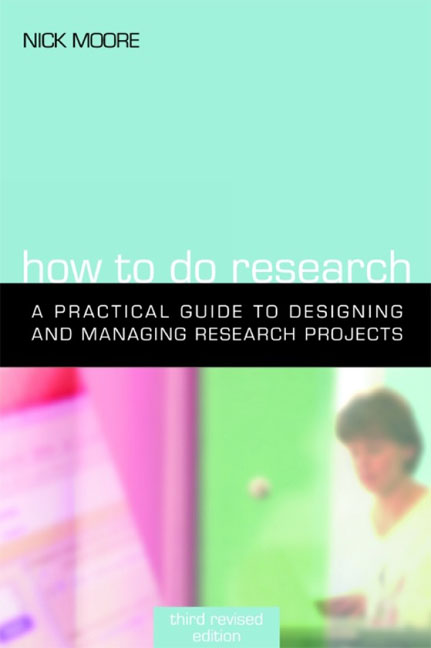
- Get access Check if you have access via personal or institutional login Log in Register
- Export citation
Book description
This new edition of Nick Moore's highly successful "How to do Research" offers an accessible guide to the complete research process. It focuses on the day-to-day requirements of project, managing a piece of research right through from the formulation of the initial idea, to the development of a research proposal and then to the writing up and disseminating of results. Updated throughout, it also contains new and expanded sections on in-house research.
- Aa Reduce text
- Aa Enlarge text
Refine List
Actions for selected content:.
- View selected items
- Save to my bookmarks
- Export citations
- Download PDF (zip)
- Save to Kindle
- Save to Dropbox
- Save to Google Drive
Save content to
To save content items to your account, please confirm that you agree to abide by our usage policies. If this is the first time you use this feature, you will be asked to authorise Cambridge Core to connect with your account. Find out more about saving content to .
To save content items to your Kindle, first ensure [email protected] is added to your Approved Personal Document E-mail List under your Personal Document Settings on the Manage Your Content and Devices page of your Amazon account. Then enter the ‘name’ part of your Kindle email address below. Find out more about saving to your Kindle .
Note you can select to save to either the @free.kindle.com or @kindle.com variations. ‘@free.kindle.com’ emails are free but can only be saved to your device when it is connected to wi-fi. ‘@kindle.com’ emails can be delivered even when you are not connected to wi-fi, but note that service fees apply.
Find out more about the Kindle Personal Document Service .
Save Search
You can save your searches here and later view and run them again in "My saved searches".
Frontmatter pp i-ii
Contents pp iii-v, acknowledgements pp vi-vi, introduction: types of research pp vii-xvi, part 1 - the research process pp 1-2, 1 - develop the research objectives pp 3-9, 2 - design and plan the study pp 10-29, 3 - write the proposal pp 30-44, 4 - obtain financial support for the research pp 45-57, 5 - manage the research pp 58-71, 6 - draw conclusions and make recommendations pp 72-79, 7 - write the report pp 80-93, 8 - disseminate the results pp 94-100, part 2 - methods pp 101-102, 9 - introducing research methods pp 103-105, 10 - desk research pp 106-111, 11 - analysing desk research pp 112-114, 12 - collecting quantitative data pp 115-132, 13 - analysing quantitative data pp 133-140, 14 - collecting qualitative data pp 141-151, 15 - analysing qualitative data pp 152-158, 16 - sources of further reading pp 159-162, appendix - the market for information professionals: a proposal from the policy studies institute pp 163-170, index pp 171-176, full text views.
Full text views reflects the number of PDF downloads, PDFs sent to Google Drive, Dropbox and Kindle and HTML full text views for chapters in this book.
Book summary page views
Book summary views reflect the number of visits to the book and chapter landing pages.
* Views captured on Cambridge Core between #date#. This data will be updated every 24 hours.
Usage data cannot currently be displayed.
Stack Exchange Network
Stack Exchange network consists of 183 Q&A communities including Stack Overflow , the largest, most trusted online community for developers to learn, share their knowledge, and build their careers.
Q&A for work
Connect and share knowledge within a single location that is structured and easy to search.
Can you do research at home, without being backed by a university? [electronics] [duplicate]
I am wondering this because I love electronics, but I go to a college which is mostly for vocational training. Often times I feel like our courses are 40% waste of time (usually too much industry software and/or uninterested lecturers giving compulsory classes).
So I had this idea of taking a year off to focus on my own projects as I did over last summer.
Since I am not sure a masters degree will teach me anything that a book can not, I was wondering whether I could do applied research at home permanently and potentially make money off of it? Right now I earn some money at home online via a site I own. Not much, but enough to get me by. I know how to read and I spend 10 hours in the library with ease (as I have been told this is how grad students work their way through projects). I mostly work on small-scale electronics, like currently an abbreviated type of joystick for paraplegics (that a paraplegic friend suggested). I work alone, at least at the moment.
Could I work on projects on my own and make a life out of this or should I try to join a good university for my masters? How are people without degrees regarded?
- research-process
- independent-researcher
- 3 Welcome to Academia.SE! I'd suggest you look through some of our earlier independent-researcher questions, there should be a lot of information there. In your specific case, the best course of action might be trying to get into a better school, because your current college frankly doesn't sound like it's preparing you for independent research, either. – Stephan Kolassa Commented Jul 9, 2015 at 12:28
- Okay but what does a masters course teach in the way of research? After all, it spans only half a year for the thesis, doesn't it? – helperhelper Commented Jul 9, 2015 at 16:07
- There are two year MSc courses; you get a year to find your topic and a year to execute, all while taking courses. You get access to more expensive software and hardware, and you're surrounded by other researchers and professors that can give you ideas or help hone yours The courses help. Some people start their MSc with the topic already in mind, in which case they have the whole year or 2 for execution, refinement and growth. – HBSKan Commented Jul 9, 2015 at 16:50
- Master's degree can be thought of as preparation for PhD study. It provides a similar in-depth research experience, but at smaller scale and in shorter timeframe. Primarily, it provides experience in carrying out research using a systematic scientific research methodology, taking a project through all stages from concept to write-up/publication. This pushes the student to understand how their research fits into the broader field, and structure the problem and solution approach such that is intelligible not only to one individual but to other experts, which enables contribution to the field. – A.S Commented Jul 9, 2015 at 17:15
4 Answers 4
In the academia, degrees matter, being used as the main gatekeeping mechanism for identifying the pool of eligible applicants for positions at universities. Typically, the higher up you climb up the degree ladder (Master's, PhD) the more (and fancier) doors open.
In private industry, the majority of companies still require at least a bachelor's degree. So if you are considering working for a company at least for a short period of time to develop additional skills, I would highly recommend finishing a bachelor's degree. In some startups (especially Internet startups), you may be able to secure a position through networking with the founders (who sometimes themselves are dropouts).
But it sounds like you prefer to lay your own path in this life. I think you could make a living out of this by becoming an independent inventor, receiving and then either selling patents to corps or developing them into businesses on your own.
You could also work as independent consultant (formally, a sole proprietor) offering software and/or hardware engineering solutions to businesses. In this case, it is important to develop expertise in a fairly narrow niche, such as robot sensors, a programming language (e.g. Java), or a particular manufacturing process in a specific industry (e.g. programming car electronics for auto manufacturers). Typically, a way to develop such skills is to actually work for a company with a focus in this niche, then striking on your own.
To build up experience, also consider design competitions (e.g. dexigner.com/design-competitions ). While some of these are for students affiliated with universities, others are open to anyone.
These options are not necessarily either/or, so you might be able to stitch a successful career and comfortable living by combining two or three of them at once, varying only the extent to which you allocate your time and energy to each of these pursuits. The most important thing is, to make sure you have fun no matter what you do. If it ain't fun, it ain't worth doing. You seem to have the talent and motivation to pursue your interests, which many people dream of but only a few have the guts to actually do. Good luck!
IF you are planning to work for someone else then it could be difficult to get hired next to someone with a Grad degree. Though if you were to work for yourself it IS indeed possible to make a living based on your research, findings, and application.
The hardest part for you though will be accreditation. Are you someone who knows what they are doing and have good intentions or are you an 8 year old who can make things up? When things come to the online medium you never really know who you are dealing with. You need to get you name out there in order for people in the higher education and professional realm to take your research seriously.
Work on getting your name out there and if you can do research with someone who is accredited and has a Grad school degree. The hardest part is getting started because if you do hit it big and have something viable to sell to a company or even a good you are able to make yourself there's no sales unless people know who they are dealing with.
Networking is a powerful thing. If you can find people who do what you want to do reach out and ask them how they got started find out how they networked and who to look for in connections. The more connections you have the better your chances are of "making it" with your solo venture.
Probably best to have a combination of personal projects and formal schooling. Electronics is one of those fields where you can make something useful on your own and enjoy moderate success (especially if you can interface them in useful ways to technology; search for "Maker's Movement" and related topics like arduino/micro-controllers for some ideas).
A standard type of job using electronics will probably require knowledge of at least some of that industry software you've seen in your current program, or other useful skills that might be harder to pick up on your own. Additionally, lack of formal qualifications could be viewed with suspicion and might prevent you from getting a job that you are a perfect candidate for.
If you really mean research -- as opposed to experimenting with components already made, which is almost always going to be development -- you probably can't do it without a major investment in lab equipment. It's unlikely many of us can afford that on our own.
Not the answer you're looking for? Browse other questions tagged research-process university independent-researcher .
- Featured on Meta
- Upcoming sign-up experiments related to tags
Hot Network Questions
- Could alien species with blood based on different elements eat the same food?
- In Northern England, what vowel phoneme is used in “can’t”?
- How fast can you win this (very stupid) game?
- Setup for proving equation 3.4 from Grinold
- How can the CMOS version of 555 timer have the output current tested at 2 mA while its maximum supply is 250 μA?
- Short story in which the main character buys a robot psychotherapist to get rid of the obsessive desire to kill
- Estimating effects in the presence of a mediator
- How can I keep my writing consistent?
- Bibliographic references: “[19,31-33]”, “[33,19,31,32]” or “[33], [19], [31], [32]”?
- Do rich parents pay less in child support if they didn't provide a rich lifestyle for their family pre-divorce?
- How to change the oil life **interval** in a 2012 Chevy Equinox
- Does the recommendation to use password managers also apply to corporate environments?
- Finding equivalent resistance in a circuit in which 12 resistors are arranged in the edge of a cube
- "Could" at the beginning of a non-question sentence
- Is intrinsic spin a quantum or/and a relativistic phenomenon?
- How to fridge/reheat stew so it still tastes good?
- Nonconsecutive Anti-Knight Fillomino?
- Did the NES CPU save die area by omitting BCD?
- Usage of それなりの体制で in this sentence?
- Why don't they put more spare gyros in expensive space telescopes?
- Workers Comp. Insurance with Regard to Single-Member LLCs in Virginia
- Horror movie that has a demon hand coming through a mirror
- How to avoid the strange line at the end of a zigzag decoration
- Tool Storage Corrosion Risk

How to Become an Online Researcher – Ultimate Guide

You'd like to know how to become an online researcher , and in a way, you're already one. Even if you don't think of yourself as an online researcher, you've probably been doing it for as long as you've been online.
You're just not getting paid for it.
You may have debts weighing you down and monthly bills piling up. Or maybe you'd just like to work from home.
Getting paid to do something you're already doing would be a good gig, right?
Of course, starting a career as an online researcher is not the same as searching Google (or any search engine for that matter) for answers to your own questions.
Many industries depend on reliable research, from the academic and medical fields to legal, political, and more. Therefore, online researchers are in demand.
How and where to get started though? That's what I'm going to cover in this article.
Here are the main topics:
What Does an Online Researcher Do?
- How Does Online Researching Work?
- Types of Online Research Jobs
What Do I Need to Become an Online Researcher?
- How Much Do Online Researchers Make?
- How Do I Get Started as an Online Researcher?
- 10 Places to Find the Best Online Research Jobs
- Other Types of Freelance Jobs Related to Online Research
- Starting Your Own Online Research Business
Online research simply means using the internet to gather truthful information on a variety of topics. You've been doing this for your personal needs of course, but you can also do it as a job.
Businesses and professionals hire online researchers because they don't have the time to do it themselves.
As an online researcher, you will use your sleuthing skills to search for honest and reliable information on the web (which isn't always as easy as it sounds). There is a lot of misleading information online.
The topics will depend on your client or employer and may also involve data analysis and interpretation.
Those of us over 40 will remember when this kind of work meant combing through books at the library, but now many printed publications are being converted into digital documents and are available online.
That makes it a much easier job. And one you can do from home.
If you pursue a career in online researching, you can either be an employee or an independent contractor (freelancer). And you can work full-time or part-time depending on your situation.
How Does Online Researching Work?
As mentioned above, how it works is simple. You're gathering and assembling information on the web. You can do it from your office, living room, bedroom, or wherever you feel comfortable working.
Let's also talk about the time-saving and cost-cutting benefits of working at home as an online researcher. You won't be dealing with long commutes, traffic, and annoying co-workers. You also won't need to spend on fuel or public transportation.
The job of an online researcher can also be as straightforward or as complex as you want (yes, you have a choice).
You can simply gather information through search engines and follow the rabbit hole wherever it takes you.
Or, you can do your own original research by conducting…
- Focus groups
- Questionnaires, and…
Another way to do research is to ask questions in various forums, online groups, etc.
Again, your research methods will depend on your specific task and your client's needs. Below are some of the reasons businesses require your services as an online researcher.
- To provide content on their blogs/websites.
- For product testing
- To target specific audiences.
- To check on customer satisfaction.
- To fact-check documents.
- To build document outlines and content briefs.
Types of Online Research Jobs
Listed below are some of the types of online research jobs you can pursue.
1. Basic Online Research
This is the closest you can get to your own personal research on the web. With this type of online research job, you simply gather data on the internet, analyze and interpret the information in a way that will benefit your client/employer. Subscriber publications like Business Insider , for example, are a great way to find information that's not accessible to the general public.
2. Content Analysis
Depending on the niche you're working on, you can use sites, blogs, and communities related to the topic you're researching. In communities, such as those found on Facebook pages, you may use the platform's internal discussions to supplement your study.
3. Online Interviews
You can include interviews in your online research if there's a need. Online interviews function just like face-to-face interviews – but with the convenience of not leaving your home. You can do real-time interviews via chat, for example. Or, if you want, you can also conduct interviews through emails (not in real-time). In any case, keep in mind that the goal of your online interview is to get feedback and learn what others think about specific topics.
4. Social Network Research
For better or worse, social media is one of the most popular online activities. And there's a considerable amount of data found on social networking sites. For example, someone studying the relationships and engagement between people and businesses will find social media research useful.
5. Polls, Surveys, and Focus Groups
Platforms like YouTube and Facebook provide simple polling tools if you're researching opinions about various topics. With platforms like SurveyMonkey , you can conduct more complex surveys.
As you can tell, online research jobs are needed everywhere, in all industries. That, of course, doesn't mean all industries are hiring. But there are many opportunities. If you have knowledge or experience in the medical or legal fields, for example, you can look for online research jobs in those industries.
The following are some of the reasons why brands and businesses hire online researchers:
- Product research and improvement
- Improve customer satisfaction
- Establish and grow brand loyalty
If you know your way around the internet, you're already qualified to become an online researcher. And, if you have a degree in a particular field (medical or legal, for example), you will have better job possibilities.
Since you will be working from home, you also need a computer and an internet connection as well as basic computer skills and knowledge of various software applications (depending on your client's requirements).
If you are pursuing a job as an entry-level internet researcher, you may be accepted even with no prior experience.
With that said, even if you're not skilled in a particular area, you should be good at validating information. Finding the information you need is one thing; making sure you can trust that information is another.
Investigate a site's legitimacy and reputation by checking its Better Business Bureau profile (if they have one), social media presence, years in business, and reviews on the internet.
Use critical thinking and leave your opinion at the door.
Your client or employer requires objective research, not research that validates your opinion about a subject or topic.
If your work involves creating content, reports, and write-ups about your research, you will also need writing skills. On the other hand, if your job requires simple data entry, knowledge of your employer's software apps might be sufficient.
To summarize:
- You will need a computer and an internet connection.
- Software knowledge that will depend on your particular job (and your client's needs). For written content and reports, for example, knowing how to use word processors like MS Word or Google Docs will be required. For data entry, you may need experience with spreadsheets like MS Excel or Google Sheets. If you need to create presentations and specific formats, your client/employer will also require your knowledge of related software applications.
- You should enjoy research.
- Analytical skills and critical thinking since you will be dealing with a lot of information on the internet. Some of it will be true, and some of it will be false. Some will be outdated, and some just flat-out wrong.
How Much Do Online Researchers Make?
As with many other online jobs , how much money you can make as an online researcher depends on your skills, experience, and speed. Speed is essential because being quick allows you to take on more jobs.
The average hourly rate for an online researcher is $29/hour. However, an entry-level online researcher might start out at $5 to $10 per hour, with pay raises to follow.
According to Comparably, the average US salary for an internet researcher is $67,349 (roughly $5,600/month).

As a freelancer, many jobs will pay per project, so your speed and accuracy will determine your hourly rate.
With experience, you can apply for jobs ranging from $10 to $20 per hour. And in high-demand technical fields that require certified researchers, I've found several reviews stating $50 to $80 per hour.
How Do I Get Started as an Online Researcher?
There are two types of online researchers.
- Certified Online Researchers (or Certified Internet Research Specialists)
- Uncertified Online Researchers
This article will primarily focus on uncertified online researchers and freelance work. Since you're just getting started, it's probably safe to assume you're not a certified researcher.
Having said that, if becoming a Certified Internet Research Specialist interest you, the CIRS Training Program offered by the Association of Internet Research Specialists is a globally recognized certificate.
Some of the things you'll learn are:
- Practical approaches to building complex search queries and search tools.
- How web pages are indexed and crawled by search engines.
- How to use search assist and predictive search.
- Introduction to Google Advanced Search Operators.
- How to find names, emails, phone numbers, jobs, and resumes.
- Business and industry searches related to finding leads, doing competitor research, etc.
- Property searches and finding ownership and rental information.
- Information on the deep web
- Cyber law and legal issues.
This is actually just a short list of what the Certified Internet Research Specialist Training covers.
If doing online research as a freelancer or as a side hustle is what you're after, a good place to start is local job boards, like Indeed, for example.
Search for research jobs in your area.
If you specialize in a particular field like education or a trade, you most likely have connections in that field. Ask around. Check industry-specific publications and job postings.
Next, you can search for jobs on freelance platforms like Upwork, Freelancer, and Fiverr.
There are also research platforms like Studypool who hire, which I'll cover in more detail below…
10 Places to Find Online Research Jobs
Listed below are ten places to find the best online research jobs. These are not listed in any particular order because jobs are unique to every individual.
Some sites accept job applicants from entry-level positions, and others may be looking for experts in the field. For the most part, the positions here do not require certification.
There are part-time opportunities, and depending on when you're reading this, full-time jobs might be available.
1. Studypool

Classified as an online tutoring site, Studypool was founded in 2012. They've been BBB-accredited since 2019, and they have an A rating.
As an online researcher, you will be paid on Studypool to answer homework and academic questions from the registered students on the site.
If you have academic expertise and great researching skills, you can try applying to Studypool. Just click on the Apply button on their website to create an account, and start the hiring process. Just keep in mind that passing their screening procedures might be difficult. They need to ensure that you're truly qualified for the position.
If you do pass their hiring process, you will be able to bid on projects. However, to get paid, you must first have your client accept your work.
The nice thing about working on Studypool is working your own hours and setting your own rates.
Aside from the homework tasks, students can also post questions on the platform for you to answer.
As for payment methods, they currently use PayPal, Payoneer, Western Union, and Transferwise. Their minimum threshold to withdraw is $50, and your payment is processed within three days of your withdrawal request.
2. Experts 123

Established in 2010, Experts 123 is a site where you can answer questions and write articles.
You can sign up on their site and fill in your profile with your credentials. Some of the details they'll need are:
- Your expertise
- Your interests
- Your educational background
To make money on Experts 123, you can write content for them and then post the article on your own site (if you have a website). You can earn through ad revenue sharing, so your income will depend on the traffic your article attracts. Then, once you build credibility on Experts 123, you can become one of their paid writers and earn $10 to $20 per article. Below are some of the topics you can find on their site:
- Entertainment
In my opinion, it's a bit challenging to earn a regular income on Experts 123. You need to build up your credibility on the site first before getting paid as a writer. Also, making money from ad revenue sharing can be tricky because you need traffic for it to work.
Another way to earn money on Experts 123 is to answer standing questions on the site.
They pay via PayPal with a minimum payout threshold of $20.
3. JustAnswer

Founded in 2003, JustAnswer is a question and answer website for experts. Like Studypool, they are accredited by the Better Business Bureau and currently have an A+ rating.
JustAnswer only accepts experts on their site, so their application process is quite tedious. You will be required to submit your Social Security number, ID, and licenses/certifications. And they will also run a background check on you through a third-party entity.
If you do get accepted, you can use the tools inside to answer questions. Simply log into your account whenever it's convenient for you, and make money answering questions.
Here are just some of the topics you can expect to see on JustAnswer:
- Tech support
There's no regular pay rate. Your pay will depend on your agreement with your customer. But keep in mind that JustAnswer will charge fees for the use of their platform.
Therefore, you'll only get 20% of your customers' payment at the start of your freelancing career on JustAnswer. However, if you consistently get good ratings, they'll increase your pay to 50%.
They pay monthly through PayPal.
It's not a full-time gig, and it won't replace your job, but it's a way to make money doing research and answering questions. Only you can decide though, if the pay is worth your expertise and time.
4. Flexjobs

Flexjobs is a paid freelance marketplace that started in 2007.
You can search for online researcher jobs on Flexjobs, but you need to buy one of their packages first. Remember, all job posts in Flexjobs are vetted by the site, guaranteeing that their job postings are legit.
You can choose any one of their packages:
- Monthly – $14.95
- Quarterly – $29.95
- Annually – $49.95
Flexjobs has been BBB-accredited since 2008, and they are well regarded in the remote/work-at-home field. They currently have an A+ rating.
You can search for jobs like you would any job board. Here are some search keywords you can use:
- Online researcher
- Internet researcher
- Web researcher
- Research assistant
If you want, you can also sort by location or salary.
They also have an advanced search tool which in my opinion is one of their best features.
Now, you can search for jobs on the site without paying, but you won't be able to see the full details. And, of course, you can only apply if you've paid for one of their packages.
What you can do though, is check their job listings first to make sure there are some that interest you. And, they offer a 30-day money-back guarantee on all of their packages.
As for the pay, you can expect the online researcher jobs on Flexjobs to pay between $10 to $20 per hour.
You can also try applying to Flexjobs itself because they do research to approve the job posts that get placed on their site.

Upwork is a merger between 2 popular freelance platforms – Elance, founded in 1999, and oDesk, established in 2003. They were known as Elance-oDesk when they merged in 2013 but were later rebranded as Upwork in 2015.
You can join Upwork to look for freelance online researcher jobs.
They need to approve your application first – but once accepted, you can start building your profile on the site and applying for jobs.
Jobs are won by bidding on Upwork. And if you get accepted, you can set your own rates. However, in my experience as a freelancer on Upwork, your final rate is still negotiable until you and your client close the deal.
Upwork pays within the platform through PayPal, but they also charge fees as follows:
- 20% – on your first $500 earnings per client
- 10% – on your earnings above $500 up to $10,000 per client
- 5% – on your earnings above 10,000 per client
I have no issues with the fees because they provide a valuable service. And, because of their progressive rates on your earnings, Upwork encourages repeat clients among their users. This is also an incentive for freelancers to stick with clients who want them.
Freelancers are currently charging anywhere from $7 to $100 per hour. You can use those pay rates as a guide when creating your profile and applying for jobs.
I like Upwork as a starting point for beginners. I've used this site before and know firsthand that there are good clients there. While there are businesses with low budgets, there are also those willing to pay reasonably for good work. Performing well and maintaining repeat clients are 2 of the best strategies to use on Upwork.

Fiverr is another freelance marketplace, which was established in 2010.
What makes Fiverr unique from other platforms is that you can buy and sell services with only one account. So, you can sell your services as an online researcher and purchase other freelancers' services if needed.
You can also offer more than one service. Suppose you have other skills besides online researching, like writing or graphic design, for example. In that case, you can sell those services to clients too.
Although Fiverr was initially named because services were bought and sold for $5, those days are long gone. Now, you can charge anywhere from $5 up to hundreds (and even thousands) of dollars. And your pricing can be per hour or project.
I've used Fiverr before, and I can say that it's an excellent platform for offering your freelance services, especially if you're a beginner (and have multiple services to offer). Like Upwork, though, they charge a fee, which is 20%.
7. Clickworker

Founded in 2005, Clickworker is a freelance site for small tasks. Although micro-task sites like this are often looked at poorly, the number of years Clickworker has been around is testimony to their credibility.
To join Clickworker, simply register on their site as a freelancer or independent contractor. Then create your profile as you would on other freelance platforms and start applying for microtasks, some of which will involve research.
While it's easy to join their site, it's not always easy applying for jobs. This is because they have built-in assessment tests you need to pass before you can apply.
If you're qualified for the jobs you're applying for; then there is a good chance you'll pass these tests. If you're not qualified, well… you may struggle (which is the purpose of the tests).
You can search for online researcher jobs on Clickworker, as well as related keywords such as:
- Web research
- Internet research
- Market research
- Online researching
Based on current job listings and services, online research jobs on Clickworker pay around $10 per hour.
Clickworker pays via PayPal, and their minimum withdrawal threshold is $6.

As a job listing service, few are as extensive as Indeed . And it is probably the one you're familiar with most.
It was founded in 2004 and, like many of the other platforms listed here, is BBB-accredited. Their current rating is A+.
Indeed works by allowing you to search for jobs by keywords and location. Therefore, you can search for online researcher jobs as well as other jobs related to it. You can also search by city, state/province, or region.
Start by setting up an account and posting your resume so employers can find you. You can also apply for jobs on Indeed without an account.
Although many jobs require that you apply using Indeed's user interface, some will need you to contact the employer directly via email or by visiting their website.
Indeed also provides a feature that allows you to be alerted (by email) when new job postings linked to your past searches become available.
9. CareerBuilder

CareerBuilder is another job board similar to Indeed. It's been around since 1995.
Searching CareerBuilder for online researcher jobs is like most job listing sites. Just enter your related keywords, location, etc., and see what's available.
You can also narrow your search down to specific fields, like academic, medical, etc.
From there, click on any particular job that interests you, and CareerBuilder will direct you to that company's website.
You also have the option of joining CareerBuilder. Doing so will allow you to post your resume on their site so employers who have access can find and view your credentials.
CareerBuilder also has unique features such as:
- Salary tool – You can compare your desired salary against other people for the same job title within your chosen location. This will give you an idea of how your skills fare with other people's skills and if you're charging enough for your services.
- Job alert notifications – You can opt for this service to be notified by email when new job openings appear for your searched keywords.
- Quick-apply function – CareerBuilder has a built-in tool that allows you to send multiple job applications in 1 click (up to 25), but I don't necessarily recommend it in most situations. In my experience, customized applications get far more responses from employers and clients than generic ones do.
10. ZipRecruiter

Last but not least on our list of places to find the online research jobs is another job listing site called ZipRecruiter .
ZipRecruiter was established in 2010 and have been BBB accredited since 2012. They are currently rated A+.
ZipRecruiter can help you find jobs in any industry, location, or experience level. Search by job title, keywords, or city, state, zip code, etc.
Like CareerBuilder and Indeed, you can create a ZipRecruiter account and set up a profile to include your skills and experience. This allows ZipRecruiter to match you with potential employers and clients looking for what you have to offer.
Of course, you don't have to join. You can also use ZipRecruiter to find jobs without having an account.
ZipRecruiter also has features like job alerts. If you opt-in for this feature, they'll send you job matches via email.
Other Freelance Jobs Related to Online Research
If you have a talent for internet research but can't find a job doing it, you might consider other types of online jobs and freelance gigs .
Below are some related jobs to consider, which involve online research.
1. Freelance Writing
50% of freelance writing is research. Maybe more.
One of the benefits of freelance writing is that there's always a demand. It can be competitive, but the truth is, there are a lot of bad writers.
It's a wide-open field for good writers.
You can check out the freelance marketplaces and job boards in this guide to find freelance writing jobs.
2. Transcription
Transcription jobs mainly involve listening to audio files and typing down what you hear. What you may not know is that most transcription projects require some research for accuracy.
This is especially true for transcription files involving technical terms, proper nouns, or lousy audio with background noise, multiple voices, or strange accents.
Depending on the topic, transcription jobs may require significant research, even though that's not technically what the job is about.
3. Data Entry
Data entry jobs typically require researching data/information and inputting these into databases.
Because of the nature of the job, your computer skills and knowledge of word processing tools and spreadsheets are essential.
Still, data entry can be considered an entry-level position. So, if you're new to online jobs and want to get your foot in the door, this can be an excellent alternative to online researcher jobs.
Start Your Own Online Research Business
In the list I presented above on the places to find the best online research jobs, some of the sources will charge you fees for using their platform, which I think is fair. They are helping you land those jobs.
But there's another way to keep all your earnings to yourself.
You can create your own online research business and be your own boss. After all, freelancing is considered a business. You can offer your services through your own website or locally to small businesses , professionals, etc.
You don't necessarily need your own site, but it helps.
You can also use social media to promote your research business or do what people did before social media. They knocked on doors, metaphorically speaking. Print some business cards and flyers and drop them off at local businesses.
You can optimize your profiles in social media (e.g., Facebook, LinkedIn, Instagram, Twitter, etc.) to make these attractive to your clients. Use keywords and hashtags to grow your network and connect with brands and companies.
Of course, it's a lot easier said than done. And it takes time. But at the end of the day, an online research business is like any other business. You're supplying a service to clients.
And you don't have to go all-in from the start. Start as a freelancer and do jobs that might not pay very well to gain experience. Then, use what you learn to build a roster of your own clients gradually.
Creating your own online researcher business is a slow process but being your own boss and keeping all the profits is a great reward.
The Benefits of Online Research Jobs
- There's always a demand for online researchers.
- A variety of job opportunities from different industries.
- Entry-level positions don't require experience.
- You get paid to learn new things.
The Drawbacks of Online Research Jobs
- Entry-level positions are generally low-paying.
- Although the demand is relatively high, it's not as high as something like freelance writing.
- Not all topics are interesting. At some point, you'll find yourself researching subjects that put you to sleep.
- It can be challenging. You won't find everything from search engines. You may have to seek out experts, look through printed materials, or conduct surveys.
Where Do You Go From Here?
Online research is a great gig for freelancers, especially with the increased demand for factual content.
Many content publishers and site owners that once hired writers to do their own research are now hiring dedicated researchers and fact-checkers instead.
So it's a good time to be an online researcher. Starting out might not replace your job income, but it's a stepping stone.
It might be slow in the beginning as well, as you build up your client base. During this time, online research doesn't have to be your only work-at-home gig.
Making money online usually works best when you combine it with other methods. Simple surveys for example are good way to to earn a few extra bucks. Companies like Survey Junkie pay you for your opinion. Inbox Dollars is another.
Like your first online research jobs though, they won't replace your job income. But they are a great way to get started if you've never made money online before.
You may be looking for a way to make money full-time from home. In that case, an online business might be what you want. Something that gives you financial peace of mind .
Whether it’s your health, your kids, or a struggling economy… when you don’t have financial stability your nights are spent lying awake and worrying.
Getting peace of mind is definitely something you want and earning an income online can give that to you. I've been there too, and I can tell you, it is possible.
Knowing how to get started is what you need in order to get what you want .
Now, I'm going to give you a free step by step beginner's guide to making money online and you can get it by Clicking Here
I hope this guide has been helpful and if you any comments, questions, or experience working as an online researcher, please share in the comments section below.
Important Comment Disclaimer: The views, information and opinions expressed in the blog comments are solely those of the individuals involved and do not necessarily represent those of Gig Hustlers, its owners, employees, or writers. Gig Hustlers is not responsible for, nor does it verify the content provided by individual commenters. Leave a Comment Cancel reply
8 thoughts on “how to become an online researcher – ultimate guide”.
An informative article, however the section on Ziprecruiter has the information about Indeed repeated.
Hi Laura, thank you for catching that. I think that may have happened during a site rebuild last year. Many posts had to be copied and re-assembled manually. Hopefully that was the only instance of that happening. But again, thanks, I appreciate you taking the time to let me know.
This is really lovely article. Simple to read and comprehend. I got value for the time spent. Thank you.
Nice article, really informative
Thank you for this article. It was written to easily read and comprehend. Love it.
Nice article, thank you very much
Thanks! I found the information in this article to be very helpful to me in starting out in freelance researching jobs!
Disclosure : We are proudly supported by affiliate partners and sponsored ads that keep the lights on. Therefore, some posts may include affiliate links. If you make a purchase using one of our links we may earn a commission at no extra cost to you, and your support is very much appreciated. For more information, please read our affiliate disclosure . Thank you.

Recent Comments
Great review! I'm definitely considering applying to Appen after reading this post. It's always good to have more information before…
I am truly thankful to the owner of this web site who has shared this fantastic piece of writing at…
Thank you for this thorough review! I was considering using Cash and Go, but after reading your post, I'm glad…
Great review of Appen! I completely agree that it's important to do your research and thoroughly vet any work-at-home opportunity…
@Sandra, It does not matter how old you are, or what your personal circumstances are. Your clients are not paying…
Informative article, just what I wanted to find.
Unquestionably believe that which you stated. Your favorite reason seemed to be on the net the simplest thing to be…
Recent Posts
- Home Office Ideas for Small Spaces – Tiny Rooms with Big Ideas by Jay
- Do You Need a Business Plan for Your Side Hustle? by Jay
- How to Start an Auto Detailing Side Hustle for A Shiny New Income by Jay
- How to Start an Urban Farm Side Hustle: Sustainability and Profit by Jay
- AI Proof Jobs and Side Hustles: 22 Ways to Beat our AI Overlords by Jay
- Cozy Home Office Inspiration: 10 Designs for Comfort and Productivity by Jay
- Arise Work From Home Review – A Scam or A Legit Online Job? by Jay
Entrepreneurship Lifestyle Online Surveys Programs and Reviews Work At home
IMPORTANT PAGES
Legal Disclaimer Affiliate Disclosure Privacy Policy
Copyright © 2024 Gig Hustlers, All Rights Reserved, A JKP Media Group Brand
15 Steps to Good Research
- Define and articulate a research question (formulate a research hypothesis). How to Write a Thesis Statement (Indiana University)
- Identify possible sources of information in many types and formats. Georgetown University Library's Research & Course Guides
- Judge the scope of the project.
- Reevaluate the research question based on the nature and extent of information available and the parameters of the research project.
- Select the most appropriate investigative methods (surveys, interviews, experiments) and research tools (periodical indexes, databases, websites).
- Plan the research project. Writing Anxiety (UNC-Chapel Hill) Strategies for Academic Writing (SUNY Empire State College)
- Retrieve information using a variety of methods (draw on a repertoire of skills).
- Refine the search strategy as necessary.
- Write and organize useful notes and keep track of sources. Taking Notes from Research Reading (University of Toronto) Use a citation manager: Zotero or Refworks
- Evaluate sources using appropriate criteria. Evaluating Internet Sources
- Synthesize, analyze and integrate information sources and prior knowledge. Georgetown University Writing Center
- Revise hypothesis as necessary.
- Use information effectively for a specific purpose.
- Understand such issues as plagiarism, ownership of information (implications of copyright to some extent), and costs of information. Georgetown University Honor Council Copyright Basics (Purdue University) How to Recognize Plagiarism: Tutorials and Tests from Indiana University
- Cite properly and give credit for sources of ideas. MLA Bibliographic Form (7th edition, 2009) MLA Bibliographic Form (8th edition, 2016) Turabian Bibliographic Form: Footnote/Endnote Turabian Bibliographic Form: Parenthetical Reference Use a citation manager: Zotero or Refworks
Adapted from the Association of Colleges and Research Libraries "Objectives for Information Literacy Instruction" , which are more complete and include outcomes. See also the broader "Information Literacy Competency Standards for Higher Education."

8 Fun Science Experiments You Can Easily Do at Home
Looking for a science project to do with kids? These experiments go beyond the trivial and incorporate real-world scientific research.
SciStarter Blog
Around the world, millions of kids are headed back to school in a totally different way. Classes are online. Teachers talk to students in virtual classrooms. And parents are often left looking for new, hands-on science learning opportunities.
We’ve got your back. Here are eight fun and easy science experiments that you can do at home with kids of all ages. What’s more, each of these science projects ties into real-life research efforts through citizen science, where volunteers help experts collect and analyze data.
RELATED: VIRTUAL DISSECTION: ANIMALEARNING FROM HOME
Make Wild Sourdough
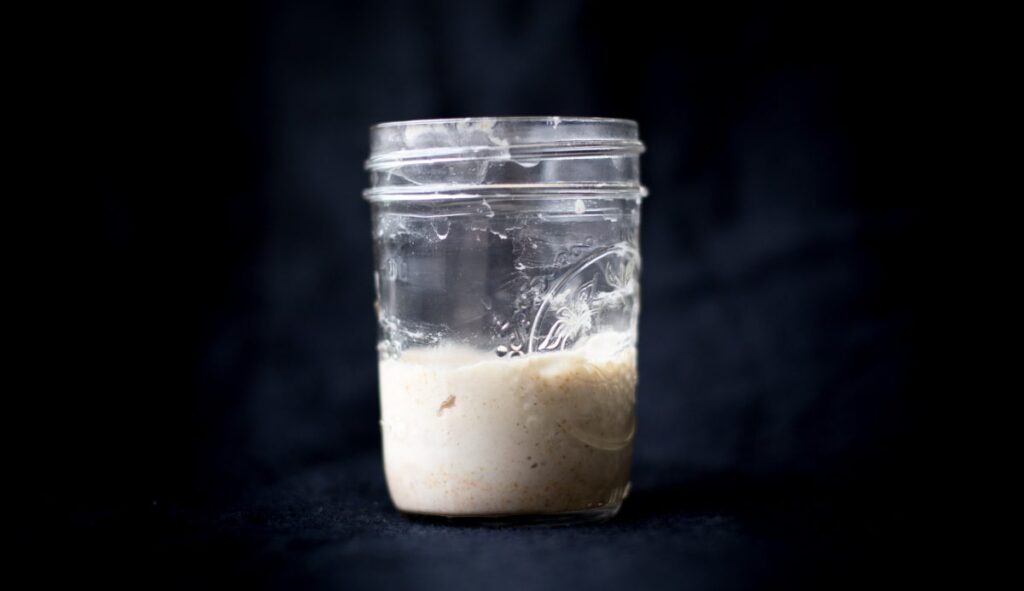
It seems like the whole world is baking homemade sourdough bread right now. Sourdough took on broad appeal when the baker’s yeast disappeared from store shelves. Unlike other baking projects, sourdough doesn’t need store bought yeast. Instead, it’s made with sourdough starter.
RELATED: FREE SCIENCE EDUCATION E-BOOKS
If you have flour, you can easily experiment with making your own sourdough starter. Wild sourdough starters tap into the abundant yeast in our homes and puts them to work making delicious bread. When it comes to science experiments you can do at home, few could be more delicious and rewarding than this one. You’ll also be helping scientists out along the way.
RELATED: BACK TO SCHOOL WITH CITIZEN SCIENCE
The Wild Sourdough Project is a global science experiment that hopes to discover how sourdough starter communities form over time. The team behind the effort is hoping to unravel how factors like geography and different kinds of flour affect the yeast communities. Best of all, the effort has a step-by-step guide that lets you learn how to make your own sourdough starter.
Take Part: Make Your Own Sourdough for Science
Create a Cloud in a Jar
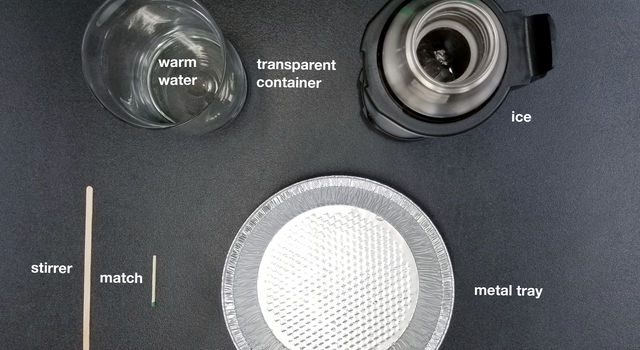
Clouds are an important and often overlooked driver of Earth’s temperature. They trap sunlight in, but they also reflect it back into space. That role has climate scientists rushing to study our planet’s clouds, and how they’re changing. NASA’s GLOBE Observer: Clouds project taps citizen scientists to provide pictures of the sky, plus observations of cloud cover, type, sky conditions and visibility. That data helps info real science research and verify what satellites are seeing from space.
You can get involved with your kids and enrich the experience by adding lessons about clouds. For example, NASA has added a number of fun and easy ways to learn about climate science and clouds, including science experiments. One of the best related projects is to make a cloud in a jar. This simple science experiment is a powerful way to demonstrate how clouds work. You only need water, ice, a jar, and a few minutes of time.
Take Part: Join NASA’s Globe Observer Clouds
Measure Rain and Snow with CoCoRaHS
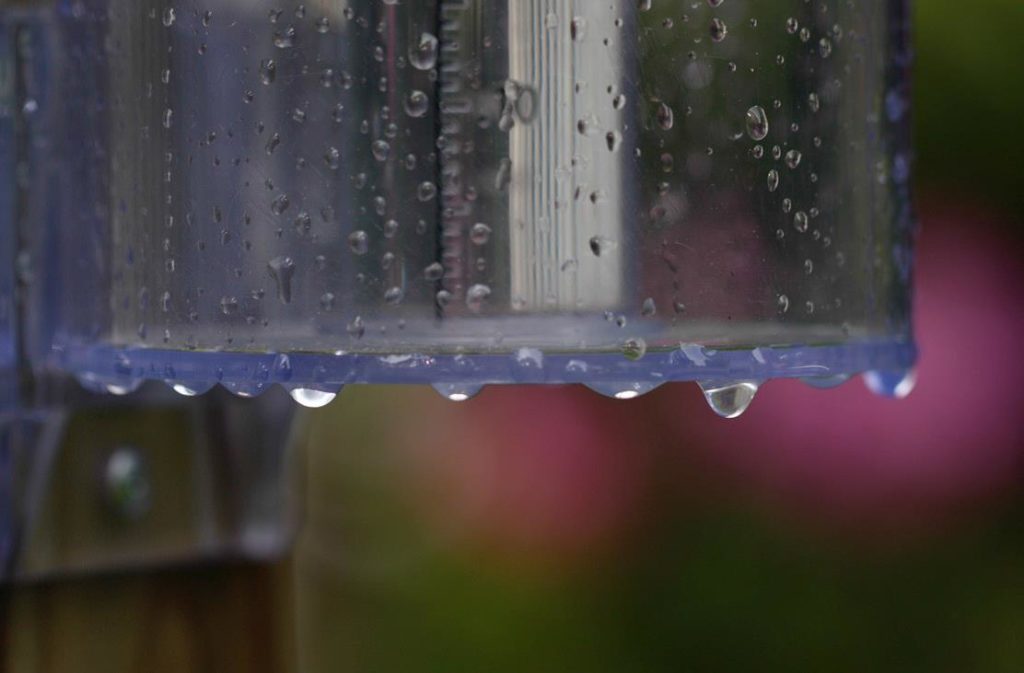
Fall is approaching fast, which means many of us will soon be at home watching rain and snow out the window. Instead of succumbing to the gloom, why not make that weather into a fun science experiment for your kids?
The CoCoRaHS weather monitoring program, or Community Collaborative Rain, Hail, and Snow Network, is a network of volunteers who measure and report on precipitation. CoCoRaHS emphasizes training and education, and they even have an interactive website rich in educational resources and even National Weather Service lesson plans you can use at home.
RELATED: Getting Creative with Remote Science Learning
As a volunteer, you’ll use the same low-cost weather gauges that meteorologists and cities use. Then, when it rains, snows or hails, you’ll submit your precipitation data to the website where you can compare it to others in real-time. That information also helps out the National Weather Service, as well as researchers, farmers, emergency managers — and curious people everywhere.
Take Part: Join the CoCoRaHS Weather Monitoring Network
Plant a Pollinator Garden

Pollinators play a vital role in Earth’s ecosystems, and yet they’re threatened by pesticides, disease, habitat loss and even climate change. That has many people searching for ways to help save bees and other pollinators .
There are many options to chip in, but one of the most impactful things you and your kids can do at home is plant a pollinator garden .
Not only will this serve to help struggling pollinators, it can also serve as a long-term science laboratory at home. SciStarter, the citizen-science group behind this blog post, has compiled an entire group of at-home science projects that can be done from your pollinator garden. You can watch moths, butterflies, bees, hummingbirds and more, then help scientists track their migration across the country.
Take Part: Plant a Pollinator Garden
Build a Bee Condo

If you already have a bumper garden at home, or it’s getting too cold to think about planting just yet, you can still stay indoors and help pollinators. The group behind National Pollinator Week has put together instructions for how you can build a home for native bees, called a bee condo. Unlike domesticated honey bees that live in apiaries, most native, wild bees you find in your backyard actually burrow their homes into the soil or a tree.
By building a bee condo, you can encourage bees to live nearby and also get a fun, DIY science experiment to do at home. Once it’s up, you can watch what kinds of critters take up residence there and report back on the results for science.
Take Part: Build a Bee Condo
Scan the Night Sky

Around the world, light pollution from buildings and street lamps is blocking our view of the night sky. Most people who live in cities have never seen a truly dark sky, or the Milky Way. That’s not just bad for humans, it’s also bad for the plants, animals and insects who are disrupted by light pollution.
If you have a budding astronomy-lover in the house, you can participate in a science project called Globe at Night that aims to create a world-wide measure of light pollution in our night sky.
For this science experiment, you can start making observations using only a smartphone. You’ll mark the sky’s darkness by how many stars you can see. And you can get a sky quality meter through the project to help record even better data.
Take Part: Measure Light Pollution in Your Community
Measure Water Quality
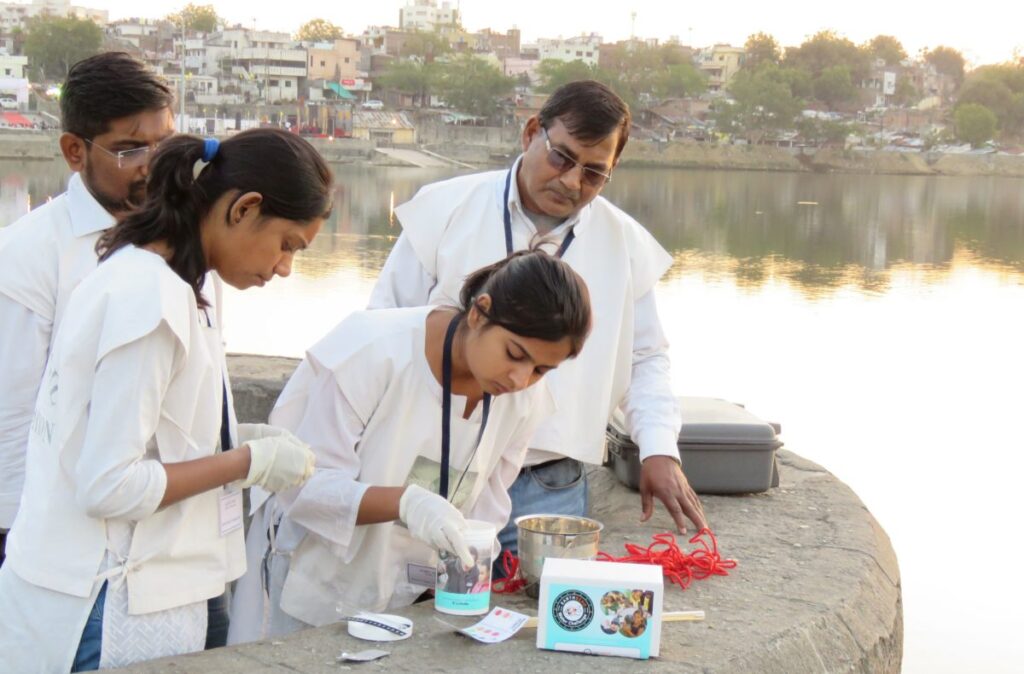
More than 1.5 million volunteers from across the planet are already taking part in a science experiment to track — and protect — Earth’s waterways. The citizen science effort is called the EarthEcho Water Challenge , and it has users buy a water test kit for about $25, then start collecting basic water data.
Volunteers record things like water clarity, temperature, pH and dissolved oxygen. That data gets plugged into a large database, where it’s used for real science research and to help protect waterways.
Take Part: Join the Earth Echo Water Challenge
Study the Vitamin C in Your Juice
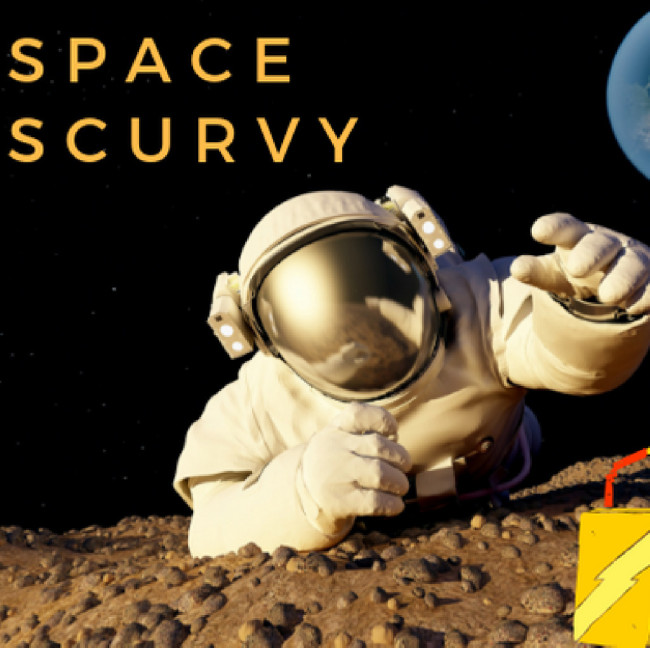
Back in the golden age of sailing, sailors worried that they’d get scurvy. A lack of vitamin C during long voyages can cause a host of health problems. Scurvy leaves you weak, causes skin problems and gum disease, and makes it harder to heal. Scurvy can even kill you. This isn’t just an old-timey concern, either. Future space explorers will have to worry about vitamin C as they head off to explore the solar system. And that’s the angle utilized by a fun citizen science project called Space Scurvy .
The project asks students to use household items to test the vitamin C content of juices from their schools and homes. The necessary tools for this science experiment should be easy to come by, and the site has fun and simple directions for you to follow.
Take Part: Measure Vitamin C for the Space Scurvy Project
Note: Some of these projects are SciStarter Affiliates. You can use your SciStarter account email to join and earn credit for your participation in your SciStarter dashboard.
Citizen Science Lessons During the Pandemic
About the Author
Eric Betz is a science and tech writer for Discover Magazine, Astronomy Magazine, and others. He is a lover of #darkskies and pale blue dots.
Recommended for You
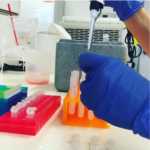
Using Flow Cytometry in Biomedical Science
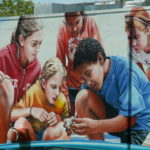
Citizen Science Promotes Environmental Engagement
- The Magazine
- Stay Curious
- The Sciences
- Environment
- Planet Earth
8 Fun Science Experiments You Can Easily do at Home
Looking for a science project to do with kids these experiments go beyond the trivial and incorporate real-world scientific research..

Citizen Science Salon is a partnership between Discover and SciStarter.org .
Around the world, millions of kids are headed back to school in a totally different way. Classes are online. Teachers talk to students in virtual classrooms. And parents are often left looking for new, hands-on science learning opportunities.
We’ve got your back. Here are eight fun and easy science experiments that you can do at home with kids of all ages. What’s more, each of these science projects ties into real-life research efforts through citizen science , where volunteers help experts collect and analyze data.
Make Wild Sourdough
It seems like the whole world is baking homemade sourdough bread right now. Sourdough took on broad appeal when the baker’s yeast disappeared from store shelves. Unlike other baking projects, sourdough doesn’t need store bought yeast. Instead, it’s made with sourdough starter.
If you have flour, you can easily experiment with making your own sourdough starter. Wild sourdough starters tap into the abundant yeast in our homes and puts them to work making delicious bread. When it comes to science experiments you can do at home, few could be more delicious and rewarding than this one. You’ll also be helping scientists out along the way.
The Wild Sourdough Project is a global science experiment that hopes to discover how sourdough starter communities form over time. The team behind the effort is hoping to unravel how factors like geography and different kinds of flour affect the yeast communities. Best of all, the effort has a step-by-step guide that lets you learn how to make your own sourdough starter.
Take Part: Make Your Own Sourdough for Science
Create a Cloud in a Jar
Clouds are an important and often overlooked driver of Earth’s temperature. They trap sunlight in, but they also reflect it back into space. That role has climate scientists rushing to study our planet’s clouds, and how they’re changing. NASA’s GLOBE Observer: Clouds project taps citizen scientists to provide pictures of the sky, plus observations of cloud cover, type, sky conditions and visibility. That data helps info real science research and verify what satellites are seeing from space.
You can get involved with your kids and enrich the experience by adding lessons about clouds. For example, NASA has added a number of fun and easy ways to learn about climate science and clouds, including science experiments. One of the best related projects is to make a cloud in a jar . This simple science experiment is a powerful way to demonstrate how clouds work. You only need water, ice, a jar, and a few minutes of time.
Take Part: Join NASA's Globe Observer: Clouds
Measure Rain and Snow with CoCoRaHS
Fall is approaching fast, which means many of us will soon be at home watching rain and snow out the window. Instead of succumbing to the gloom, why not make that weather into a fun science experiment for your kids?
The CoCoRaHS weather monitoring program , or Community Collaborative Rain, Hail, and Snow Network, is a network of volunteers who measure and report on precipitation. CoCoRaHS emphasizes training and education, and they even have an interactive website rich in educational resources and even National Weather Service lesson plans you can use at home.
As a volunteer, you’ll use the same low-cost weather gauges that meteorologists and cities use. Then, when it rains, snows or hails, you’ll submit your precipitation data to the website where you can compare it to others in real-time. That information also helps out the National Weather Service, as well as researchers, farmers, emergency managers — and curious people everywhere.
Take Part: Join the CoCoRaHS Weather Monitoring Network
Plant a Pollinator Garden
Pollinators play a vital role in Earth’s ecosystems, and yet they’re threatened by pesticides, disease, habitat loss and even climate change. That has many people searching for ways to help save bees and other pollinators .
There are many options to chip in, but one of the most impactful things you and your kids can do at home is plant a pollinator garden.
Not only will this serve to help struggling pollinators, it can also serve as a long-term science laboratory at home. SciStarter, the citizen-science group behind this blog post, has compiled an entire group of at-home science projects that can be done from your pollinator garden . You can watch moths, butterflies, bees, hummingbirds and more, then help scientists track their migration across the country.
Take Part: Plant a Pollinator Garden
Build a Bee Condo
If you already have a bumper garden at home, or it’s getting too cold to think about planting just yet, you can still stay indoors and help pollinators. The group behind National Pollinator Week has put together instructions for how you can build a home for native bees, called a bee condo. Unlike domesticated honey bees that live in apiaries, most native, wild bees you find in your backyard actually burrow their homes into the soil or a tree.
By building a bee condo , you can encourage bees to live nearby and also get a fun, DIY science experiment to do at home. Once it’s up, you can watch what kinds of critters take up residence there and report back on the results for science.
Take Part: Build a Bee Condo
Scan the Night Sky
Around the world, light pollution from buildings and street lamps is blocking our view of the night sky. Most people who live in cities have never seen a truly dark sky, or the Milky Way. That’s not just bad for humans, it’s also bad for the plants, animals and insects who are disrupted by light pollution.
If you have a budding astronomy-lover in the house, you can participate in a science project called Globe at Night that aims to create a world-wide measure of light pollution in our night sky.
For this science experiment, you can start making observations using only a smartphone. You’ll mark the sky’s darkness by how many stars you can see. And you can get a sky quality meter through the project to help record even better data.
Take Part: Measure Light Pollution in Your Community
Measure Water Quality
More than 1.5 million volunteers from across the planet are already taking part in a science experiment to track — and protect — Earth’s waterways. The citizen science effort is called the EarthEcho Water Challenge , and it has users buy a water test kit for about $25, then start collecting basic water data.
Volunteers record things like water clarity, temperature, pH and dissolved oxygen. That data gets plugged into a large database, where it’s used for real science research and to help protect waterways.
Take Part: Join the Earth Echo Water Challenge
Study the Vitamin C in Your Juice
Back in the golden age of sailing, sailors worried that they’d get scurvy. A lack of vitamin C during long voyages can cause a host of health problems. Scurvy leaves you weak, causes skin problems and gum disease, and makes it harder to heal. Scurvy can even kill you. This isn’t just an old-timey concern, either. Future space explorers will have to worry about vitamin C as they head off to explore the solar system. And that’s the angle utilized by a fun citizen science project called Space Scurvy .
The project asks students to use household items to test the vitamin C content of juices from their schools and homes. The necessary tools for this science experiment should be easy to come by, and the site has fun and simple directions for you to follow.
Take Part: Measure Vitamin C for the Space Scurvy Project
Note: Some of these projects are SciStarter Affiliates. You can use your SciStarter account email to join and earn credit for your participation in your SciStarter dashboard.
- citizen science
- personal health
Already a subscriber?
Register or Log In

Keep reading for as low as $1.99!
Sign up for our weekly science updates.
Save up to 40% off the cover price when you subscribe to Discover magazine.
Have questions about buying, selling or renting during COVID-19? Learn more
Zillow Research aims to be the most open, authoritative source for timely and accurate housing data and unbiased insight.
- Market Moves Closer to Balance as Sellers Return and Buyers Balk (May 2024 Market Report)
The Numbers
May 2024 U.S. Typical Home Value (Zillow Home Value Index)
$360,310 (3.9% YoY)
May 2024 U.S. Typical Rent (Zillow Observed Rent Index)
$2,036 (3.4% YOY)
May 2024 Change in New Listings
May 2024 Typical Mortgage Payment
- Affordability crisis: Housing Shortage Worsened Despite Pandemic Construction Boom
- Despite 7% Mortgage Rates, One in Seven Families Could Still Afford To Take On A New Mortgage
- Zillow Home Value and Home Sales Forecast (May 2024)
- Treasury Yields, Mortgage Rates Fall On Faster Than Expected Disinflation in May
- Higher Wages, Steady Rental Market Have Allowed Renters to Catch Their Breath (May 2024 Rental Market Report)
- Market Heat Index
- Treasury Yields, Mortgage Rates Ease Ahead of Last Month’s Jobs Report
- How the Housing Market is Changing in Cities Gaining the Most New Neighbors
- Coming in Hot: Phoenix is Named the Best Market for New College Graduates
- DSpace@MIT Home
- Computer Science and Artificial Intelligence Lab (CSAIL)
- Artificial Intelligence Lab Publications
- AI Working Papers (1971 - 1995)
How to do Research At the MIT AI Lab

Date issued
Series/report no., collections.
Show Statistical Information
Gear-obsessed editors choose every product we review. We may earn commission if you buy from a link. Why Trust Us?

Every Single Cell in Your Body Could Be Conscious, Scientists Say. That Could Rewrite Everything We Know About Human Evolution
If trillions of tiny bits of consciousness are floating around inside you, it could change how we think about life.
The reason for such cooperation comes down to a cellular form of intelligence, says evolutionary biologist and physician William B. Miller, Ph.D. He’s co-author of the book, The Sentient Cell: The Cellular Foundations of Consciousness , published in January 2024, which proposes a radical new way of thinking about some of life’s tiniest components .
Miller is among a small but growing group of scientists who believe we should no longer think of cells as passive robots that automatically follow a code of instructions, carrying out orders from our genome like mindless drones. Instead, they say, the roughly 37 trillion cells that make up our own bodies are conscious —and that life and consciousness began at the same time.
It’s a revolutionary idea, Miller tells Popular Mechanics , but assuming cells have a form of consciousness can give us a better understanding of complex processes. These include cellular communication and decision-making, and even the motivation behind an embryonic cell specializing into a specific organ. While it’s not widely accepted among scientists, this concept of “ existential consciousness ” will profoundly transform the way we approach cellular bioengineering problems like tissue regeneration, provide a different perspective on finding cures for diseases like cancer , and even help us survive on Mars, Miller says.
Now, in a May 2024 paper published in the peer-reviewed journal Progress in Biophysics and Molecular Biology, Miller and his fellow authors argue that random chance did not govern the concept of natural selection; that’s what the 1850s naturalist Charles Darwin, known for establishing the theory of evolution, thought. Instead, the authors contend that a form of cellular consciousness actually drove life’s evolution —and it’s the reason behind all of life’s existence. CONSCIOUSNESS, AT THE LEVEL OF THE CELL , cannot produce a human being’s own, complex thoughts, feelings, and sensations; a cell doesn’t have the capacity for abstract thought. But here’s how it does work, says Miller: Imagine a typical situation—daylight in a cell’s environment hits the cell’s external membrane and passes through it. The cell measures that light signal internally, forming a piece of information about the light. “Because it has to analyze it internally, that becomes an experience as the cell analyzes the light to support the state it prefers to be in [to fulfill its function],” Miller says. While that example is of a bacterial cell, all cells absorb various data from their surroundings, analyze them, and make decisions about the actions they should take, such as producing a hormone, or moving in a particular direction, perhaps toward the light.
From early in life’s history, cells of all kinds have combined their skills to further a common goal—to keep on living and reproducing. “Cells have formed colonies. It’s very much like a city that we humans might engineer. It has nutrient channels, an outside and an inside, a collective metabolism,” Miller says. For example, microbes collaborate with each other. They’re codependent, trading resources as well as competing. “In order to make this ecology flourish, each of these cells is taking intelligent action. They’re communicating with one another, and both individually and collectively deploying resources. That’s problem solving and decision making. That’s cognitive action, and it’s one element of consciousness,” he says.
It’s still a hard concept to swallow—that bacteria and other microorganisms are conscious on any level. To animals like us, consciousness is due to a complex nervous system.
.css-2l0eat{font-family:UnitedSans,UnitedSans-roboto,UnitedSans-local,Helvetica,Arial,Sans-serif;font-size:1.625rem;line-height:1.2;margin:0rem;padding:0.9rem 1rem 1rem;}@media(max-width: 48rem){.css-2l0eat{font-size:1.75rem;line-height:1;}}@media(min-width: 48rem){.css-2l0eat{font-size:1.875rem;line-height:1;}}@media(min-width: 64rem){.css-2l0eat{font-size:2.25rem;line-height:1;}}.css-2l0eat b,.css-2l0eat strong{font-family:inherit;font-weight:bold;}.css-2l0eat em,.css-2l0eat i{font-style:italic;font-family:inherit;} “Every aspect of the consciousness that I’m experiencing is a simultaneous aggregation of the consciousnesses of all of my body cells and all of those microbes working in tandem, coordinating so seamlessly that I feel like I’m one individual.”
However, Miller and his fellow authors see this higher, human form of consciousness as a natural property our cells create—together with the more than 10 trillion essential microbes that are a part of our bodies. “Every aspect of the consciousness that I’m experiencing is a simultaneous aggregation of the consciousnesses of all of my body cells and all of those microbes working in tandem, coordinating so seamlessly that I feel like I’m one individual,” he says.
Before exploring that idea further, it’s important to understand one thing: We are holobionts , because we consist of our own host cells and the ones we live with in symbiosis, or mutual cooperation. In particular, we live in symbiosis with a bacterial, viral, and fungal population of cells. In other words, our cells and our microbes mutually benefit one another.
The evolutionary science of the hologenome —that we co-evolved with our microbiome—says that evolution led those first cells to continue forming different kinds of habitats in order to survive and thrive; hence, the development of plants, animals, and fungi. “We’re a constellation of habitats,” says Miller, who spent decades studying the human microbiome and has written several books on the hologenome . He compares human bodies to a successful engineering project for ever more complex groupings of diverse cells living together and adapting to changing environments over millions of years. A form of cellular consciousness has been with us since life first emerged, 3.5 billion years ago. They were able to multiply into abundant varieties of bacteria, amoeba, and then more complex organisms because of their particular awareness. Today, your brain, microbiome and the cells of your gut work together as a community of cells to create your sense of consciousness.
“We are a rich, wonderful, delightful environment for cells,” he says. “So, we bear a resemblance to the first biofilm [microbial colony]. …We are one end result, along with every other creature that can be seen—we are a particular solution to a set of biological cellular problems.”
The authors of The Sentient Cell aren’t alone in hypothesizing that our microbes, the bacteria and viruses in us, have a great deal to do with our consciousness. Various studies show that our own cells communicate with our microbiome, and that our brain, gut, and microbiome are deeply entangled, forming a complex system. Besides being responsible for our health, these complex interactions contribute to our higher level consciousness, according to a 2020 paper in the peer-reviewed Inquiries Journal .
HOWEVER, NOT ALL SCIENTISTS who study the biology of life are convinced that cells are conscious. Cells respond to both chemical and physical signals, including pressure from surrounding cells. The cells of a developing embryo know, for example, when their number has grown to 400. At this exact point, the group begins to separate into three axes that determine the body’s final orientation: front and back, left and right, up and down. They know how to differentiate themselves into the tissues that will become your organs and other parts. Cells are the architects of the organism, cell biologist Alfonso Martínez Arias, Ph.D., tells Popular Mechanics .
His work shows that a person’s genome is a toolbox for the cell to use as it may. Yet we cannot presume that a cell’s behavior is due to consciousness, says Martínez Arias, who spent 40 years at the University of Cambridge researching how a fertilized egg can become an individual with billions of specialized cells.
While cells exhibit behaviors that you could call a sort of intelligence—responding to other cells and their environment—the crux of the problem is that it’s hard to define consciousness, he says. “With cells, there is some kind of computation going on, with an output that can be predicted. …I think increasingly, there is evidence that cells have capacities that are not encoded in the genome.” For instance, the ability to pick and choose from the toolbox of genes that give us our ultimate characteristics. Through experiments, researchers have been able to study cell responses to different chemical and physical stimuli, such as exposing them to a chemical compound that would cause the cells to produce a different compound. “So we are able to communicate with them, but we do it badly. …But I think we are learning their alphabet, we’re learning their language,” Martínez Arias says. He hopes that continuing such investigations will lead us someday to knowing what makes cells tick.
Conventional resistance to labeling cells as “conscious” comes from defining consciousness from a human point of view, Miller believes. We compare our own consciousness to the capacity of other animals, such as the mosquito or the lion. “And the more you look, the more you realize that our form of consciousness, with its own intelligence, is different from other animals, [so our view is skewed].” A cell’s consciousness is more elemental, a simpler form of cognition, he says.
Here’s a practical reason to treat cells as conscious, Miller says: Once we realize that cells are “creative and intelligent problem-solving materials,” we can treat them as partners in designing better biomedical therapies and solutions. By studying their motivations and decision-making, we’ll find more ways to manipulate cells, such as interrupting their processes. For example, cancer cells communicate with each other and with non-cancer cells in the body. We are finding promising cures for some cancers that break down the communication cancer cells use in their efforts to propagate and form tumors. This type of directed immunotherapy leaves patients’ own healthy cells undamaged, unlike chemotherapy, or radiation, which damages healthy cells too.
We’re already taking advantage of cell behavior to engineer microbes that eat plastic. Such creative solutions in the future won’t be possible if we treat cells as robots without preferences, Miller says. We’ll even understand how to explore space better. For example, the radiation levels on a journey to Mars are too high to survive. One of the solutions could be figuring out a way to strengthen our cells against dangerous radiation. Miller believes a study of how cells themselves could engineer an adaptation to radiation would help.
Before joining Popular Mechanics , Manasee Wagh worked as a newspaper reporter, a science journalist, a tech writer, and a computer engineer. She’s always looking for ways to combine the three greatest joys in her life: science, travel, and food.

.css-cuqpxl:before{padding-right:0.3125rem;content:'//';display:inline;} Pop Mech Pro: Science .css-xtujxj:before{padding-left:0.3125rem;content:'//';display:inline;}

She Was Pronounced Dead—Then Found Gasping for Air

How to Live Forever, or Die Trying

A Groundbreaking Discovery For Interstellar Travel

Dark Matter Could Unlock a Limitless Energy Source

The Source of All Consciousness May Be Black Holes

Could Freezing Your Brain Help You Live Forever?

The Universe Could Be Eternal, This Theory Says

Immortality Is Impossible Until We Beat Physics

How Vacuum Energy Could Help Us Reach Light Speed

Could the Chair You Sit on Have a Soul?

Here’s How We Could Live in Trees
Co-discoverer of HIV to bring his research to USF. He’s looking for a cure.
- Sam Ogozalek Times staff
Robert Gallo, 87, is still hunting for a cure to HIV. And he’s bringing his research to Tampa this summer.
Gallo, an influential scientist who’s credited as the co-discoverer of HIV, the virus that causes AIDS, is joining the University of South Florida faculty in July. He plans to dive into a range of subjects as director of a new virology center.
In 2011, he co-founded the Global Virus Network , an international coalition of virologists, which is moving its headquarters to the university under a five-year agreement in which USF will pay the network $2 million per year for support. He previously led the Institute of Human Virology at the University of Maryland.
Gallo is best known for his early work on HIV, which sparked what PBS NewsHour once called a “transatlantic research war” — a bitter feud between scientists that eventually led to intervention from President Ronald Reagan and his French counterpart.
In 1983, Luc Montagnier, a researcher in Paris, published his lab’s findings on a virus he called LAV, but noted that its role in AIDS was still undetermined, according to an obituary from 2022 in The Washington Post . A year later, the U.S. secretary of health and human services announced that Gallo and his lab had found the probable cause of AIDS. The culprit was a virus they called HTLV-3. At that time, AIDS had already killed more than 1,700 people in the U.S. and would ultimately lead to millions of fatalities worldwide in the late 20th century.
Montagnier sent samples of his virus to Gallo, who eventually acknowledged that the American lab’s virus was probably contaminated by the French samples, The Post reported.
Gallo’s team secured a U.S. patent for a blood test in 1985, spurring a lawsuit from the French against the federal government, according to The Post’s obituary. The two nations later agreed to split royalties from the test — worth millions of dollars each year — and Gallo and Montagnier were credited as co-discoverers of the virus, which was renamed HIV in 1986. But only Montagnier won a Nobel Prize for his work.
The Tampa Bay Times recently spoke to Gallo, who was the most referenced scientist in the world in the 1980s and ‘90s , about his plans for the USF virology center, what could spark the next pandemic and his thoughts on Florida’s COVID-19 response.
This interview has been edited for clarity and length.
Will the center conduct research, and if yes, what will it focus on?
The first thing is to make it as good as possible and to think about what are the future problems, but also I’m entangled with research on things of the past ... viruses involved in human cancer and, of course, in HIV and AIDS.
I just published two papers with French colleagues. ... I believe we have shed new light on the mechanisms of how HIV causes AIDS. That gives ideas for new forms of therapy that I believe have the potential of leading to a “functional cure.” ... I’m working on that with collaborators.
Keep up with Tampa Bay’s top headlines
Subscribe to our free DayStarter newsletter
You’re all signed up!
Want more of our free, weekly newsletters in your inbox? Let’s get started.
I have an interest in what’s called HTLV-1 [ human T-cell lymphotropic virus type 1 ] . It was the first retrovirus to be discovered, before HIV, which is also a retrovirus. ... It’s the cause of leukemia of T cells in young adults.
It doesn’t transmit easily but it’s highly cancer causing.
Can you expand on HIV, what work your team is going to be doing?
With my French collaborators ... we found something very strange. In an infection, rather early, if not (immediately), there are abnormalities not just in the HIV-infected cells but throughout the body in all immune cells. How the hell does that happen? I was shocked when we had that data. So we decided to find out why, and I think we did.
It’s an overproduction of interferon-alpha , which is part of our innate immunity. ... If it’s too high, and lasts too long, it becomes a real problem.
We’re going to try to target that interferon-alpha with antibodies. ... I want to bring it into clinical trials fast. If we can get a functional cure, you don’t need therapy anymore.
What are the most pressing scientific questions you think virologists need to answer in the next decade?
There are some that are obvious. A universal flu vaccine. And then could that be the same with COVID?
What pathogen do you think will spark the next pandemic?
I don’t know. ... Look, who would suspect HIV? In the mid, late ‘60s when I was a young, beginning guy, everybody respected viruses and the possibility of epidemics. Ten years later, nobody did. I found that human retroviruses existed. I was laughed at. The first paper on HTLV-1 was rejected by the Journal of Virology.
It may be a total surprise. If I had to bet, I’d say a variant of influenza. And because of our recent experience with MERS , then SARS and then COVID, you’d probably say another coronavirus, or one of the same emerging back again. ... In the meantime, greater problems with dengue in the southern parts of the United States and all over the world, moving northward.
Public health has been so politicized in the wake of COVID-19, including in Florida. Is that a concern to you?
Of course it’s a concern. What can we do? Should scientists speak out all the time, but then cause trouble for a university or themselves? ... I don’t know what to say. I really don’t.
The state of Florida’s response to the COVID-19 pandemic has been criticized by many public health experts. Gov. Ron DeSantis, for instance, in 2022 petitioned the state Supreme Court to impanel a grand jury to investigate “crimes and wrongs” in Florida related to COVID-19 vaccines. Given these issues, as a virologist are you uncomfortable at all moving to Florida and joining the faculty of a state-funded university?
People there have told me that he’s very smart, very rational, not good in crowds so that hurts him.
I have no fears about Florida. And when talking to the dean [College of Medicine Dean Charles Lockwood] , he thought it would be very useful to try to meet with the governor to do what I did in Maryland. We had a lot of state support.
I heard great things about his wife and her care about cancer. I have not heard bad things, including by Democrats. ... Did I agree with everything he said? ... I can’t think of anybody I agree with all they said.
It’s been decades since this very public feud between you and the French scientist Luc Montagnier over the HIV discovery. As time has passed, looking back on that, do you have any reflections?
Who showed the cause? Unequivocally we did, they never did. Who grew the virus? Unequivocally we did, they never did. Who provided the technology? We did, they never did. ... But their paper is the first paper.
We shouldn’t have called a press conference because I told the French group that we would do things together in a press conference. That was the beginning of a problem.
Now, the controversy was not a controversy until blood test patent money came to be.
Sam Ogozalek is a reporter covering the healthcare system and mental health. He can be reached at [email protected].
MORE FOR YOU
- Advertisement
ONLY AVAILABLE FOR SUBSCRIBERS
The Tampa Bay Times e-Newspaper is a digital replica of the printed paper seven days a week that is available to read on desktop, mobile, and our app for subscribers only. To enjoy the e-Newspaper every day, please subscribe.
- Skip to main content
- Keyboard shortcuts for audio player
- Your Health
- Treatments & Tests
- Health Inc.
- Public Health
How to Thrive as You Age
Got tinnitus a device that tickles the tongue helps this musician find relief.

Allison Aubrey

After using the Lenire device for an hour each day for 12 weeks, Victoria Banks says her tinnitus is "barely noticeable." David Petrelli/Victoria Banks hide caption
After using the Lenire device for an hour each day for 12 weeks, Victoria Banks says her tinnitus is "barely noticeable."
Imagine if every moment is filled with a high-pitched buzz or ring that you can't turn off.
More than 25 million adults in the U.S., have a condition called tinnitus, according to the American Tinnitus Association. It can be stressful, even panic-inducing and difficult to manage. Dozens of factors can contribute to the onset of tinnitus, including hearing loss, exposure to loud noise or a viral illness.
There's no cure, but there are a range of strategies to reduce the symptoms and make it less bothersome, including hearing aids, mindfulness therapy , and one newer option – a device approved by the FDA to treat tinnitus using electrical stimulation of the tongue.
The device has helped Victoria Banks, a singer and songwriter in Nashville, Tenn., who developed tinnitus about three years ago.
"The noise in my head felt like a bunch of cicadas," Banks says. "It was terrifying." The buzz made it difficult for her to sing and listen to music. "It can be absolutely debilitating," she says.

Shots - Health News
Tinnitus bothers millions of americans. here's how to turn down the noise.
Banks tried taking dietary supplements , but those didn't help. She also stepped up exercise, but that didn't bring relief either. Then she read about a device called Lenire, which was approved by the FDA in March 2023. It includes a plastic mouthpiece with stainless steel electrodes that electrically stimulate the tongue. It is the first device of its kind to be approved for tinnitus.
"This had worked for other people, and I thought I'm willing to try anything at this point," Banks recalls.
She sought out audiologist Brian Fligor, who treats severe cases of tinnitus in the Boston area. Fligor was impressed by the results of a clinical trial that found 84% of participants who tried Lenire experienced a significant reduction in symptoms. He became one of the first providers in the U.S. to use the device with his patients. Fligor also served on an advisory panel assembled by the company who developed it.
"A good candidate for this device is somebody who's had tinnitus for at least three months," Fligor says, emphasizing that people should be evaluated first to make sure there's not an underlying medical issue.
Tinnitus often accompanies hearing loss, but Victoria Banks' hearing was fine and she had no other medical issue, so she was a good candidate.
Banks used the device for an hour each day for 12 weeks. During the hour-long sessions, the electrical stimulation "tickles" the tongue, she says. In addition, the device includes a set of headphones that play a series of tones and ocean-wave sounds.
The device works, in part, by shifting the brain's attention away from the buzz. We're wired to focus on important information coming into our brains, Fligor says. Think of it as a spotlight at a show pointed at the most important thing on the stage. "When you have tinnitus and you're frustrated or angry or scared by it, that spotlight gets really strong and focused on the tinnitus," Fligor says.
"It's the combination of what you're feeling through the nerves in your tongue and what you're hearing through your ears happening in synchrony that causes the spotlight in your brain to not be so stuck on the tinnitus," Fligor explains.

A clinical trial found 84% of people who used the device experienced a significant reduction in symptoms. Brian Fligor hide caption
A clinical trial found 84% of people who used the device experienced a significant reduction in symptoms.
"It unsticks your spotlight" and helps desensitize people to the perceived noise that their tinnitus creates, he says.
Banks says the ringing in her ears did not completely disappear, but now it's barely noticeable on most days.
"It's kind of like if I lived near a waterfall and the waterfall was constantly going," she says. Over time, the waterfall sound fades out of consciousness.
"My brain is now focusing on other things," and the buzz is no longer so distracting. She's back to listening to music, writing music, and performing music." I'm doing all of those things," she says.
When the buzz comes back into focus, Banks says a refresher session with the device helps.
A clinical trial found that 84% of people who tried Lenire , saw significant improvements in their condition. To measure changes, the participants took a questionnaire that asked them to rate how much tinnitus was impacting their sleep, sense of control, feelings of well-being and quality of life. After 12 weeks of using the device, participants improved by an average of 14 points.
"Where this device fits into the big picture, is that it's not a cure-all, but it's quickly become my go-to," for people who do not respond to other ways of managing tinnitus, Fligor says.
One down-side is the cost. Banks paid about $4,000 for the Lenire device, and insurance doesn't cover it. She put the expense on her credit card and paid it off gradually.
Fligor hopes that as the evidence of its effectiveness accumulates, insurers will begin to cover it. Despite the cost, more than 80% of participants in the clinical trial said they would recommend the device to a friend with tinnitus.
But, it's unclear how long the benefits last. Clinical trials have only evaluated Lenire over a 1-year period. "How durable are the effects? We don't really know yet," says audiologist Marc Fagelson, the scientific advisory committee chair of the American Tinnitus Association. He says research is promising but there's still more to learn.
Fagelson says the first step he takes with his patients is an evaluation for hearing loss. Research shows that hearing aids can be an effective treatment for tinnitus among people who have both tinnitus and hearing loss, which is much more common among older adults. An estimated one-third of adults 65 years of age and older who have hearing loss, also have tinnitus.
"We do see a lot of patients, even with very mild loss, who benefit from hearing aids," Fagelson says, but in his experience it's about 50-50 in terms of improving tinnitus. Often, he says people with tinnitus need to explore options beyond hearing aids.
Bruce Freeman , a scientist at the University of Pittsburgh Medical Center, says he's benefitted from both hearing aids and Lenire. He was fitted for the device in Ireland where it was developed, before it was available in the U.S.
Freeman agrees that the ringing never truly disappears, but the device has helped him manage the condition. He describes the sounds that play through the device headphones as very calming and "almost hypnotic" and combined with the tongue vibration, it's helped desensitize him to the ring.
Freeman – who is a research scientist – says he's impressed with the results of research, including a study published in Nature, Scientific Reports that points to significant improvements among clinical trial participants with tinnitus.
Freeman experienced a return of his symptoms when he stopped using the device. "Without it the tinnitus got worse," he says. Then, when he resumed use, it improved.
Freeman believes his long-term exposure to noisy instruments in his research laboratory may have played a role in his condition, and also a neck injury from a bicycle accident that fractured his vertebra. "All of those things converged," he says.
Freeman has developed several habits that help keep the high-pitched ring out of his consciousness and maintain good health. "One thing that does wonders is swimming," he says, pointing to the swooshing sound of water in his ears. "That's a form of mindfulness," he explains.
When it comes to the ring of tinnitus, "it comes and goes," Freeman says. For now, it has subsided into the background, he told me with a sense of relief. "The last two years have been great," he says – a combination of the device, hearing aids and the mindfulness that comes from a swim.
This story was edited by Jane Greenhalgh
- ringing in ears
- hearing loss
- Share full article

When Is a Tiny House Too Small to Be a Home?
As the Supreme Court weighs whether cities can criminalize sleeping outdoors or in tents, Los Angeles is attempting to combat homelessness with tiny homes criticized by some as ‘inhumane.’
Credit... Stella Kalinina for The New York Times
Supported by

By Ronda Kaysen
Reporting from Sun Valley, Calif.
- Published June 15, 2024 Updated June 17, 2024
For two years, James Valdez lived in his S.U.V., so it was a relief when he moved into Branford Village, a community of tiny homes, in Los Angeles.
And then the flood came. And then another. During the first flood in August 2023, the water rose to the steering wheel of his S.U.V. Six months later in February, when water rushed through the complex again, residents were evacuated out of knee-high water to emergency shelters.
“You learn to live with it,” said Mr. Valdez, 58, whose 2016 GMC Acadia somehow survived ruin. “At least you have a bed.”
Roughly 150 recently homeless people live in the complex of tiny homes, part of Los Angeles’s effort to combat homelessness.

At a time when the Supreme Court is weighing whether cities can criminalize sleeping outdoors or in tents, tiny homes offer a cheap and efficient way to erect shelters, delivering a stop gap fix to a national housing crisis. The country is short a staggering 7.3 million homes for extremely low-income renters, according to the National Low Income Housing Coalition. A record 12.1 million Americans pay more than half their income in rent, according to census data, and a record 653,100 Americans were homeless on a given night in January 2023.
We are having trouble retrieving the article content.
Please enable JavaScript in your browser settings.
Thank you for your patience while we verify access. If you are in Reader mode please exit and log into your Times account, or subscribe for all of The Times.
Thank you for your patience while we verify access.
Already a subscriber? Log in .
Want all of The Times? Subscribe .
Advertisement

IMAGES
VIDEO
COMMENTS
Study the Backyard Pollinators. Compare stars at night to determine sky's darkness. Study the ingredients of canned goods as your research at home. Time and Motion Study. Experimental Study on Renewable Energy. Meta Analysis. Conduct a Literature Review. Concluding Notes on Research at Home.
Research at Home Resources, advice, and stories of inspiration on completing research outside of a traditional laboratory environment. In light of the global pandemic, the Society encourages students and teachers to think outside the lab when approaching research! We hope that with these resources and advice from our alumni, you will get your ...
At-home studies might be for you! Although some at-home studies can be done by mail, over the phone, or include a home visit by a nurse, many will involve using your computer or smartphone for online surveys or video visits. If you don't feel confident using a computer or smartphone, ask the study team if they can give you some support.
"Spend your time at home virtually exploring the Minnesota backwoods," writes the lead researcher of the Cedar Creek: Eyes on the Wild project. "Help us understand deer dynamics, possum ...
Step 4: Create a research design. The research design is a practical framework for answering your research questions. It involves making decisions about the type of data you need, the methods you'll use to collect and analyze it, and the location and timescale of your research. There are often many possible paths you can take to answering ...
Find a quiet place for your call, where you will not be interrupted. Make sure you have allotted an hour in your schedule, even though you should expect the call to last about 10-20 minutes. If a scientist wants to talk longer, it is courteous to have that time available. Have paper nearby or a document open where you can take notes.
Learn From the Best. Teaches Space Exploration. Teaches Scientific Thinking and Communication. Teaches Conservation. Teaches the Science of Better Sleep. Teaches Science and Problem-Solving. Teaches Mathematical Thinking. Teaches How to Think Like an FBI Profiler. Teaches Electronic Music Production.
Explanation. 1. Exploratory. A problem that hasn't been investigated before and isn't clearly defined requires exploratory research. This is the first step in laying the foundation for future, in-depth study. It requires an unstructured approach and posits several questions for the researchers to answer. 2.
2. Organise your data. No judgment but be honest, your data is a huge mess of random folders and hastily made up file names. It happens to all of us and it's part of the somewhat frantic way research happens. Folders with names like TEMP and NEW TEMP clutter the data archives of every researcher. Now is a great time to go though it all and ...
1. Choose a topic that interests you. First, you must identify a field of study that you would like to research. At the student level, you will either be assigned a topic during a course or choose a lab that performs research that interests you. Choose a subject that excites you or that you find yourself drawn to.
Doing our own research can be literally life-saving, or it can leave us even more confused. In this video, a professional research scientist covers the tips ...
Start writing the middle, or body, of your paper. Get your ideas down, then see if you need to do any research. Since your introduction and conclusion summarize your paper, it's best to write those last. [8] Include an in-text citation for everything that needs one, even in your initial rough draft.
Developing a good research question can sometimes be the most difficult part of the research process. If you are struggling, follow the links below. Select a topic; Develop research questions; Identify keywords; Find background information; Refine your topic
For research help, use one of the following options: Ask the GTL General Information & Research Help Phone: (607) 735-1862 Research Help Email: [email protected] For help registering a device, password reset and more: EC IT Resources and Services
Do additional research as necessary. Cite your sources. Let's look at each of these steps in more detail. 1. Find a Topic. If you don't have a topic, your research will be undirected and inefficient. You'll spend hours reading dozens of sources, all because you didn't take a few minutes to develop a topic.
This new edition of Nick Moore's highly successful "How to do Research" offers an accessible guide to the complete research process. It focuses on the day-to-day requirements of project, managing a piece of research right through from the formulation of the initial idea, to the development of a research proposal and then to the writing up and disseminating of results.
Master's degree can be thought of as preparation for PhD study. It provides a similar in-depth research experience, but at smaller scale and in shorter timeframe. Primarily, it provides experience in carrying out research using a systematic scientific research methodology, taking a project through all stages from concept to write-up/publication.
Focus groups. Surveys. Questionnaires, and…. Polls. Another way to do research is to ask questions in various forums, online groups, etc. Again, your research methods will depend on your specific task and your client's needs. Below are some of the reasons businesses require your services as an online researcher.
Judge the scope of the project. Reevaluate the research question based on the nature and extent of information available and the parameters of the research project. Select the most appropriate investigative methods (surveys, interviews, experiments) and research tools (periodical indexes, databases, websites). Plan the research project.
For example, NASA has added a number of fun and easy ways to learn about climate science and clouds, including science experiments. One of the best related projects is to make a cloud in a jar. This simple science experiment is a powerful way to demonstrate how clouds work. You only need water, ice, a jar, and a few minutes of time.
Part I: Before You Collect Data. Chapter 1: Finding a Topic, Finding Sources, and Critically Reading Appropriate Articles. Chapter 2: How to Write a Literature Review. Chapter 3: After the Literature Review: Theory→ Hypothesis → Design → Analysis → Results→Interpretation. Chapter 4: Ethics of Research.
For example, NASA has added a number of fun and easy ways to learn about climate science and clouds, including science experiments. One of the best related projects is to make a cloud in a jar. This simple science experiment is a powerful way to demonstrate how clouds work. You only need water, ice, a jar, and a few minutes of time.
Zillow Research aims to be the most open, authoritative source for timely and accurate housing data and unbiased insight. Have questions about buying, selling or renting during COVID-19? Learn more
Abstract. This document presumptuously purports to explain how to do research. We give heuristics that may be useful in pickup up specific skills needed for research (reading, writing, programming) and for understanding and enjoying the process itself (methodology, topic and advisor selection, and emotional factors).
The authors of The Sentient Cell aren't alone in hypothesizing that our microbes, the bacteria and viruses in us, have a great deal to do with our consciousness. Various studies show that our ...
Virologist Robert Gallo is joining the faculty. He spoke to the Times about COVID-19, the next pandemic and more. Robert Gallo, a famous virologist, is joining the University of South Florida ...
More than 25 million adults in the U.S. have tinnitus, a condition that causes ringing or buzzing in the ears. An FDA approved device that stimulates the tongue, helped 84% of people who tried it.
Stuck in a Starter Home: Squeezed by high interest rates and record prices, homeowners are frozen in place. They can't sell, so first-time buyers can't buy. They can't sell, so first-time ...